


























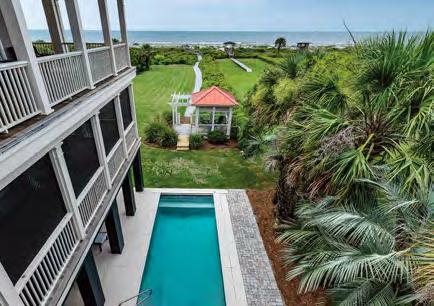
Whether you’re making vacation memories, planning a move, or looking for an investment... Nobody knows the Charleston Coast better.®



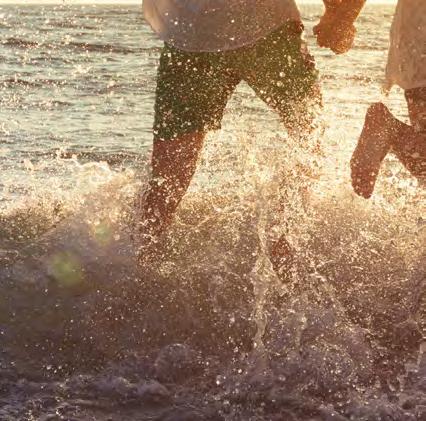

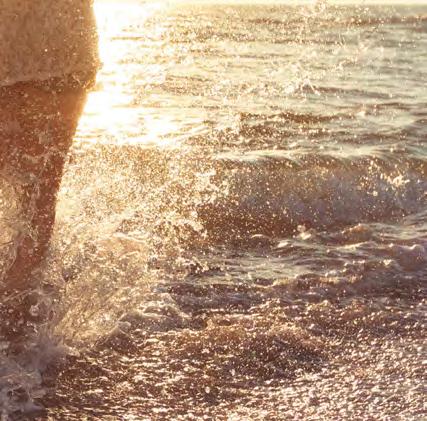

















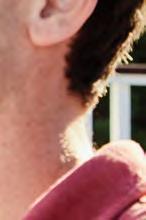



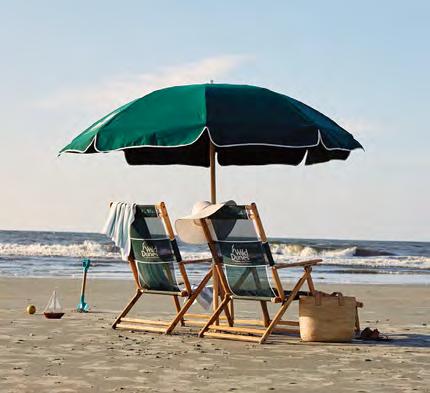













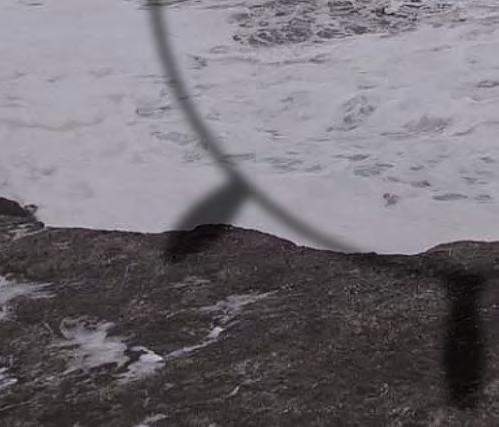





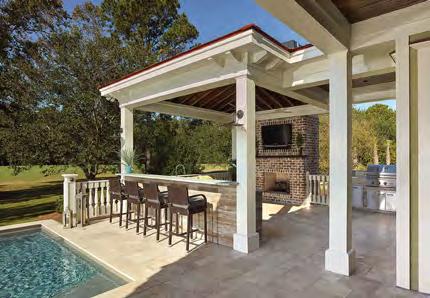










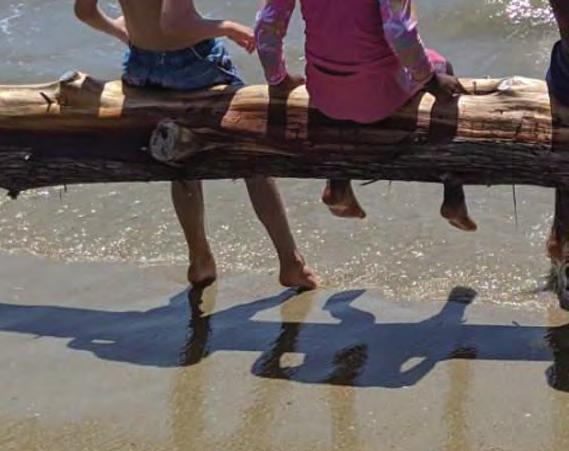







Consider Dewees Island. Experience the wild and unspoiled beauty of the Lowcountry. Protected as a nature preserve, the timelessness of Dewees will be preserved for generations to come.

76 | PANDEMIC PIVOTS
How six islanders adjusted to the COVID19 pandemic and came out stronger, wiser, and incredibly grateful for their coastal community.
By Kinsey Gidick
84 | THE GATHERING PLACE
Redfishing and breeze-shooting at the Isle of Palms Marina
By Hastings Hensel
92 | NO BONES ABOUT IT
Meet Dr. Kathy Reichs, a forensic anthropologist and academic turned New York Times bestselling crime writer. By Jennifer Pattison Tuohy
98 | TWENTY YEARS OF ART ON THE ISLAND
Discover how Julie Cooke turned a vacation into a career running Sullivan’s Island’s only art gallery.
By Carol Antman
GUIDE
22 | WATCH FOR WILSON’S
Meet the tiny shorebirds whose Oscarworthy antics are a unique survival tool.
By Judy Drew Fairchild
26 | THE MARITIME FOREST’S MEDICINE WOMAN
Botanist April Punsalan takes us for a walk through Sullivan’s Island’s very own herbal pharmacy.
By Zach Giroux
30 | STINGING SENSATION
Learn about the jellyfish that frequent our beaches and discover why Portuguese Man-of-War deserve your attention.
By Kinsey Gidick
HISTORY SNAPSHOT
34 | PLACING THE PESTILENCE HOUSES
New research reveals more about Sullivan’s Island’s four pest houses and their role in the forced exodus of West Africans to the New World.
By Brian Sherman
38 | FORE SCORE AND ONE GOLF COURSE AGO
Nearly 100 years ago, the Army built a golf course on Sullivan’s Island to provide officers and enlisted men with some R&R. Where did it go?
By Brian Sherman
ISLAND LIFE
Explore what makes life on our islands spectacular places to visit and special places to live
34 | A TIMELESS CRAFT THAT’S STILL ADRIFT
Explore the nautical pastime of wooden boats, a Southern staple that lives on for a small crowd of aficionados on the islands.
By Zach Giroux48 | PRESERVING ISLAND LIFE
Father Lawrence McInerny sat down with the Battery Gadsden Cultural Center to tell the tales of his family’s four generations on the island, helping keep our history alive.
By Kinsey Gidick
SIP SALUTES
Dive into the local personalities that make our islands so unique
54 | LIVES OF SERVICE
Jerry and Cheryl Kaynard are dedicated to improving and helping those less fortunate.
By Colin McCandless
60 | FOLLOW THE LEADER
Sullivan’s Island Elementay School’s crossing guard is inspired by faith to serve as a community ambassador. By Colin McCandless
64 | MEET SULLIVAN’S UNOFFICIAL MAYOR
Every community needs a welcome committee, and on Sullivan’s that job belongs to Leo Fetter.
By Marci Shore
68 | ‘WE’RE SULLIVAN’S ISLANDERS’
Born and raised on Sullivan’s Island, 92-year-old Doris Lancaster looks back on a life full of sand spurs, smiles, and soldiers.
By Marci Shore




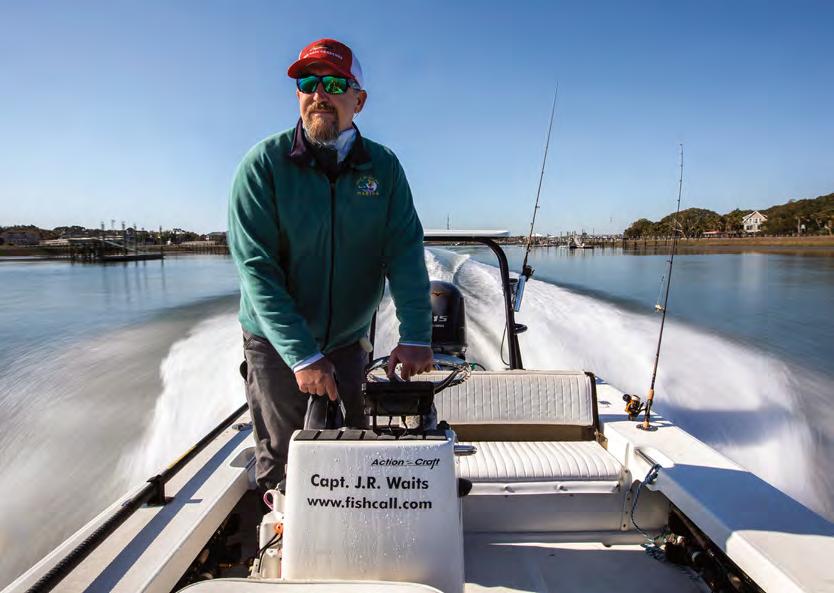






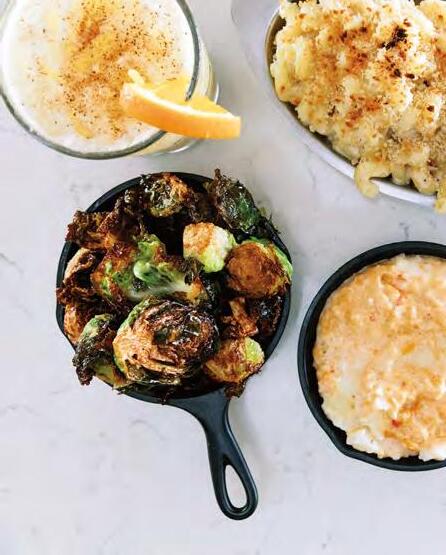
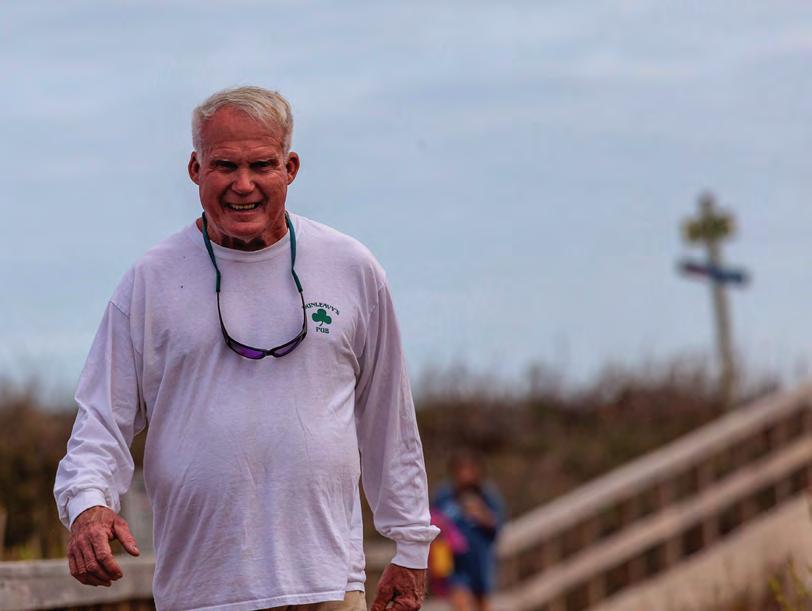



e rising tides of creators and companies new on the scene
106 | NOT YOUR AVERAGE JOE
Ann Hutson and Kevin Hartley on their budding coffee pod business.
By Meghan Daniel
108 | CARVING OUT A BUSINESS
William Rocco and Brock Webb open up a woodworking shop in their spare time. By Meghan Daniel
110 | PROMISE AND PUPS
Amy Scarella has dedicated her life to rescuing last chance dogs.
By Meghan Daniel
A er you’ve soaked up the sun, explore other activities islanders enjoy in their downtime
112 | ON THE PLUS SIDE
The main dish isn’t the only star at island restaurants. These sides often steal the spotlight.
By Stephanie Burt
120 | CHEERS TO THESE
Five local bartenders reveal the best beachside cocktails to sip this season.
By Margaret Pilarski
126 | VIBES & VOCALS
Who, what, and where of live music venues on the islands—there’s more t han enough to go around
By Marci Shore
128 | SIP CALENDAR
Your essential guide to island events
This past year has been one for the history books, as they say. But in any time of turmoil you can nd triumph in the face of adversity and hope in the sight of struggle. In our main feature story, in this the seventh annual issue of SiP magazine—which celebrates life on the beautiful barrier islands of Sullivan’s, Isle of Palms, Dewees, and Goat—we sought to tell some of those stories.
Pandemic Pivots (page 76) explores six islanders’ personal and professional struggles through the challenging landscape of the last 18 months. Most of all it reveals how very important their island community was to each of them in helping them make it through.
Community is o en a key to success, which is something that shines through in our story on the Isle of Palms Marina (page 84), a true gathering place built by the people of the island for the people of the island. On Sullivan’s it was the community of artists that helped Julie Cooke create an art gallery out of a sandwich shop that—to everyone’s surprise, including her own—is still going strong two decades later. Read the story of Sandpiper Gallery in 20 Years of Art on the Island (page 92). en meet one of our islands’ most fascinating authors in No Bones About It (page 98), an interview with Dr. Kathy Reichs whose 20th Temperance Brennan crime novel is released this July.
Also within the magazine, we celebrate some of the people who make our islands a community. From Jerry and Cheryl Kaynard who strive tirelessly through their political and legal work to make life better for those less fortunate and Walter Sherrill who is responsible for the safety of our children every morning as they walk to school, to Leo Fetter, the friendliest man on Sullivan’s, and Doris Lancaster, one of the last, original islanders.
SiP’s mission is to celebrate our communities, and we hope that reading these stories will remind you what a wonderful community you are a part of… whether you’re here for a few days or for a lifetime.
Jennifer Pattison Tuohy Editor-in-Chief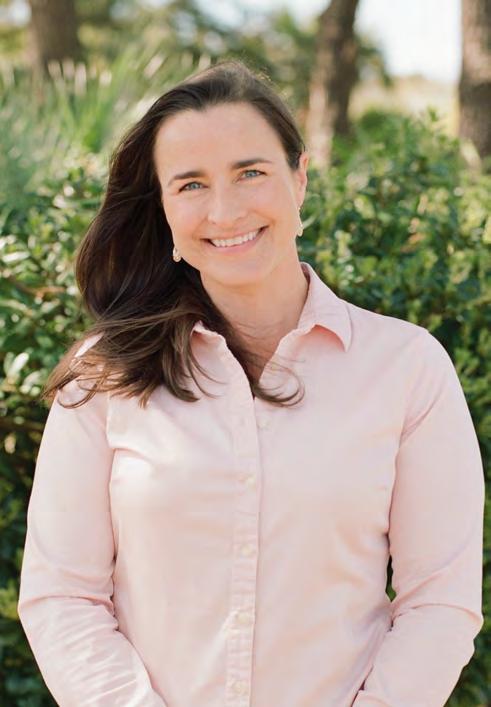
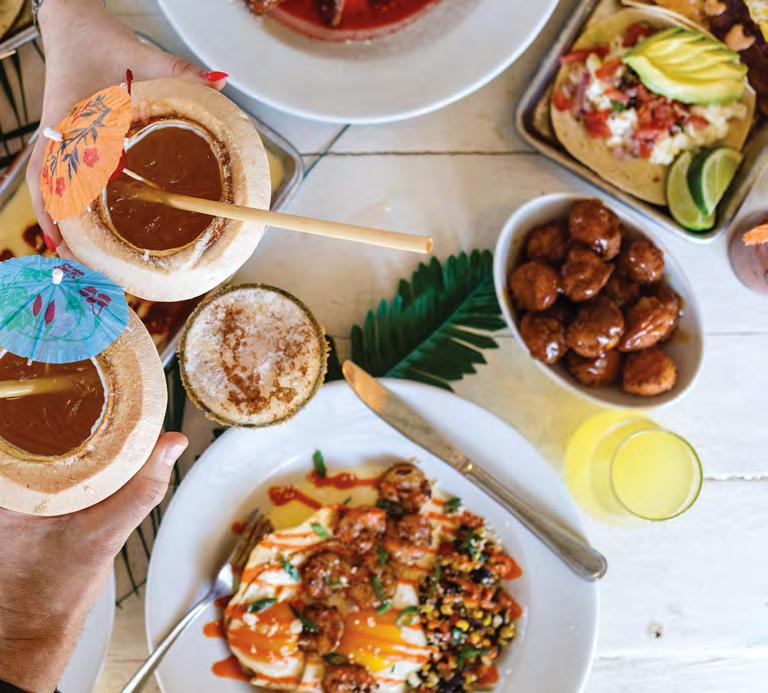





Lynn Pierotti Publisher
Jennifer Tuohy
Editor-in-ChiefAlejandro Ferreyros
Art Director
Kinsey Gidick
Deputy Editor
Rob Byko
Photographer
Swan Richards
Ad Designer
Lori McGee, Marci Shore
Advertising Executives
Contributors
Carol Antman
Michael Barnett
Stephanie Burt
Meghan Daniel
Josie Derrick
Judy Drew Fairchild
Zach Giroux
Minette Hand
Hastings Hensel
Colin McCandless
Vincent J. Musi
Margaret Pilarski
Hector Salazar
Brian Sherman
Marci Shore
Mic Smith
Mark Stetler
www.sipmagazinesc.com
Instagram / Facebook @SiPMagazineSC
About SiP
SiP magazine is published annually by Lucky Dog Publishing, LLC., 2205 Middle St., Sullivan’s Island, SC. SiP is mailed to all property owners on Sullivan’s Island, Isle of Palms and Dewees Island, and distributed free at select locations.
Contact SiP
tel. 843.886.6397
mailing address: po box 837 Sullivan’s Island, SC 29482 for editorial inquiries jennifer@luckydognews.com for advertising inquiries lynn@luckydognews.com www.luckydognews.com
Cover Photo by Michael Barnett
Copyright 2021
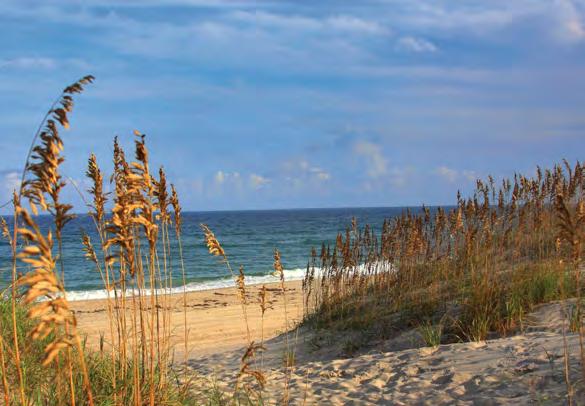


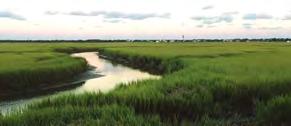
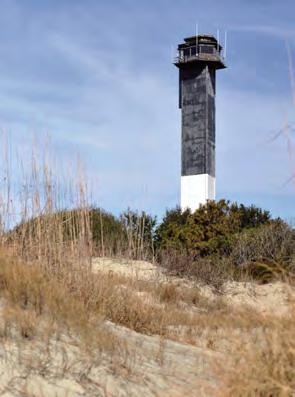


Carol Antman is driven by creative curiosity. Her passion for travel has led to living on a kibbutz, hitchhiking the Pan American highway, vagabonding in Europe and Central America, and camping throughout the U.S. She now lives on Sullivan’s Island and as a travel writer, she is inspired by the idea that everyone has a story.
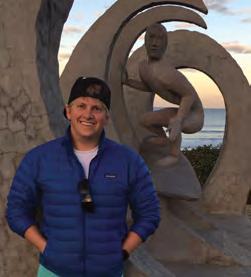
Michael Barnett grew up in the Lowcountry, spending his childhood exploring the marsh behind his house, surfing the beaches, and going to grade school in downtown Charleston. He has traveled extensively, documenting it from an early age. He shares his love for wildlife through his work as a photographer on Instagram @ TheMilkyWayChaser.

Stephanie Burt is the host and producer of The Southern Fork podcast and a writer based in Charleston. She is a frequent contributor to Saveur and her
work has appeared in numerous other publications, including The Washington Post, CNN's Parts Unknown, Conde Nast Traveler, and Atlas Obscura

Rob Byko is a photographer and Realtor at Byko Realty, an agent of ERA Wilder Realty. An environmentalist at heart, Rob hopes his art inspires a protective spirit in others. Rob and his wife Karen live on Sullivan’s Island with their two rescue boxers.
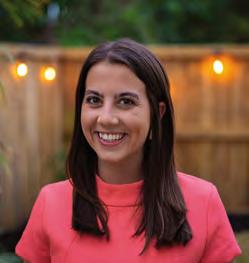
Meghan Daniel is a South Carolina native and graduate of Wofford College with a passion for storytelling. She lives in Mount Pleasant where she is pursuing a career in journalism or communications. Through writing for The Island Eye News, Meghan has developed a fond familiarity with the islands.

Josie Derrick is a lifestyle and brand photographer calling the Lowcountry home. She works with makers, creatives, and small business owners to tell their stories.

Judy Drew Fairchild is a Coastal South Carolina Master Naturalist and former middle school teacher who loves teaching and learning about the natural world. She’s served on the Board of Directors of SC Audubon, the Dewees Island Conservancy, and the Lowcountry Biodiversity Institute. She lives full-time on Dewees Island.
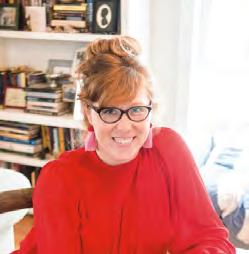
Kinsey Gidick is a freelance writer and frequent contributor to Charleston Magazine, Garden & Gun, and Romper.com. Her work has also appeared in Alaska Air Magazine, The Washington Post, McSweeney’s, and The New York Times

Zach Giroux is a journalist for several Lowcountry publications, who transplanted to Charleston from a small town in Vermont. He is a general assignment reporter who covers all things from breaking news to community lifestyle pieces.
Minette Hand is an author and photographer specializing in

interior and portrait photography. Her most recently published book Present, In This Way, covers a roundtrip photo adventure from the East Coast to Montana and Wyoming. It can be found locally as well as on her website minttehand.com.
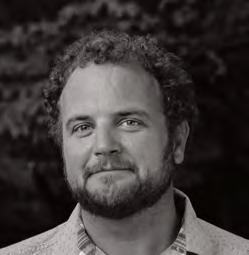
Hastings Hensel is a freelance writer and teaches writing at Coastal Carolina University. He is the author of two poetry collections— Ballyhoo and Winter Inlet —and a graduate of Johns Hopkins and Sewanee. He lives with his wife, Lee, and their dog, Huck, in Murrells Inlet.

Colin McCandless is a freelance writer based in West Ashley. He has extensive experience writing for magazines and newspapers and developing online content. He writes for Charleston Magazine, Charleston Style & Design, HealthLinks Magazine, and Metro Magazine, among others.
Margaret Pilarski grew up around the country but has lived in Charleston for over a decade now. Her editorial work

frequently features artists, activists, educators, and entrepreneurs. When she’s not exploring the islands for SiP, she directs brand strategy and content at Outline, a creative studio.

Hector Salazar has three decades in the video/ photography business. He works with mid to large-sized companies as well as high profile VIP's. His company MeanStream Studios prides itself on making its clients' vision reality. See his work at meanstreamstudios.com.

Brian Sherman is a freelance writer, editor and graphic designer. A native of Philadelphia, he graduated from Memphis State University and landed in the Lowcountry the day before 9/11. Back when he had a real job, he was the editor of three different newspapers and a national magazine. He lives in Mount Pleasant with his wife, Judy, and their dachshund, Jelly Bean.
Marci Shore has lived in the Lowcountry for 11 years and has written for SiP since

2015. A Sullivan's local, she is owner of Ma’ Formulas Hemp Topicals, an agent with Sand Dollar Real Estate, and a singer/songwriter, fiddler with various local bands.

Mic Smith was thrilled to capture the people and activities around the Isle of Palms Marina with his camera, given it's one of his happy places. An Isle of Palms resident for a quarter century and an active boater for nearly a decade, Smith often launches from the marina, and otherwise loves to stop by for treats and conversation.

Mark Stetler has worked as a photographer for twenty plus years. Born in Cleveland, he studied photography at the Art Institute of Atlanta, moving to New York in 1993 to attend NYU. While in New York he assisted many of the world’s most respected photographers, such as Mary Ellen Mark and Richard Avedon. He currently shoots for clients worldwide while based on the Isle of Palms.


Meet the tiny shorebirds whose Oscar-worthy antics are a unique survival tool.
Story and photos by Judy Drew Fairchild
You may be familiar with the sight of small sanderlings that run with their feet in the waves, but there is a sandpiper-like bird that hides in plain sight right on the beach. Wilson's Plovers, Charadrius wilsonia , are small stocky shorebirds with an erect posture and a ringed neck, and they nest right on the ground in the dunes and overwash areas of the beach. You might nd them standing on dri wood watching you and making a peeping call, or you might encounter one that seems to be hurt, dragging a broken wing in the sand.

Watch where you step, especially if you are in the dunes where there are natural grasses or lots of tiny shells.
Stay closer to the water than the dunes, especially in the heat of the day.
Time your walk for low tide, especially if you have a dog with you: it gives nesting birds more room to roam the beach.
Leash your dog. Even leashed dogs can decrease bird diversity by 50 percent because birds don't understand that the dog is not a predator. Unleashed dogs chase birds by instinct and can harm the tiny shorebirds unintentionally.
If you see a bird faking an injury, freeze in place and carefully back out of the area.
For more information and to see Judy’s Wilson's Plover Nature Walk video go to naturewalkswithjudy. com/2020/05/11/wilsons-plover/




Long-time Dewees Islander, former middle school history teacher, and South Carolina Master Naturalist, Judy Drew Fairchild, has used some of her time in quarantine on Dewees to create a series of nature videos. A welcome distraction in these trying times, the project combines Judy's gift for teaching, love of nature, and passion for conservation. It is a love letter to the natural diversity of the Lowcountry.
The videos, “Nature Walks with Judy,” are designed to spark interest, engage curiosity, and, through knowledge and understanding, invite people to care about conserving nature in their own backyards. Each video is about one minute in length, making it ideal for all ages and combines Judy’s fabulous photography and unique videos with her bountiful knowledge.
The topics of these videos move from birds and trees to the wonders you can find in tidal pools, prompting you to look up and look down and find a new fascination in the natural world all around you. “There are tiny miracles taking place around us all the time, if we stop and look,” says Judy. “My goal is to get people to notice those, and grow to love the nature around us. Once you love something, you’ll be more invested in protecting it.”
Go to www.NatureWalksWithJudy.com to watch the videos and to connect with Judy on social media.
— Carey SullivanOpposite page: From top, a Wilson’s Plover on its nest; the uncovered eggs; a Plover and its chick foraging for food. Below: A young Wilson’s Plover ventures out.

Living only in southern coastal areas, with a particular penchant for barrier islands, Wilson’s Plovers nest on South Carolina beaches through the spring and summer. ese brown and white birds, who are named a er the Scottish-American ornithologist Alexander Wilson, feed on ddler crabs and choose open areas of sandy islands and inlets to lay their eggs, o en near dune edges.
Nesting season begins in late April and is usually nished by mid-July. South Carolina has approximately 375 pairs of nesting Wilson's Plovers and the bird is listed as state-threatened. ey are in decline because so much of their habitat is crowded with beachgoers. Additionally, warming temperatures in the spring pose a danger to chicks in the nests.
Wilson’s Plovers don’t build nests from sticks; rather they lay their speckled eggs directly on the sand and crushed shell. When the eggs hatch, the young birds are adorable balls of u that can run within hours of hatching, seeking shelter under their parents wings or freezing in place right on the sand. Nests and chicks can be almost impossible to see on the beach, making humans the major threat to this species.
When nesting adults perceive a threat, they may jump o their nest and fake a broken wing in an attempt to lure the “predator” away from a nest or youngsters. Unfortunately, eggs and chicks can bake in the hot sun in a few short minutes.
If you see a bird that looks like it’s injured, and it is peeping at you and trying to get your attention, look closely—there is probably a nest with eggs or chicks nearby. Freeze and retreat carefully so as not to step on chicks or eggs. e next time you’re at the beach, keep an eye out for these tiny friends, and give them lots of space.


Botanist April Punsalan takes SiP for a walk through Sullivan’s Island’s very own herbal kitchen.
By Zach Giroux Photos by Rob Byko
Scan this QR code to see a video of April Punsalan and SiP Publisher Lynn Pierotti on a medicinal walk through the Maritime Forest.
When April Punsalan walks through the Sullivan’s Island Maritime Forest at the Station 16 beach access path, she uses it di erently than most beachgoers. She shops the ora with a basket in hand as if she were at the Farmers’ Market.
A botanist, ethnobotanist, herbalist and self-proclaimed “plant whisperer,” Punsalan specializes in the study of edible and medicinal properties that plants hold. Her passion for foraging stemmed from a desire to protect plant diversity from a young age, which has sprouted into a lifetime pursuit for free herbal remedies that can be found in nature’s bounty.
Punsalan’s top-five most medicinally beneficial plants that can be found in the Maritime Forest

Yaupon (Ilex vomitoria)
Use - Caffeinated tea
How to apply - Tea
Native - Southeast Coastal Plain
Where it grows - Maritime forests

Eastern Red Cedar (Juniperus virginiana)
Use - Antimicrobial (relieve a sinus infection)
How to apply - Steam facial, incense/smudge
Native - Eastern United States
Where it grows - Maritime forests, old fields, roadsides


Wax Myrtle (Morella cerifera)
Use - Astringent and diuretic
How to apply - Tea and bath
Native - Endemic to the Southeastern Coastal Plain
Where it grows - Maritime forests, pocosins, marshes

Carolina Willow (Salix caroliniana)
Use - Anti-inflammatory, Fever Reducer
How to apply - Tincture, tea/decoction
Native - Southeast Coastal Plain
Where it grows - Interdune ponds, riverbanks, sandbars


Spanish Moss (Tillandsia usneoides)
Use - Anti-inflammatory
How to apply - Make a decoction for the bath
Native - Southeastern Coastal plain
Where it grows - On branches of trees
For more information about Punsalan’s teachings, herbal recipes, infusions and decoctions for all ages, visit courses.yaholaherbalschool.com/courses/foragenow.
Punsalan’s a nity for plants evolved during a horticulture class at her high school in Norfolk, Virginia. She would go on to become president of the Future Farmers of America and compete in state fairs with selfmade herbal soap and shampoo at the age of 16. A erward, Punsalan got her master’s in botany from Western Carolina University and worked for the U.S. Fish and Wildlife Service.
A er immersing herself in the eld for the past 24 years, Punsalan decided it was time to enrich the minds of others who share a similar love for plant life. Last August, Punsalan launched Yahola Herbal School to help people connect with the “green friends” one needs for health, vitality and wellness.
Punsalan’s course is called Forage Now but she’s considering changing it to Forage Everyday. For her, foraging is much more than just an act of obtaining nature’s nutrients, it’s a way of life. “ e more that I forage and connect with these plants the more I understand their medicine and how they work on my body and then I can teach you better,” Punsalan says.
When Punsalan teaches people about plants’ medicinal o erings, she purposely focuses on the most common ones and stays away from the rare ones because she is very much a conservationist. She’s also very cautious about using the word heal. Heal is a word that the Federal Drug Administration doesn’t like people such as Punsalan to use when it comes to associating plants and medicine. In terms of selling herbal products, the word “supports” is more appropriate, she says.
Historically, in the late 1800s botanists were medical doctors who would go out and harvest for their patients. Punslan idolizes the work of Francis Peyre Porcher, a well-respected South Carolinian who authored several works on the medicinal properties of plants and joined the Confederate Army as a surgeon during the Civil War. Punsalan credits Porcher for inspiring her to be the “medicine woman” that she is today.
When Punsalan was a child, she su ered from a urinary tract infection. Raised by a single mother of three, her family didn’t have health insurance nor the nancial means to cure it. Punsalan took matters into her own hands and administered a plant called Rattlesnake Master. “I’ve healed myself from things that doctors couldn’t gure out,” Punsalan says. “ ey were still prescribing me antibiotics and I just went out into the forest and harvested something, chewed on a root for a day and it was gone the next day.”
Years later, as a mother, she helped her daughter’s strep throat with herbal remedies. She believes the plants that grow in ecosystems like the Maritime Forest can be more e ective than pharmaceuticals in some cases. Punsalan says that for conditions such as a sinus infection, urinary infection and even kidney stones, she has found that plants can
o er relief similar to generic over-the-counter drugs.
In October 2020, a decade-long legal dispute concerning the Maritime Forest reached a resolution in favor of accepting a settlement that will see more cutting in the forested area. e approved agreement permits the clear-cutting all vegetation within 4 feet of a town-owned beach path, cutting all vegetation in a 100-foot strip next to residences with the exception of mature palmettos, live oaks and magnolias; and limbing mature trees
and removing smaller trees, including cedars, pines and hackberries.
Punsalan is concerned this will provide an opportunity for non-native plant species to overtake native species, due to the exposure of more sunlight. However, she pointed out that it will also increase species’ diversity by creating more openness. “You want spatial and temporal heterogeneity,” Punsalan says. “You want to create patches, so there could be a win-win.”

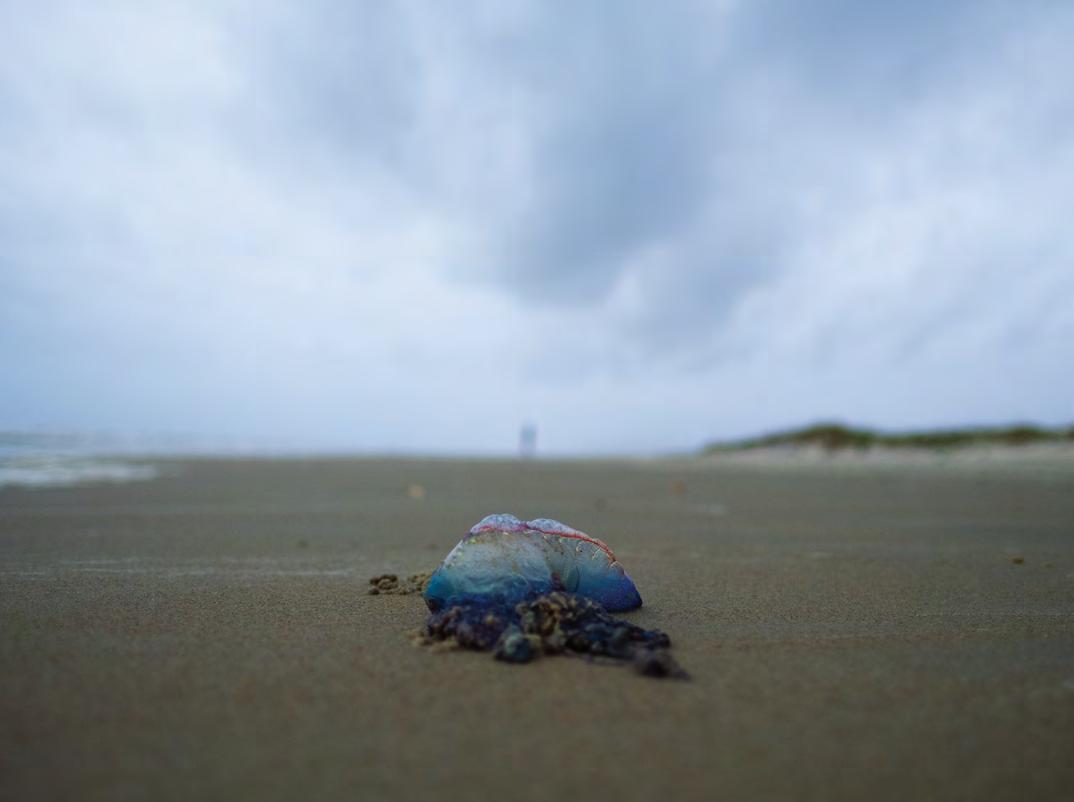
Meet the jellyfish that frequent our beaches and discover why the Portuguese Man-of-War deserve your attention.
By Kinsey Gidick by Michael BarnettDid you know the venom from bees and wasps poses a bigger public health threat than that of jelly sh? And yet jelly sh continue to be vili ed. As lovely as they are to look at from the safety of a place like the South Carolina Aquarium—home to Moon Jellies and Lion’s Main jelly sh—hit the beaches and the welcome isn’t so warm. We’ve been trained to fear these marine animals whose sting can send shivers down the spine of an unsuspecting swimmer.
Also known as jellyballs, these jellyfish are the most common in our area. During the summer and fall, large numbers appear near the coast and in the months of estuaries. Fortunately, while the cannonball is the most abundant jellyfish in the area, it is also one of the least venomous. Cannonballs can be identified by their white bell shape, decorated with rich, chocolate brown bands. They have no tentacle but a gristle-like feeding apparatus.
Mushroom Jelly
The mushroom jelly is often mistaken for the cannonball jelly, but it differs in many ways. The larger mushroom jelly, growing to 20 inches in diameter, lacks the brown bands associated with the cannonball and is much flatter and softer. Like the cannonball, the mushroom has no tentacles. However, it possesses long, finger-like appendages hanging from the feeding apparatus. It doesn’t pose a hazard to humans.
Moon Jelly
Probably the most widely recognized jellyfish, the moon jelly is relatively infrequent in South Carolina waters. It has a transparent, saucer-shaped bell and is easily identified by the four pink horseshoe-shaped gonads visible through the bell. It typically reaches 6-8 inches in diameter, but some are known to exceed 20 inches. The moon jelly is only slightly venomous.
Also known as the winter jelly, the lion's mane typically appears during colder months of the year. The bell, measuring 6-8 inches, is saucershaped with reddish brown oral arms and eight clusters of tentacles hanging underneath. Lion’s manes are moderate stingers.
Frequently observed in South Carolina waters during summer months, the sea nettle jellyfish is saucer-shaped with brown or red pigments. It is usually 6-8 inches in diameter, with four oral arms and long marginal tentacles hanging from the bell. The sting of a sea nettle is considered moderate to severe and may be described as burning rather than stinging.
Known as the box jelly because of its cube-shaped bell, the sea wasp is the most venomous jellyfish inhabiting our waters. Its potent sting can cause severe dermatitis and may even require hospitalization. Sea wasps are strong swimmers reaching 5-6 inches in diameter and 4-6 inches in height. Several long tentacles hang from the four corners of the cube. A similar species, the four-tentacled Tamoya haplonema, also appears in our waters.
The Portuguese Man-of-War is not a "true" jellyfish. It typically inhabits the warm waters of the tropics, sub-tropics and Gulf Stream, but wind and ocean currents can propel them into nearshore waters of South Carolina.
Information courtesy SC Department of Health and Environmental Control. Photos courtesy of the South Carolina Aquarium.

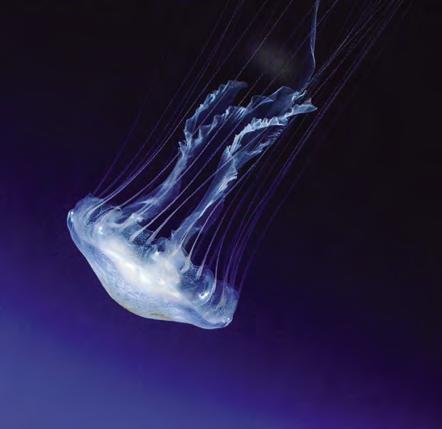
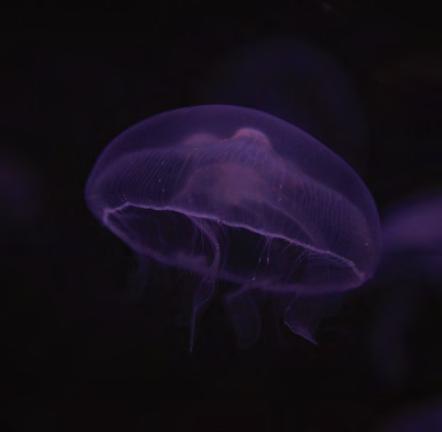


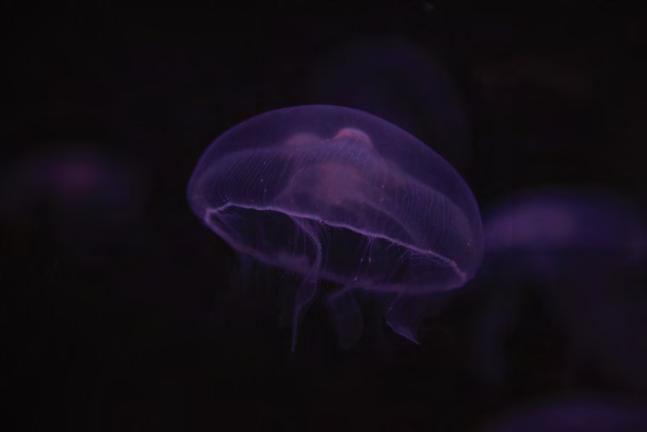


The average jellyfish sting can be easily treated with vinegar, says Shannon Howard, a biologist at the South Carolina Aquarium. If a tentacle is stuck on you, do not touch it. Squirt the vinegar on it instead. “What that does is causes the stinging cells to retract, then you can safely remove it with something like tweezers,” she says. She also encourages regular beach swimmers to keep heat packs handy to place on the wound. “A heat pack will help the swelling and pain,” she says.
A Man o’ War sting is a different beast. Howard says that while they’re rarely deadly for humans, it’s best to be extra cautious if stung. It is very painful, and she advises going to the emergency room. “At the very minimum, go to your nearest urgent care,” says Howard, just to be safe.
But Shannon Howard, a biologist at the South Carolina Aquarium, says some of our fear is misplaced. “Yes, it's common to get stung, but it's also common to get stung by a bee and the majority of people are going to have a pretty mild reaction,” says Howard. When it comes to the average jelly sh swimming around the Isle of Palms and Sullivan’s—like cannonball, mushroom, and sea nettle jellies—we can all calm down a bit. “For some people the sting is nothing more than an annoying rash, but for others it is more painful,” she says of their inevitable sting. At worst, unless you’re allergic, you can expect a typical jelly sh sting to last several hours, with welts possibly lingering for a few weeks.
Portuguese Man-of-War, however, deserves your attention. In coastal Carolina the native Man-of-War stirs up all kinds of dramatic headlines each year. at’s because it packs the most painful punch of all our area’s tentacled creatures.
But, get this, it’s not actually a jelly sh. at’s right, a Man-of-War is a complex colony of polyps. ey don’t swim, they’re wind powered and propel themselves via a oat—a bulbous sail that sits above the water. at’s why you see them wash up on the beach a er a big storm or strong current. Even when it’s not windy, however, South Carolina swimmers should learn to identify these venomous
creatures because under that lovely purple oat dangle powerful tentacles. “ ey look like ribbon of curly red and they can be very long,” says Howard. “ irty feet is about the average, but they could be as short as six feet to as long as 165 feet.”
Step on or get swiped by one of those tentacles and you’re not going to be a happy camper. “We always tell people if you see one wash up on shore, or especially if you see one in the water, don't touch it. Do not get in the water,” adds Howard. is is especially important on our coast where the water isn’t clear and you may think you’re swimming in a safe spot when you’re really not.
Respect all jellies and they’ll respect you. SiP



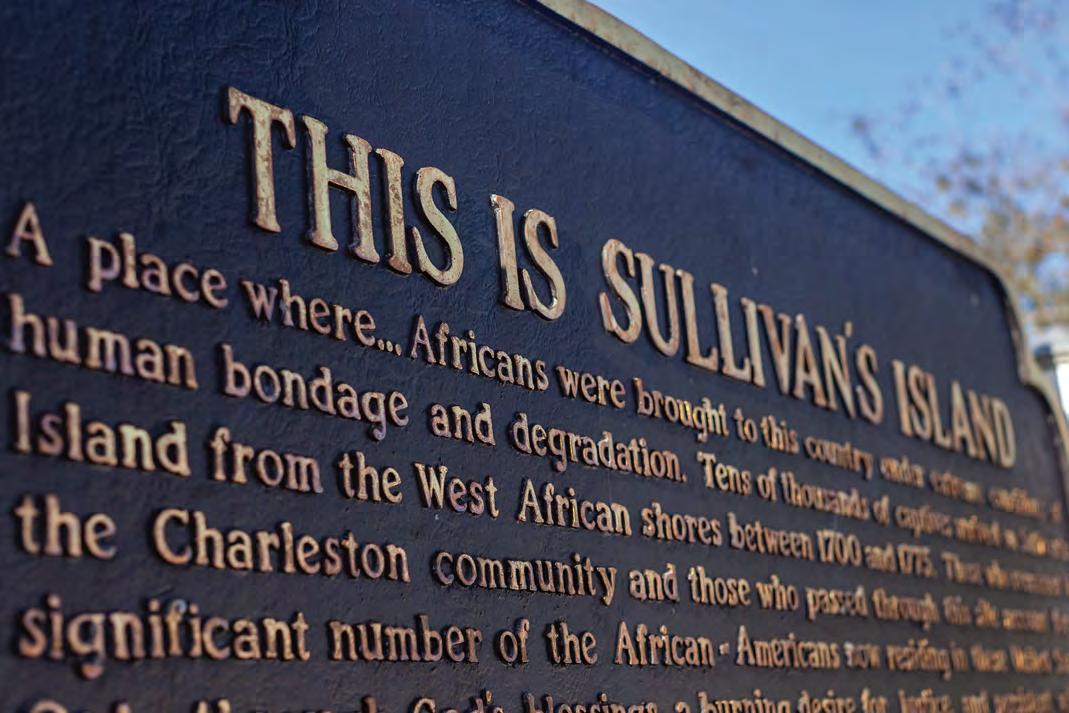
New research reveals more about Sullivan’s Island’s four pest houses and their role in the forced exodus of West Africans to the New World.
By Brian ShermanFor many years, local lore had it that every enslaved African who came to the New World through the port of Charleston rst spent time on Sullivan’s Island. It was thought the pest houses there served as a revolving door for hundreds of thousands of soon-to-be slaves who needed to be quarantined to protect the local population from smallpox, yellow fever, measles and other communicable diseases.
In reality, there is likely a gaping chasm between truth and ction concerning what actually transpired on the mostly uninhabited island between the beginning of the 18th century and the start of the 19th century, when the trans-Atlantic slave trade was abolished by the United States.
“ ere are so many misconceptions,” says historian and Charleston Time Machine podcast host Nic Butler, Ph.D., pointing out that little is known about the exact size or location of Sullivan’s Island’s four pest—short for pestilence—houses. “An idea that’s become popular is that Sullivan’s Island was the rst place Africans touched. at’s true for some but certainly not for all. at’s a story that started in the 1970s,” says Butler. “But the island is important in African American history. I’m not trying to undermine that.”
According to Butler’s research, the island’s four pest houses existed consecutively from 1707 to 1714; 1745 to 1752; 1755 to 1775; and 1784 to 1796. is means that, more o en than not, they weren’t a part of the quarantining process in place in Charleston from 1698 until 1808, when research shows approximately 40 percent of all enslaved people entering North America came through Charleston—between 150,000 and 200,000 people.
Not many people actually spent time in a pest house on Sullivan’s Island. Instead, a large number of those brought to America were quarantined aboard the ships that brought them to the New World. One reason for this, in addition to the fact that during more than half that time there were no pest houses at all, is the buildings were small and unable to accommodate a large number of people at one time.
Butler posits they were maybe capable of housing a dozen or so. In addition, a law that was in force from 1744 to 1784 required all ships carrying Africans to Charleston to anchor in the harbor for 10 days. During this time, a er spending four to eight weeks in dark, dirty quarters aboard a slave ship, many people were taken to Sullivan’s Island for a bath, fresh food, exercise, and new clothes so they would look healthier and bring a higher price once they reached the market in Charleston.
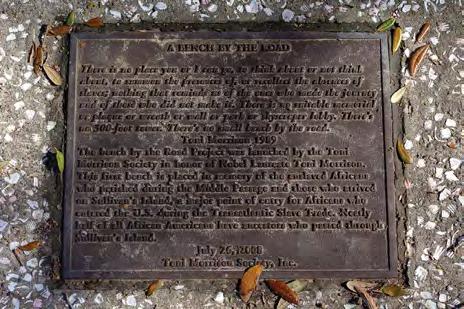
Sullivan’s Island’s role in the African American story
When the International African American Museum opens in Charleston next year, Sullivan’s Island’s role in the journey thousands of Africans endured will be part of the stories told there.
In 1980, when Michael Allen was hired by the National Park Service, the narrative of Africans stopping on Sullivan's Island on their way to being sold into slavery was no more than a small footnote in history. In 2022, the details of their journey will be available for all to see.
Allen helped bring this story to light through exhibits on the Sullivan’s Island pest houses at the Fort Moultrie VNPS Visitor Center. He was also tasked with helping establish a marker commemorating the slave trade near Fort Moultrie, as well as the commemorative Bench by the Road. “I saw the relevancy and importance of a history that needed to be told and brought to life,” Allen says.
The mission of the International African American Museum is to tell the story of “the journey of millions of Africans, captured and forced across the Atlantic in the grueling and inhumane Middle Passage, who arrived at Gadsden’s Wharf in Charleston, South Carolina, and other ports in the Atlantic World. Their labor, resistance and ingenuity and that of their descendants shaped every aspect of our world,” states the museum’s website. “There is a direct tie,” Allen noted. “We live in the Gullah Geechie Cultural Heritage Corridor. Without an acknowledgement of what happened on Sullivan’s, that does not exist.”


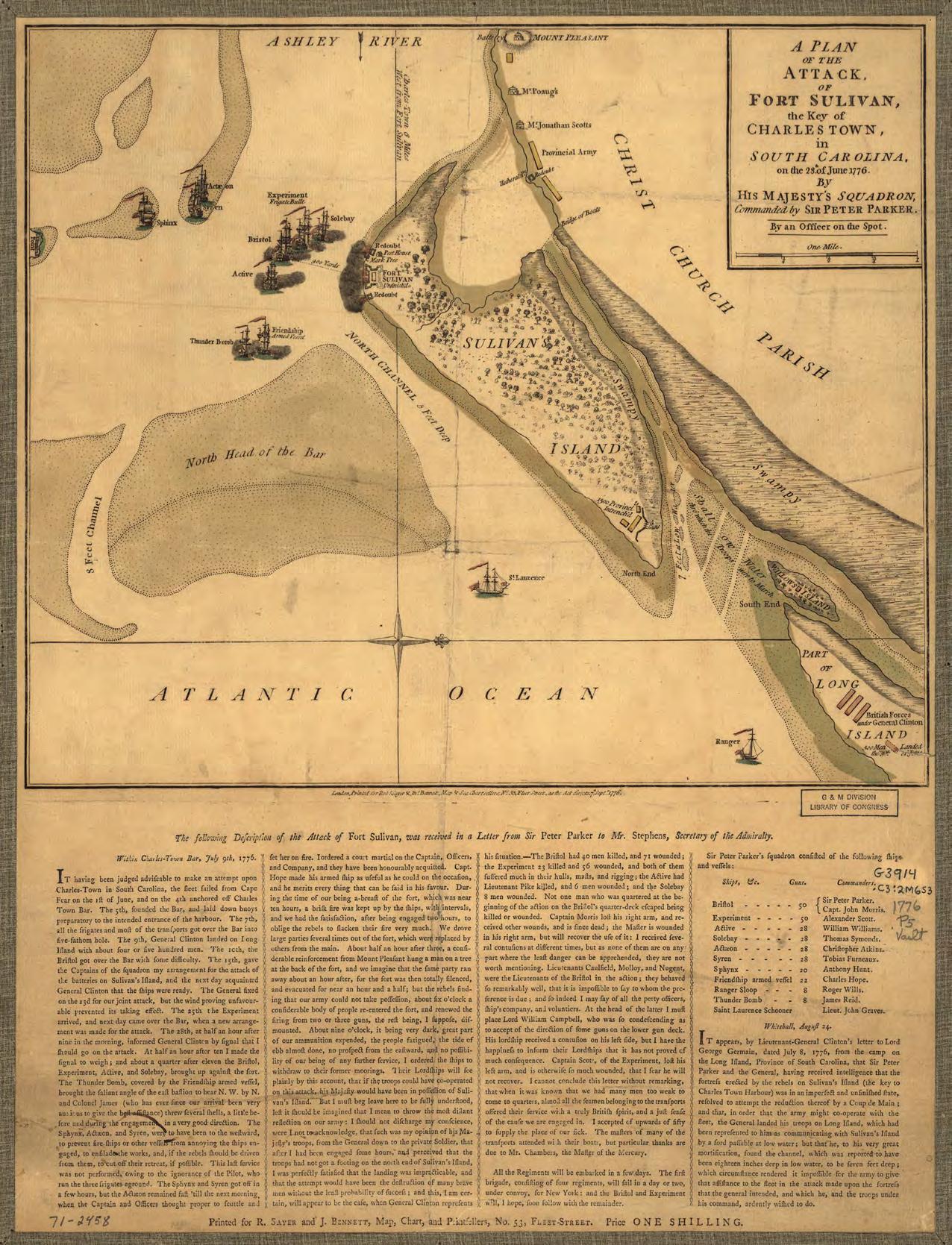

Opposite page: A map drawn in 1776 depicting the Battle of Sullivan’s Island on June 28. In the center (enhanced) is a marker for a pest house. This is the only known map showing its location. (Map courtesy the Library of Congress)
ose enslaved people suspected to be contagious were relegated to a pest house and remained there until a physician—who visited only periodically—decided they were healthy. Or until they died. No graves have been found. “We do not know if there were burial grounds or if bodies were taken to sea and released into the waters,” says Elaine Nichols, curator of culture with the Smithsonian National Museum of African American History & Culture in Washington, D.C.
Historian Michael Allen, a former employee of the National Park Service and the driving force behind the creation of the Gullah Geechee Cultural Heritage Corridor, says that based on the customs of the time, “they were most likely thrown into the harbor.” Butler says there are no records describing three of the four pest houses, though it is known that a facility destroyed by a hurricane in 1752 was a windowless, four-room brick building. “It was just a shell with a roof and probably cots and replaces,” Butler says. “It wasn’t a comfortable place. It was in some respects a death house or a continuation of being in the hull of a ship,” Allen adds. “It wasn’t a medical center. It was just to hold the cargo. At the end of the day, those people were just a part of the manifest of that ship.”
e experts disagree on what became of Sullivan’s Island’s four pest houses and where they stood. Allen suggests they were in locations that now are underwater in Charleston Harbor, while Butler believes the last pest house was converted into a restaurant. According to Nichols, the property where Grace Episcopal Church once stood on Station 14 was sold to the church near the end of the 18th Century, so could have been one location.
Regardless of where the pest houses were located, Nichols points out that legend, and even some historians, have misrepresented their main purpose. She said state law required the pest houses to be maintained to house enslaved Africans and contain the diseases they supposedly were bringing from across the Atlantic Ocean. However, local medical and governmental leaders and private citizens were more concerned about their safety than about race. She believes whites as well as Blacks spent time in pest houses.
“ e reality was that the people of Charleston recognized the certainty that they were just as likely to die of contagious diseases from white passengers from domestic or international ports of call as from diseases from Africa,” she says. “In the end, survival and not race determined who was placed into quarantine on Sullivan’s Island. If a person had smallpox, yellow fever, or measles, they wanted those persons placed in isolation so that they would not spread the diseases.”
“Charlestonians’ fear of diseases borne by Africans may have been the impetus for building pest houses on Sullivan’s Island, but what motivated them to place people in quarantine was the presence or potential presence of deadly diseases,” she adds. “Pest houses were used for the isolation of all racial and ethnic groups.” Her extensive research has not uncovered any instance of segregation based on race at Sullivan’s Island’s pest houses.
As the trans-Atlantic slave trade diminished and nally died in the early 19th century, memory of Sullivan’s Island’s pest houses faded as well into the deep, dark and mysterious corners of unwritten history. e legend found new life 165 years later, but much of the story still remains a mystery.

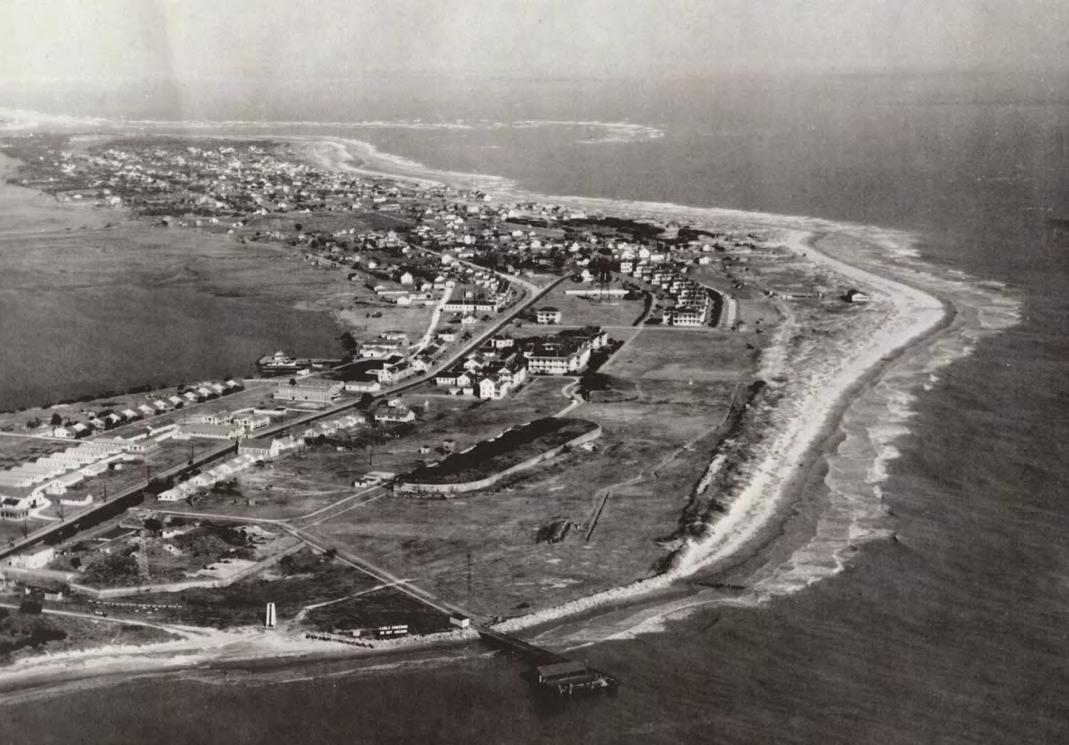
Nearly 100 years ago, the Army built a golf course on Sullivan’s Island to provide its officers and enlisted men with some R&R. Where did it go?
By Brian ShermanWherever you are in South Carolina, you don’t have to go far to play golf. But with more than 360 courses in the Palmetto State, you’d still be out of luck if you wanted to spend a pleasant Lowcountry a ernoon honing your driving skills or perfecting your short game on Sullivan’s Island, known more for its place in American history than for its lush fairways. at wasn’t always the case, though we don’t know for sure if undulating putting surfaces and di cult-tonavigate hazards were ever in play on Sullivan’s Island.
We do know that from the early 1930s until the U.S. Army lowered Old Glory at Fort Moultrie for the nal time in 1947, there was a golf course on the island that provided exercise and healthy competition among o cers and enlisted men alike. Women played there as well, as did civilians from area country clubs.
“PFC
Joseph M. Chevis was the course professional and greenskeeper. When he wasn’t taking care of his military responsibilities, he gave golf lessons, 50 cents for a half hour of instruction.
Not much is known about the course; even its number of holes is in question. According to Dawn Davis, public a airs o cer with the National Park Service, the course’s footprint ran from the current location of the Sand Dunes Club to Battery Jasper. e building that doubled as the golf shop and caddy house was located near the current intersection of Poe Avenue and Artillery Drive. And the layout of the course? Davis says the area doesn’t appear to be large enough for 18 holes, “but newspaper articles refer to 18 holes being played, so I would guess just nine.” However, in a 2013 thesis titled “Remembering the Legacy of Coastal Defense: How an Understanding of the Development of Fort Moultrie Military Reservation, Sullivan’s Island, South

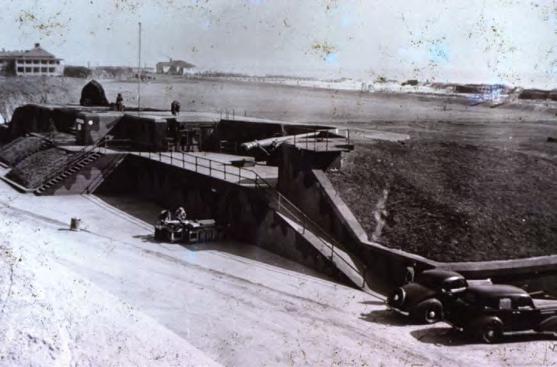

Above: These photos of Battery Jasper (top) and Battery Logan (middle) show various angles of the presumed location of the golf course on Sullivan’s Island. The golf shop and caddy house (bottom) was a 144-square foot building with a 256-square foot porch. It was completed in November, 1938. (Photos courtesy The National Park Service)

Opposite page: A notice from 1941 regarding the golf course on Sullivan’s Island that was built in the early 1930s. (Courtesy The National Archives)
Carolina, Can Facilitate its Future Preservation,” Karl Philip Sondermann presented a di erent opinion. “With post expansion, golf club membership rose, enabling the construction of a one-hole golf course. Its fairway was in front of Battery Logan and its circular green placed in front of Battery Jasper,” his thesis pointed out.
According to newspaper clippings from the 1930s, the winning scores in tournaments and matches were in the 70s and 80s, so it’s logical to assume that golfers actually played 18 holes. Did they tee o from 18 di erent locations to a single green? e answer to that question might be buried in the annals of Lowcountry golf history.
e names of some of the better Fort Moultrie golfers of the 1930s are recorded in local newspaper articles. Sgt. Walter Mueller, eodoro Ciacoasa, Maj. Charles S. Johnson, Maj. Richard T. Edwards and Sgt. H.F. “Gabby” Hudson all won tournaments on the course, and trophies were captured by Maj. A.A. McDaniel, Lt. Moses Alexander, Mrs. Frederick R. Keller, Mrs. R.T. Gibson and Mrs. omas T. May. Johnson was credited with a hole-in-one on the course’s second hole. e newspaper also reported that Fort Moultrie golfers defeated a group from the Country Club of Charleston, but a few days later lost to the same team at the Wappoo course.
Questions about the course itself remain, but we do have a pretty good idea about the golf shop and caddy house and even a photo of the building. According to Army paperwork the 144-square-foot building—with a 256-square-foot porch—was completed on Nov. 5, 1938. It was equipped with electricity and water and sewer connections and was built with salvaged materials.
A “Golf Notice” released by Maj. S. J. Adams on March 4, 1941, detailed that o cers were entitled to use the golf course for free, while enlisted men could play for a fee of $1 per year, as long as they could demonstrate to a member of the Enlisted Men’s Golf Committee, “their knowledge of the game, including proper use of clubs and the rules and etiquette of the game, with a view to safeguarding the course through proper usage of the tees, fairways, sand traps and greens.”
e committee included Mueller, Sgt. Claude L. Lynch and PFC Joseph M. Chevis. e letter designated Chevis, a golf pro in civilian life, to be the course professional and greenskeeper. When he wasn’t taking care of his military responsibilities, he was permitted to give golf lessons, charging up to 50 cents for a half hour of instruction.
So, what happened to the golf course a er the military packed up and le Sullivan’s Island shortly a er the end of World War II? “We do know that the area in front of Jasper was le to grow wild pretty quickly a er the war, and then development on Sullivan’s Island took care of the rest,” Davis explains. “So, probably by the very early 1950s, the area was developed over.”



VEHICLES WITH LARGE SEATING CAPACITY STREET LEGAL FOR DAY OR NIGHT
APPROVED FOR RENTAL WITHIN WILD DUNES, KIAWAH & SEABROOK 25MPH/SEATBELTS PROVIDED




Wooden boats on Lowcountry tides go together like pimento cheese on bread. The nautical pastime is a Southern staple that lives on for a small crowd of aficionados on the islands.
By Zach GirouxThe “Sappho” is Hal Coste’s 1958 Simmons Sea Skiff. At 18-feet long, with a marine plywood and mahogany finish, this sturdy and lightweight boat was designer for a fisherman or to be an Army engineer’s workboat.
Hal Coste is one of the fortunate ones. A Sullivan’s Islander, Coste is a semiretired residential contractor and carpenter, and he’s also an award-winning wooden boat builder.
With all the modern materials available to make a boat, wood is chosen time and time again. Working with wood is well within the means of most people, the material is relatively easy to obtain and it’s not as labor intensive as other options. Built right, wooden boats are very strong, lightweight and do not fatigue. But for Coste, it’s a hobby, not a matter of business. Although, judging by his lineage, it appears the cra runs in the blood or atop the waves.
Coste hails from a long line of sea captains. His grandfather, Vincent O. Coste, was skipper of the local Coast Guard station. Vincent served in the U.S. Lifesaving Service, which joined with the Revenue Cutter Service in 1915 to form the U.S. Coast Guard.
His great-great grandfather, N. L. Coste, arguably committed one of the rst acts of piracy in the Civil War. He was not a swashbuckler but rather he commandeered the Revenue Cutter William Aiken in the Battle of Fort Sumter in April 1861, seizing the ship for the state of South Carolina. It was admitted as the rst o cial boat in the Confederate Navy.
Coste is no stranger to the water either. A former surfer, today his pride and joy is not a board, but Sappho and Scoota, his two wooden boats. In 2014, Coste heard through a friend about a free eBay listing of an abandoned boat that needed tender love and care. He jumped at the opportunity. Renting a workspace at Barrier Island Boatworks on Pherigo Street in Mount Pleasant and enlisting boat builder Teddy Hu , he got to work stitching and glueing it together. Stitch-and-glue is a simple boat building method that uses plywood panels stitched together, usually with copper wire, and glued together with epoxy resin. “I’m an old square and level carpenter. It’s got to be like that for me, but I learned a lot of lessons,” Coste says of his work on the boat renovation
A er sinking $13,000 of his own money into the endeavor, Coste watched his dream boat come to life right before his eyes. A 1958 Simmons Sea Ski , 18-feet long, green and white with a marine plywood and mahogany nish, he named it “Sappho” a er the ferry that ran between Charleston and Mount Pleasant at the turn of the century, of which N. L. Coste was the skipper.
From 1950 to 1970, Simmons manufactured approximately 1,000 of the Sea Ski s and Coste is fortunate enough to own one of the originals. Sturdy and lightweight, a Simmons boat design



 Sullivan’s Island’s Hal Coste is a semi-retired residential contractor who is also an awardwinning wooden boat builder.
Sullivan’s Island’s Hal Coste is a semi-retired residential contractor who is also an awardwinning wooden boat builder.
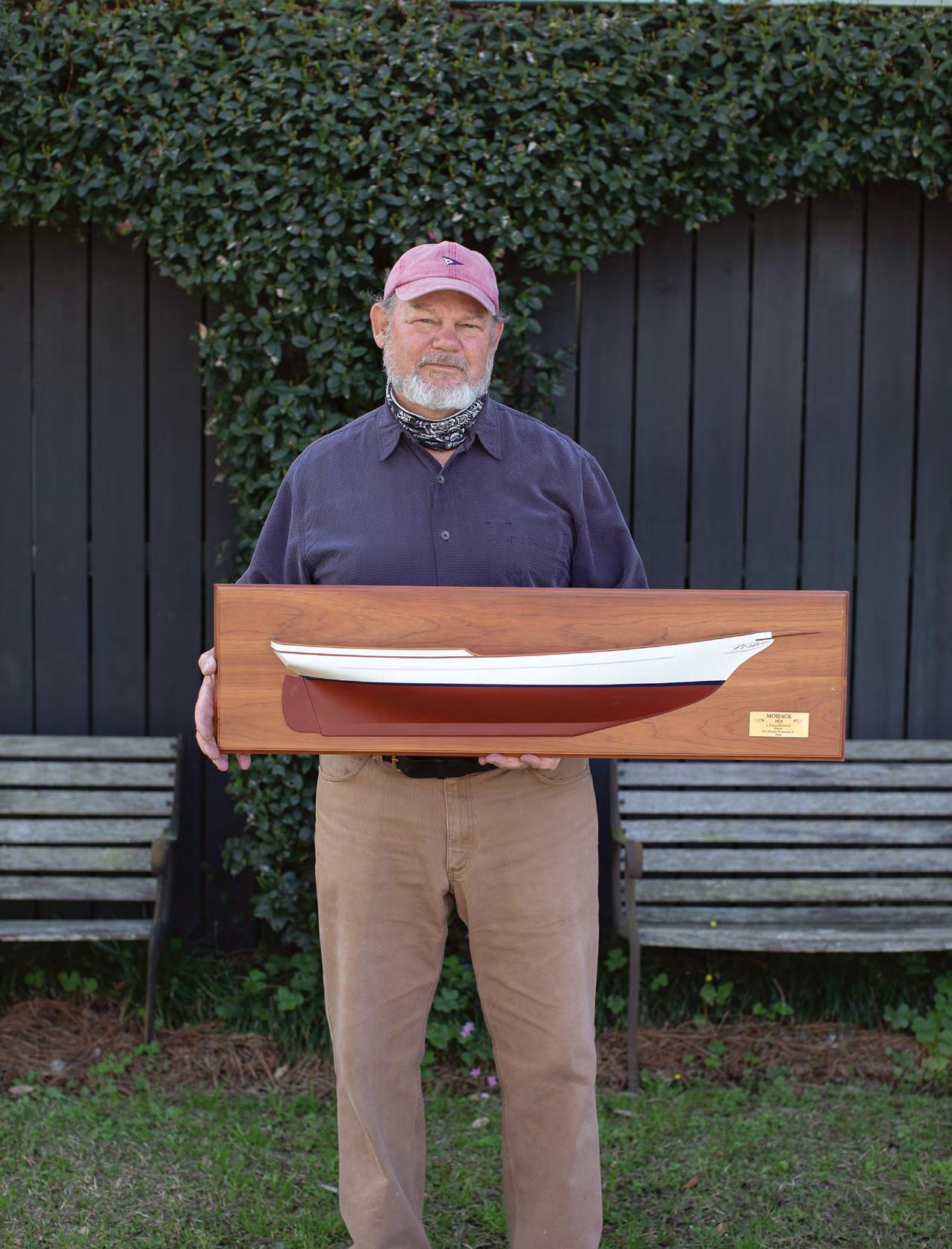 Sullivan’s Island resident Fredrick Carl “Bunky” Wichmann Jr. with a miniature replica of a former boat named MOBJACK that he and his father once sailed. The original boat was a 1935 Francis Herreshoff design.
Sullivan’s Island resident Fredrick Carl “Bunky” Wichmann Jr. with a miniature replica of a former boat named MOBJACK that he and his father once sailed. The original boat was a 1935 Francis Herreshoff design.
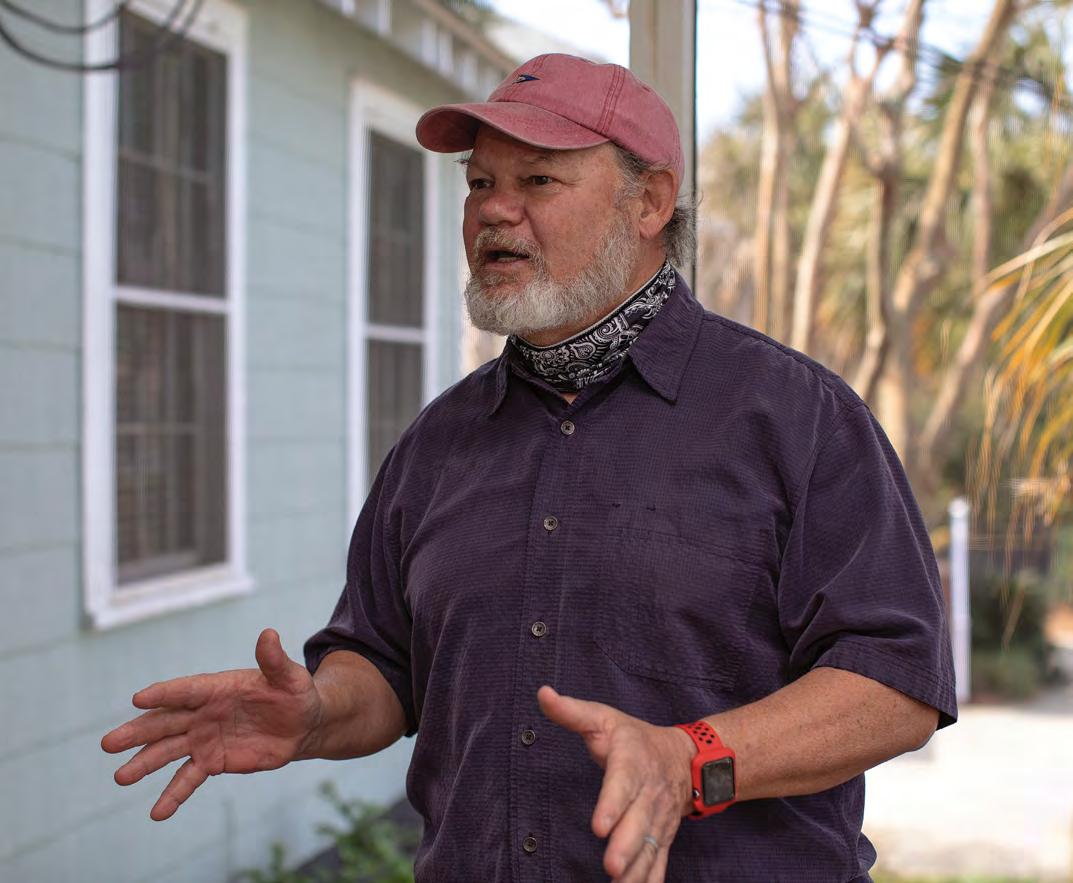
is optimal for a sherman or an Army engineer’s workboat because of its stability, practicality and price. e rst Simmons Sea-Ski was a rowing boat designed with a strong in uence from an old dory hulk and used for net shing from the ocean beach. e boat’s maneuverability is designed to be a one-man operation.
Sappho won the 16th Annual Cape Fear Community College Boat Show as well as Best in Show and People’s Choice Award. Coste’s boat was appraised for $23,500 a er winning both accolades, which are the top two honors in Wilmington, North Carolina, which also happen to be the home of the Simmons Sea Ski . “It will get you out and back a long time a er you wish you weren’t out there. It’s sturdy,” Coste says with a smile. Coste’s other love, Scoota, is also sea- and show- worthy. A 1951 Halsey “Scooter Pooper,” the boat was built here in Charleston at AO Halsey Boatworks. is was a popular boat before the berglass era. Five years ago, Coste caught word of a boat for sale down in a barn in Georgia. Scoota was considered an antique and the owner was adamant about it going to a museum. By happenstance, at the time Coste was president of the Battery Gadsden Cultural Center, a non-pro t organization that seeks to share the rich history of Sullivan's Island through lectures and performances. is association made Coste t to be a caretaker for the boat and he has since donated plenty of his time and sweat equity into restoring it.
e boat itself consists of a petite, 12-foot marine plywood frame with a mahogany deck. A perfect creek boat, it scoots along with no more than a 10 horsepower engine on the back of it. Fittingly enough, Coste has boat access within golf-carting distance of his home. e ideal inlet for trolling through the creeks on the Intracoastal Waterway.
Within the local wooden boat community, a very small circle, Coste’s friend Sam Gervais of the Lowcountry Maritime Society is similarly avid about the cra e James Island native was a water baby as well and grew up sailing competitively.
One day, during the summer of 2019, Gervais was asked by the founder of Lowcountry Maritime Society, Prentice “Tripp” Brower, to take over the helm of the business. Brower and Gervais used to compete in sailing competitions and forged a friendship through their mutual love for the watersport. Brower showed Gervais the ropes of the trade before he jumped on his sailboat to take a trip halfway across the world. Brower is still on that voyage out at sea and has yet to return due to travel restrictions caused by COVID-19.
Gervais, a former history teacher at Cane Bay High School, is now the executive director of the Lowcountry Maritime Society. e nonpro t’s mission is dedicated to connecting the community to the water and teaching math and science to h- through eighth-graders in public and private school. Gervais’ boat-building courses provide a team-based interdisciplinary platform that teachers can easily integrate into their current classroom curriculum.
Every April the Lowcountry Maritime Society hosts a boat launch, o en in line with the In the Water Boat Show at Brittlebank Park in downtown Charleston. Here they launch all the boats the students have worked on over the course of the program. Gervais cherishes the full-circle aspect of teaching and going from a pile of lumber to cra ing a seaworthy specimen. For him, that moment when that lightbulb goes o and it clicks for the student, is what it’s all about.
Opposite page: Bunky Wichmann Jr. is the grandson of the former keeper of the Cape Romain Lighthouse, built in 1958.
No stranger to wooden boats and all things sea-related is Sullivan’s Island resident Fredrick Carl “Bunky” Wichmann Jr. e nickname Bunky was coined as a baby in the crib from an old Vaudeville act starring Dot Johnson, but that’s not what’s important or unique.
Wichmann’s grandfather was the keeper of the Cape Romain Lighthouse built in 1958. Ever since he was a child Wichmann knew that the ocean would revolve around his life and sure enough he was right. At just 10 years old, Wichmann was already racing sailboats o shore with his father. His family has been sailing to the Bahamas since the 1960s.
Little did Wichmann know that six years later he would nd himself on that same course, except this time without parental supervision. In 1976, at the tender age of 16, Wichmann and his best friend Bill Swanson sailed from Charleston to the Bahamas and back. Ironically, the boat’s name was Con dence, because the intimate details of that trip are personal, says Wichmann. He will admit that this was a turning point in his sailing career. It was a coming-of-age type voyage. “I wouldn’t let my kids do what I did, hell no,” he laughed.
Today, Wichmann owns a 1973 Man O’ War Sailing Dinghy and a 1989 Sea of Abaco, but nothing compares to his prized possession MOBJACK. An original 1935 Francis Herresho design, MOBJACK was purchased in 1981 with no mast and no hint of any seaworthiness, although it was rumored General George S. Patton supposedly once sailed on the boat.
A er xing her up, Wichmann and his father spent the next 35 years sailing her up and down the East Coast from New England to the Caribbean. But, before she was nally put to rest, he would nd himself on yet another “ill-advised adventure.”
It was 1983, Wichmann remembers the exact year because it was when Australia beat the United States in the America’s Cup. e 132-year-old sailing event was traditionally taking place of Newport, Rhode Island. Wichmann was out in those same waters in MOBJACK when devastation hit. Approximately 120 miles out from New York, Wichmann and a sailing partner hit a patch of nasty weather and the boat began to capsize. He recalled using 5-gallon buckets to try to bail out the water but it made no di erence. With the help of the U.S. Coast Guard, they were able to make port at Ocean City, Maryland without surrendering the boat to the sea.
Wichmann has a miniature replica of MOBJACK that hangs on the wall above his kitchen in his home. He rarely ever takes it down so dust visibly collects, but every time it catches his eye the memories accumulate as well. In February, Wichmann and his family returned to the Cape Romain Lighthouse to spread the ashes of his father, who would have turned 91 this year. In recent years, there have been attempts to decommission the light, but it is protected by the Cape Romain National Wildlife Reserve.
Wichmann lives by his father’s words of wisdom that he has passed down to his son, eo. “Have fun. Have an adventure. And don’t be afraid to take risks—within reason.”



Reverend Monsignor Lawrence B. McInerny’s family has been on Sullivan’s since the building of Fort Moultrie, and four generations of McInernys have made the island home. The Stella Maris priest sat down with the Battery Gadsden Cultural Center Oral History Project to tell the tales of his family’s time on the island and help keep its history alive.
By Kinsey GidickTop: Father McInerny’s aunts and uncles sit with John McInerny who was born on Sulllivan’s in 1842. Bottom: Father McInerny’s aunt Christle (center, in large hat) with some locals, enjoying a classic Sullivan’s past time.
These days, there are very few people on Sullivan’s Island who can trace their family’s arrival to the 1840s. Rev. Msgr. Lawrence B. McInerny, J.C.L., better known as Father McInerny to his congregation at Stella Maris Catholic Church on Middle Street, is one of them. As Father McInerny recently recounted to the Battery Gadsden Cultural Center’s Oral History Project, his family grabbed a Lowcountry foothold in 1840. at’s when McInerny’s ancestor Michael McInerny le County Clare Ireland (pre-potato famine, mind you) and wound up making a home on the island at the same time Fort Moultrie was under construction.
“I know he lived on Cow Alley,” says Father McInerny in the recorded talk that’s now stored on Lowcountry Digital Library operated by the Addlestone Library at the College of Charleston. One of 11 videos made thus far, Dr. Mike Walsh, Battery Gadsden Cultural Center president, says the project is an e ort to preserve the histories of long-time islanders and their families. Joining individuals like Ruth Schirmer Dehaven, who tells of an area of the island once called “Schirmerville,” and Carl Smith’s look back at his years as mayor, McInerny was a natural addition to the collection. And what we can learn from his story is a better understanding of a bygone age for one of Charleston’s barrier islands.
rough photos and stories passed on by his Irish forebears, Father McInerny describes an island far from the one we know today. A place that promised immigrants a new life lled with opportunity. A place where, as his grandmother described it, “anybody could come and eke out a living.” at’s what Michael McInerny was a er, Father says. But if Cow Alley doesn’t sound like the place to nd it, consider this: that’s actually Station 9 ½ today —a place now recognized for its opulent seaside estates.
Michael McInerny was in the real estate business, too. Father McInerny says he purchased quite a few properties but had trouble in business. “I found out that he had a bakery that burned, and it was an arsonist who had also set res at Fort Moultrie. I think maybe the burning of the bakery is what messed him up with the business,” says Father McInerny.
Tragedy struck again in 1884 when Michael McInerny was hit by a distracted driver, in this case one driving a horse and buggy, and he died from his injuries. But the family legacy continued thanks to Michael’s progeny.


 Michael McInerny immigrated from County Clare, Ireland to Sullivan’s in roughly 1840.
Michael McInerny immigrated from County Clare, Ireland to Sullivan’s in roughly 1840.
 Father McInerny’s father, pictured here around 2 years old. His mother took him into the city for his portrait.
Father McInerny’s father, pictured here around 2 years old. His mother took him into the city for his portrait.
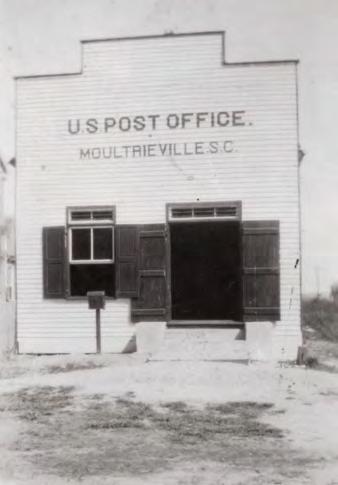
Clockwise from left: The town post office where Father McInerny’s aunt was post mistress. E. Reynolds McInerny standing in front of The Launderette in the 1950s, the building was once the post office and originally built as his father’s store. A quarter master’s boat at Ft. Moultrie. Centennial Hall—built in honor of the Revolutionary War centennial. Francis Simmons and Douglas Watson in front of a tree bearing Father McInerny as a young boy. In the background is the Blanchard homestead and the former A.M.E. Church.
Michael’s son, John Francis McInerny, was born on Sullivan’s Island in 1842. “He’s probably my favorite of the ancestors,” Father McInerny says. John Francis is notable for quite a few Sullivan’s landmarks. To begin with, and as hard as it might be to believe, he owned a lumber business on the island, which he eventually operated from Station 18 ½ to 19. “It never worked well. It wasn’t deep enough. It was kind of undependable in getting the lumber o -loaded,” Father McInerny explains. Out of luck and out of cash, when Reconstruction hit, John Francis moved to Brooklyn, met his wife, and had a baby who would become Father McInerny’s grandfather.
By 1875, records show the family had returned to their ancestral home on Sullivan’s and in 1889 John Francis bought Centennial Hall. Now there are a very few islanders who have photos or have heard of this once important building, so for those who haven’t, Centennial Hall was a gathering place opened in commemoration of the centennial of the American Revolution on June 28, 1876. “ ey had a pool table. ey had changing rooms. ey had dances. ey advertised they had a fancy piano; they could make up a hop at any time. ey served food,” says Father McInerny.
And incidentally, in a twist that could only happen in a small island community, it was built by Father McInerny’s great-grandfather on the German side, Anton Hammerschmidt. But by the time it landed in John Francis’s portfolio, it was in disrepair. e cyclone of 1885 had le it in tatters. He later sold the building and it no longer exists today.


Grandfathered In
is all brings us to Joseph P. McInerny, son of John Francis and the man who would become the grandfather to our narrator, Father McInerny. We can all thank Joseph P. for bringing better education to the island. It was his life’s work. e merchant who raised seven children loved to sh, but it was getting a public school out on the island that was his great ambition, which he worked toward until he died in the late 1920s.
But not before Father McInerny’s father had arrived. Edward Reynolds McInerny was born at the family’s Sullivan’s homestead in 1910. At the time the army was still onsite and this colored his childhood. “It was a di erent world, in the sense of the soldiers and the mortar battery up there where the Town Hall is today, watching the projectiles go out as the coast artillery practiced up there,” Father McInerny says.
Life ran on when the next ferry boat was to arrive. He played basketball on a team that practiced on a court behind the rear part of the post exchange. In between his athletics and shing in the creek, Edward got his rst job working in the laundry at Fort Moultrie. Learning that trade led to his career running a laundrette on the island for the rest of his life.
Which brings us to Father McInerny’s generation.
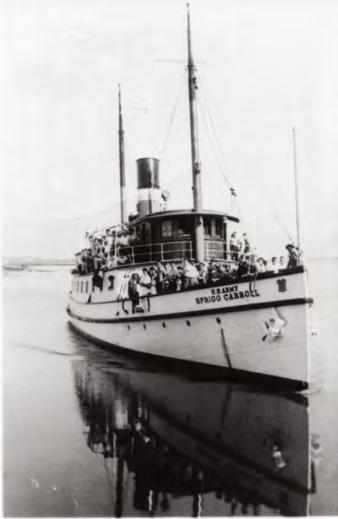

“ ings have changed, but it’s still a good community. It’s a great community. I think the great thing is all the people that love the island,” says Father McInerny. What he remembers is that the island was hopping with children in the post war baby boom. “ e other thing that I miss—we had a lot more Black people on the island in those days when we grew up. We’d played baseball over there in Mrs. Burbage’s backyard, and we all played together. We had a very, I guess you’d call it, diverse group, and not just among the children, but even the adults. You had the people who’d been here forever, and you had the people, of course, who had moved here, as was always happening,” he says. “But you had a lot of the old soldiers from Fort Moultrie still around, some of the sergeants especially. And they were a lot of fun. ey were some characters in their own right, you might say. So, there were a lot of di erent people.”
Part of the mission of the Battery Gadsden Cultural Center, a nonprofit established in 1992 to create a museum of the civilian life of Sullivan’s Island, is to collect the oral histories of island residents. The Sullivan’s Island Oral History project conducts interviews that document both facts and lore related to the Island and its culture. By creating digitally accessible oral histories, the project serves to protect these records and to make them available to everyone for both personal enjoyment and historical research. There are currently around a dozen interviews with islanders stored in the Lowcountry Digital Library online at lcdl.library. cofc.edu/lcdl. If you or someone you know has a story to tell about their connection to Sullivan’s Island, contact the Battery Gadsden Cultural Center at batterygadsden@gmail.com.



3 52nd IOP

9 Tabby Lane IOP
And the kids had free rein of the island. McInerny says every child had access to a bike and a small boat and once they could handle either with relative competence, they were free to do as they pleased. is independent childhood made Father McInerny fall in love with his island home, so when it was time to take his vows as a priest, he says it was hard to say goodbye. “I never dreamed that I would be pastor of Stella Maris,” he says. “Part of my biggest struggle in becoming a priest was leaving the island, because obviously I have deep roots here. But I love the people and I love the place. I was in seminary for four years, and I decided to take a couple years o ... I nally decided that Sullivan’s Island is great, but it’s not the kingdom of God. It’s almost there, but it’s not quite. We always say that’s why we have mosquitoes and gnats—to remind us we’re not in heaven yet. Otherwise, we’d get confused.” But, divine intervention apparently had another plan. “In our diocese, you would go anywhere in South Carolina. We cover the state. And it was very much to my surprise. I was probably 10, eleven years into the priesthood, always in the Charleston area, but they asked me if I would take Stella Maris. So I said, ‘Well, let me pray over that.” I said, ‘Hail Mary, full of—yes!’”
And that’s how four generations of McInernys have shaped this island and made Sullivan’s home.
Stunning oceanfront like location on quiet side street with residential only parking. 100’ x150’ lot with fantastic potential.
Overlooking the Intracoastal Waterway, this one owner waterfront house sits on almost 3/4 acre impecabbly landscaped lot.

12 Sand Dune Lane IOP
Front beach luxury home in a private community. It comes completely furnished with a solid rental history. PENDING

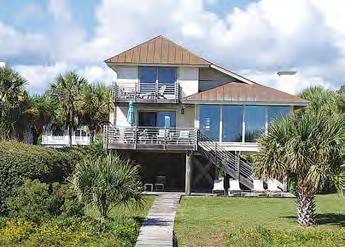
Jerry and Cheryl Kaynard are dedicated to improving their Sullivan’s Island community and helping those less fortunate.
By Colin McCandless Photos by Mark Stetler“ If there is any one word people would use to describe me, it’s ‘relentless’.
- CHERYL KAYNARD
Spending time with Sullivan’s Island residents Jerry Kaynard and Cheryl McMurry Kaynard in their downtown Charleston o ce o ers a window into the lives of these workaholics, community activists and humanitarians. A quick scan around the room reveals photos of Jerry posing with former President Jimmy Carter and Cheryl with current President Joe Biden. e Kaynards have devoted their lives to public service, and both are proli c. Jerry is an attorney who spearheaded the creation of Charleston Pro Bono Legal Services, a former Town of Sullivan’s Island councilman and mayor pro tem, and a former South Carolina DHEC board vice chairman. Cheryl is an attorney, business executive, educator and former Chief Counsel to the Federal Highway Administration. She currently serves on eight boards including chairing WestEdge Foundation and serving on e Sherman House, Pavillon International (a residential addiction treatment center) and e North Carolina Arboretum, among others.
Jerry, who worked for Jimmy Carter during his gubernatorial run in 1966 when the future attorney was attending the University of Georgia, considers the former president a role model and personal hero. He headed the Carter campaign for Charleston in 1976 and his 1980 re-election run, while serving as Charleston County Democratic party chairman. In 1980, Cheryl was serving as Chief Counsel to the FHA in Washington, D.C. e story behind how they rst met is connected to these respective roles and led to a collaboration that produced a well-known Charleston bridge.
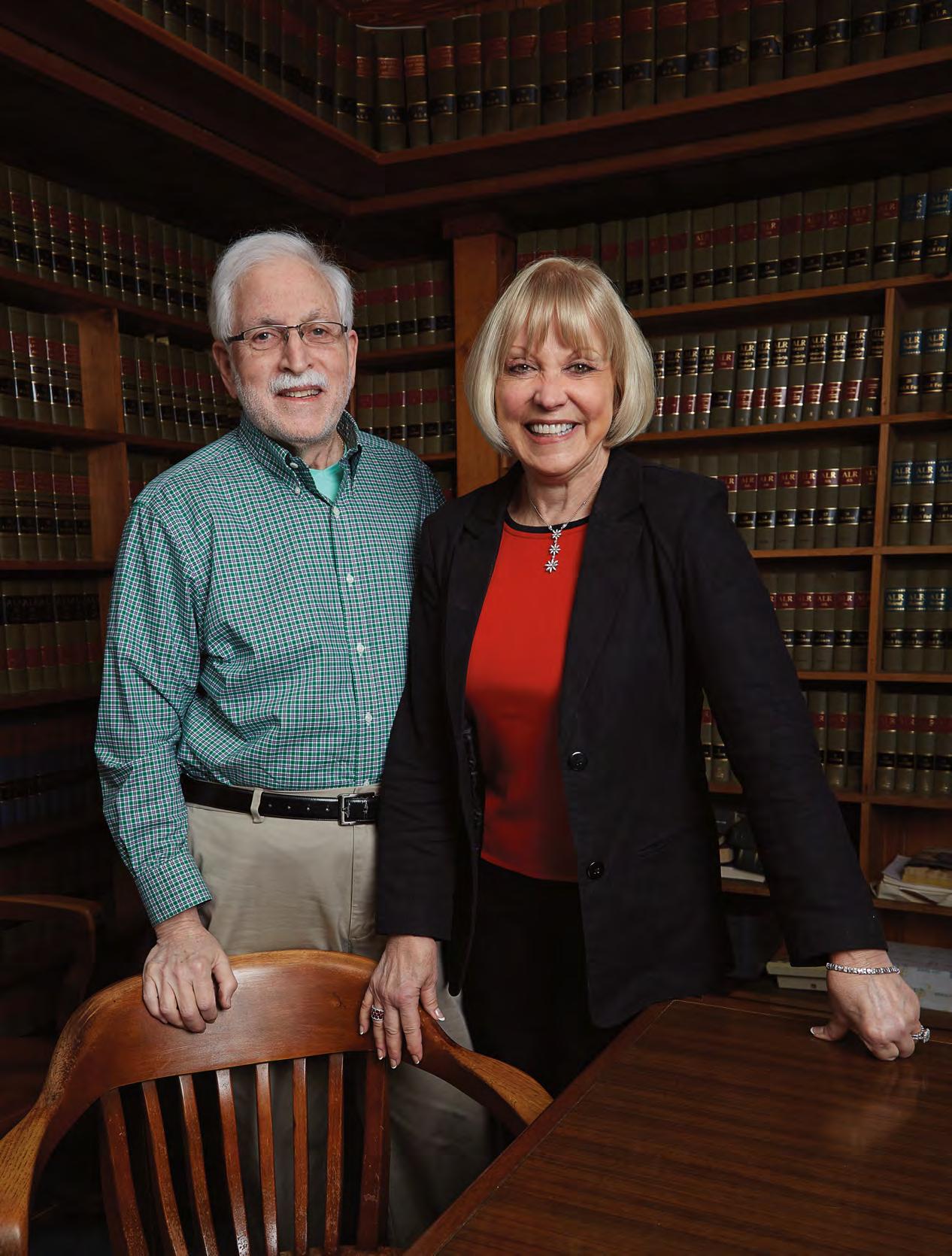 Jerry and Cheryl McMurry Kaynard in their downtown Charleston office, located on Church Street.
Jerry and Cheryl McMurry Kaynard in their downtown Charleston office, located on Church Street.
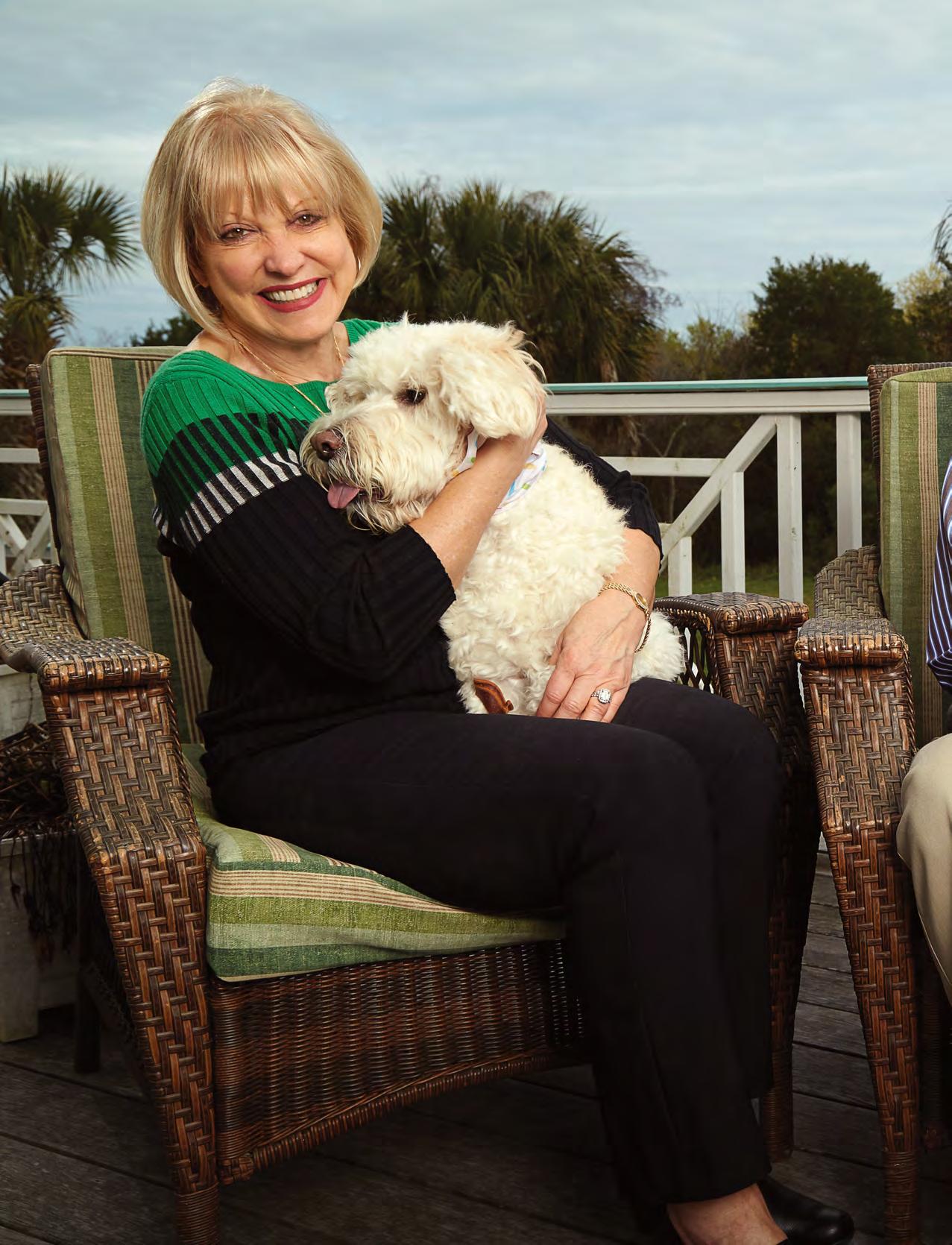 Cheryl and Jerry relaxing at their Atlantic Avenue home on Sullivan’s Island, with their two golden doodles Banjo and Bosco—the real bosses in the family.
Cheryl and Jerry relaxing at their Atlantic Avenue home on Sullivan’s Island, with their two golden doodles Banjo and Bosco—the real bosses in the family.

that spawned a bridge
eir chance meeting occurred amid the height of political season during Carter’s 1980 re-election run, when everyone was “jockeying for favors,” as Cheryl cynically phrased it. Jerry met Cheryl by accident in the D.C. airport and while chatting they learned they shared some common friends. ey soon formed a friendship of their own.
Using his White House contacts, Jerry procured them tickets to the main table of a swanky black-tie gala hosted by the Jewish service organization B’nai B’rith International, where they were seated with Cheryl’s then boss, Secretary of Transportation Neil Goldschmidt, who was receiving an award.
It being election season, Goldschmidt asked Jerry if there was anything the U.S. Department of Transportation could do to help South Carolina. Jerry, who was working as a city attorney for then-Charleston Mayor Joe Riley, mentioned a local bridge project known as the James Island Connector. Jerry communicated to Goldschmidt that they had never been able to get the federal money to build it. In reality, original construction e orts dated back to the ‘60s and the project lay dormant at the time. Goldschmidt promised to look into it.
When Jerry admitted to Riley that he had misguidedly told Goldschimdt the James Island Connector was an active project, Jerry asked who should consult with the DOT. At that time, Charleston had a bare-bones planning department, and that’s how Jerry became the liaison to the federal government on the Connector project.
As Chief Counsel to the FHA, the DOT division which funds bridge construction, Jerry’s new friend Cheryl soon became an in uential ally in his quest to secure federal dollars. ere was a government freeze at the time, which complicated matters, but Cheryl caught wind of some discretionary money available and doggedly pursued it for the Connector project. Her persistence paid o , to the tune of $5 million. “If there is any one word people would use to describe me, it’s ‘relentless,’” quipped Cheryl.
Funding secured, there was still the not-sotrivial matter of White House approval. at’s where Jerry’s White House contact delivered. His former University of Georgia roommate Hamilton Jordan was serving as Carter’s Chief of Sta . Jordan approved it and Cheryl moved forward to release project funding. It took 13 years for the bridge to be completed, but the Connecter was eventually constructed and today it serves as a vital freeway link between Charleston and James Island.
Although she lived in Oklahoma at the time with her then husband and two daughters, Emily and Maggie, at Jerry’s invitation Cheryl ew into Charleston for the 1993 bridge dedication. “What I love about the story is the serendipitous part of it,” she recalls, of how an accidental meeting helped with the building of a bridge that had been stalled for years. Jerry re ects that the experience taught him the life lesson “that when an opportunity presents itself, you’ve got to be ready to grab it.”
“ When an opportunity presents itself, you’ve got to be ready to grab it.
- JERRY KAYNARD
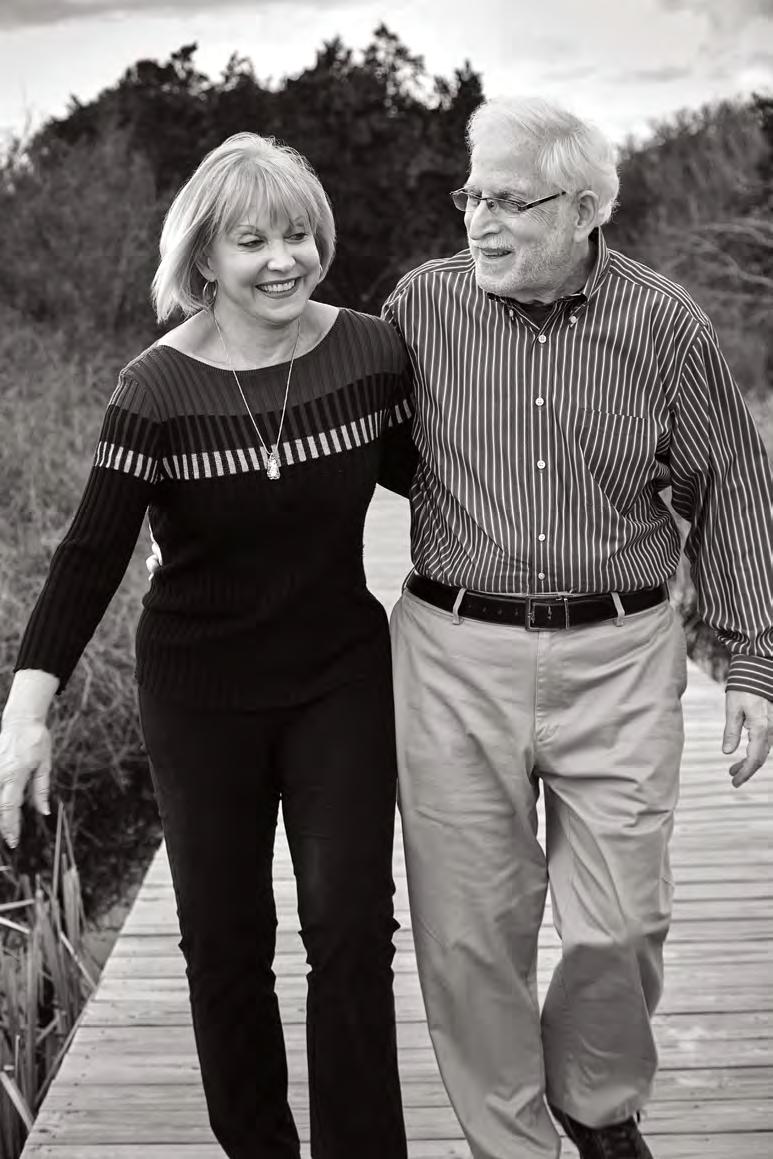
Jerry and Cheryl would later marry and have now been together 12 years. Cheryl commuted from Asheville during the rst year of their marriage while serving as CEO of the Bent Creek Institute, which conducts research into medicinal botanicals. She eventually sold her house and moved to Sullivan’s Island to live with Jerry on Atlantic Avenue in a house he built in the 1970s.
Cheryl, who grew up in a little Oklahoma town said she “loves the small-town atmosphere” of the island and the “milieu of people who know each other.” “I love seeing people out walking on the beach and walking their dogs. Just doing things that are reassuring during these anxious times.”
One of Jerry’s proudest moments during his eight years on Town Council was helping lead the ght to save Sullivan’s Island Elementary School. Built in 1955, an inspection conducted in the mid-2000s revealed structural de ciencies that deemed the building unsafe and necessitated a rebuild. e rebuild needed to be large, and a vocal minority in the community voiced opposition over tra c near their homes and sightline concerns. Jerry, who then served as Sullivan’s Island’s mayor pro tem, felt the “health and vitality of the community were at stake.” Six council members supported reconstruction and one member was opposed, but there was a heated debate within the community over the size.
Construction was nally completed in 2015, with a capacity of approximately 500 students. “ e con ict over building was intense, but it was worth it,” recounted Jerry. He described one of his “forever moments” as seeing SIES rst graders on iPads and portable aquariums in classrooms that teach students about marine biology.
Although rebuilding SIES was controversial, Jerry believes people will look back and say it was key to the island’s future. He regards Sullivan’s Island as “Mayberry by the sea,” an idyllic place where kids ride their bikes and families cruise around in golf carts. “I like to think positively about the community spirit we have on the island,” he said. “I think of it as a community that can pull back together once we reach a decision.”
Cheryl, who has a master’s in Teaching from Winthrop University, re ected that she too believed that saving the school would help determine the island’s future. She expressed concern that without children Sullivan’s Island could have become an upscale retirement community. Cheryl added that the SIES rebuild issue was made more challenging because Sullivan’s Island is a tightknit place. “We’re all on this little island together. e sense of it being a community and neighborhood, so you’re concerned about decisions and how they a ect your neighbors and neighborly relations.”
In 2004, together with the Charleston County Bar Association, Jerry helped found Charleston Pro Bono Legal Services, an organization providing free general legal assistance to economically disadvantaged individuals who can’t a ord one. eir work is made possible through various grants, foundations and supporter contributions.
It has expanded from a two-person organization to a 10-person o ce with ve lawyers today. Charleston Pro Bono is the successor of the federally funded Neighborhood Legal Assistance Program, over which Jerry served as long-time board chairman.
Since Charleston Pro Bono’s inception, Jerry has provided 150 law students summer internships to help them gain their rst experience in public interest law. He typically hires at least 10 students every summer whose internships are funded by the Ackerman Foundation, a private foundation supporting education, the arts, student programs and legal services for low-income persons.
Pro Bono’s lawyers also do special housing project work protecting people who cannot a ord to pay their rent from eviction, an issue that has become dire during the pandemic. e project has developed from a narrow program to a community-wide assistance e ort. “ at’s something that’s very important to Pro Bono’s e orts,” said Jerry. Pro Bono has even been part of Mayor John Tecklenburg’s City of Charleston Homeless Task Force, assisting citizens of the “Tent City” that were camped under the Interstate 26 bridge in accessing transitional housing and nancial resources.
Cheryl, who assists Pro Bono as an attorney, called Jerry, who serves as board chairman, the “driving force that has kept the organization alive.” She also referenced the 2016 executive director hire of the “very dynamic” Alissa Lietzow as making a profound impact. “It’s very inspirational,” she remarked of Pro Bono. “People are trying to help their neighbors.”
In 2015, Charleston Pro Bono became the sponsor and bene ciary of the popular Sullivan’s Island fundraiser Art on the Beach and Chefs in the Kitchen. e annual November bene t, which quickly sells out every year, features a tour of homes on Sullivan’s Island, chef demonstrations and an art show. In addition to showcasing the culinary creations of Sullivan’s Island chefs, it gives local and regional artists an opportunity to promote their talents. “We get to do all of that in a bene t for a worthwhile organization,” said Cheryl. “It’s a really great community project.”
Coordinating a fundraiser of this magnitude requires an extensive volunteer e ort, including gracious hosts accepting the risk of inviting strangers into their residences. “ ese folks that open up their homes, that’s a big deal,” asserted Cheryl. “It’s a leap of faith.” Cheryl pointed out that you can’t discuss the event without recognizing Carol Antman, who started the fundraiser more than 20 years ago. Art on the Beach originally bene ted local performing arts school Creative Spark until it closed down. Jerry, who is friends with Antman, collaborated to transfer the fundraiser’s assets to Pro Bono in order to keep its nonpro t status, leading to Pro Bono assuming responsibility for managing the event. Last year’s fundraiser was virtual because of the pandemic, but the hope is to hold an in-person event in 2021.
Despite everything on their plate, the Kaynards show no signs of slowing down. “I’m always looking for new things to get involved in,” said Cheryl. Jerry added they feel their good fortune in life obligates them to give back. “Both of us are trying to reach out and make the world a better place for those who are less fortunate.”





Faith inspires Walter Sherrill, Sullivan’s Island Elementary’s school crossing guard, to serve as community ambassador.
By Colin McCandless Photos by Rob BykoF“ He’s completely focused on his work and the kids. They just adore him. - SUSAN KING
or many Sullivan’s Island Elementary School students, the school crossing guard is the rst person to greet them in the morning, and o entimes the last person they see in the a ernoon as they head home. is individual bears the important responsibility of guiding their safe passage through tra c, which can be a dangerous proposition on the busy streets of Sullivan’s Island. At SIES, this vital role belongs to Walter Sherrill. As a school crossing guard, state law authorizes Sherrill to stop tra c in order to allow the children to securely cross the street. “ at can really be something today because there are so many distracted drivers,” observed Sherrill. Texting while driving and speeding are two of the most common issues he regularly witnesses. “Someone wanting to get nowhere in a hurry,” he quipped.
Compounding that challenge, school trafc has risen during the pandemic since fewer children are riding the bus due to capacity limits and more parents are dropping kids o by car. With more students than usual to safely usher across the street, it’s been a busy year, but it’s all worth it to Sherrill when he glimpses the childrens’ smiles and hears their heartfelt ‘thank yous.’ “It’s just fun to see how grateful the children are,” beamed Sherrill.
His road to becoming a school crossing guard is connected to his time as a Sullivan’s Island beach patrol o cer. Sherrill, who grew up in Lincolnton, N.C., spent 32 years in Philadelphia where he worked as a chemist in a clinical laboratory. He retired in 2005, and in 2006, he and his wife, Dorothy, a retired teacher who originally hails from Mount Pleasant, decided they would move to her childhood home.
Retirement proved an ill- tting suit for Sherrill. He tried it on for a time and then boredom set in. “I wanted to keep busy,” recalled Sherrill. His initial return to the daily grind included part-time gigs at Ace Hardware and Target. en in 2013 he answered an employment ad for a Sullivan’s Island beach

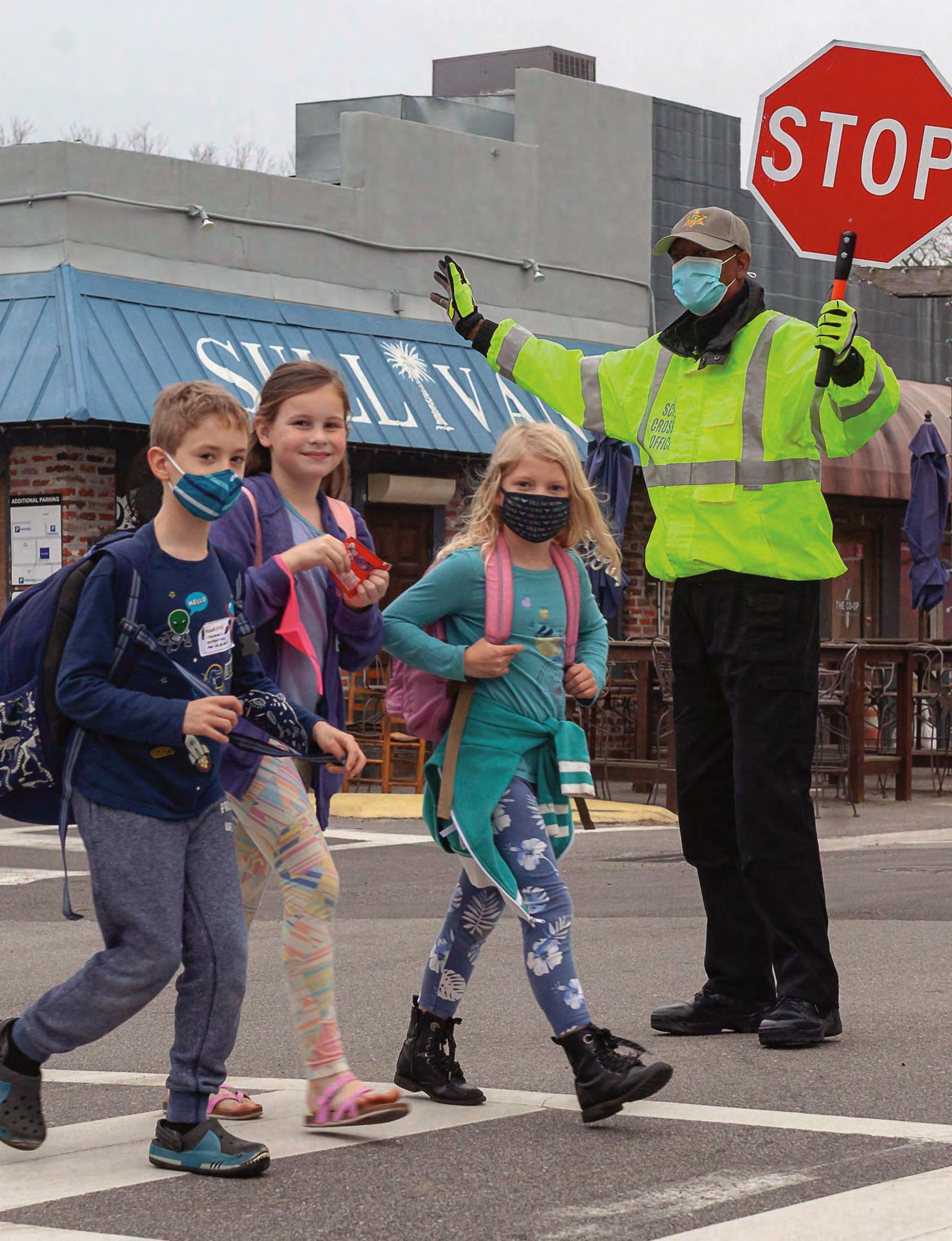
Opposite page: Sherrill at work on Sullivan’s Middle Street. He says distracted drivers are his biggest concern when it comes to students’ safety.
patrol o cer and was hired. His duties included patrolling the beach and enforcing the Town of Sullivan’s Island’s ordinances, including regulations pertaining to alcohol and dogs.
During the 2016-17 school year, SIES, which at this time didn’t have a school crossing guard, asked the Sullivan’s Island Police Department whether they could provide anyone to assist with morning and a ernoon student street crossings. Police Chief Chris Gri n approached some of the beach patrol o cers to see who would like to volunteer. Sherrill stepped forward since it was convenient for o cers to come o the beach during those hours to lend a hand. Soon a er the school requested a permanent crossing guard. Sherrill applied and the Charleston County Sheri ’s Department hired him on October 19, 2017.
Due to some family commitments, he recently retired as a beach patrol o cer a er serving eight years, which has freed up availability to continue his SIES crossing guard duties. “At least as long as I can,” said Sherrill. What Sherrill loves most about the job is the gratitude shown him by parents, teachers, and most especially, the children. “ e children are a real delight,” he remarked. “ ey are so appreciative of the assistance they get in crossing the street.”
e students demonstrated their thanks earlier this year when the school celebrated national “Crossing Guard Appreciation Week.” Some teachers had their students write letters and draw pictures to give to Sherrill expressing their gratitude, and he received cookies and other baked treats from teachers. A pleasantly surprised Sherrill acknowledged he was previously unaware that a week recognizing crossing guards even existed. “So, I have a whole stack of letters and pictures from elementary school students,” he said.
While teachers might wonder if they are having an impact on educating students about being courteous, Sherrill can assure them that the majority of children behave graciously toward him. SIES Principal Susan King o ered e usive praise for Sherrill’s work ethic and character. “He just has an excellent rapport with students, teachers, sta and parents,” said King. Sherrill always arrives at school early to prepare for his crossing guard duties and waves to everyone. He’s friendly and cordial, but he’s also very serious about his job. “He’s completely focused on his work and the kids,” noted King. “ e kids just adore him.”
She adds that Sherrill will take time out of his day to express safety concerns to her, like if a child is not wearing a bike helmet. On mornings when tra c backs up, he calls King on her cell to alert her of any developing situation. King said it’s nice to have a consistent, reliable, dependable adult to serve in this position. “I couldn’t ask for a better school crossing guard.”
As a Born Again Christian, Sherrill cites faith as playing a signi cant role in how he views his service to the community and interactions with children, teachers, and parents. “I look at myself as an ambassador for the Lord out there,” stated Sherrill. A pastor’s son, he grew up around the church and the basic foundations of his faith were laid in his formative years. Despite coming from a spiritual family, some wayward periods as a rebellious teen and young adult followed, until Sherrill reached a turning point in his life—about 16 years ago when he was still living in Philadelphia. “Later in life I realized that something was missing,” recalled Sherrill. “I felt the void, and there was only one way to ll that void, and that was through a relationship with the Lord.” Sherrill is active in God’s Way World Outreach Church in Mount Pleasant’s Hamlin community where he enjoys the faith and fellowship.
Ever the diligent servant, when not working as a crossing guard or attending church, Sherrill dons his handyman cap and works on home improvement projects. Clearly that retirement suit will have to wait a while longer for a good t.




Every community needs a welcoming committee, and on Sullivan’s that job belongs to Leo Fetter.
By Marci Shore Photo by Rob BykoL“ Leo cares about people. - MARY LOUISE RAMSDALE
eo Fetter, 67, works the perimeter of the Saint Patrick’s Day crowd at Dunleavy’s Pub on Sullivan’s Island. His omnipresence is exceeded only by his congeniality. “Leo is a familiarity on the island,” said Andy Donovan, a bartender at High yme restaurant and Dunleavy’s Pub. “He’s a friendly face who asks how my family is doing. He’s always thoughtful and remembers birthdays. It’s refreshing to see someone who is always in a bright mood.”
Dunleavy’s owner, Jamie Mahr echoed Donovan’s sentiment. “He checks on the sta , and me. He’s part of the family and an integral part of Sullivan’s Island. If we don’t see him for a while, we get worried. Especially over this past year.”
A car attempting to back out of a space in front of Home Team BBQ is being denied with each e ort by weekend tourist tra c. Halting in mid-sentence, Leo marches into the middle of Middle Street, stops tra c, and motions to the frustrated driver that the coast is clear and that it’s safe to back out.
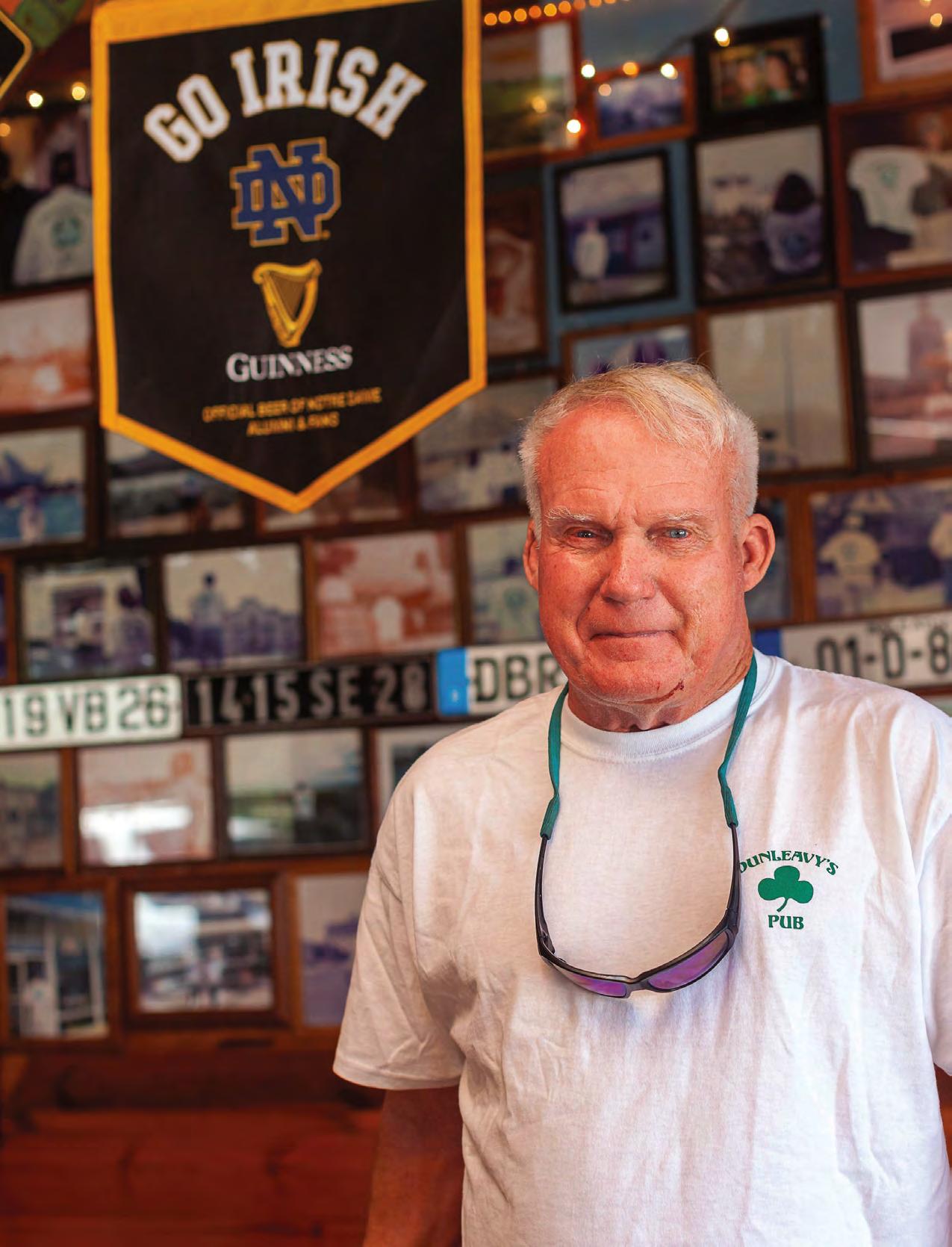 Leo Fetter in Dunleavy’s Pub where his friends throw a birthday party for him every June.
Leo Fetter in Dunleavy’s Pub where his friends throw a birthday party for him every June.
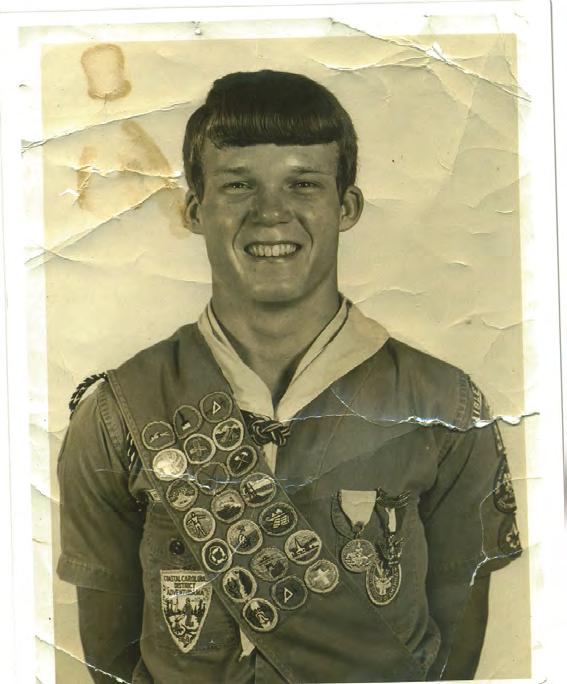




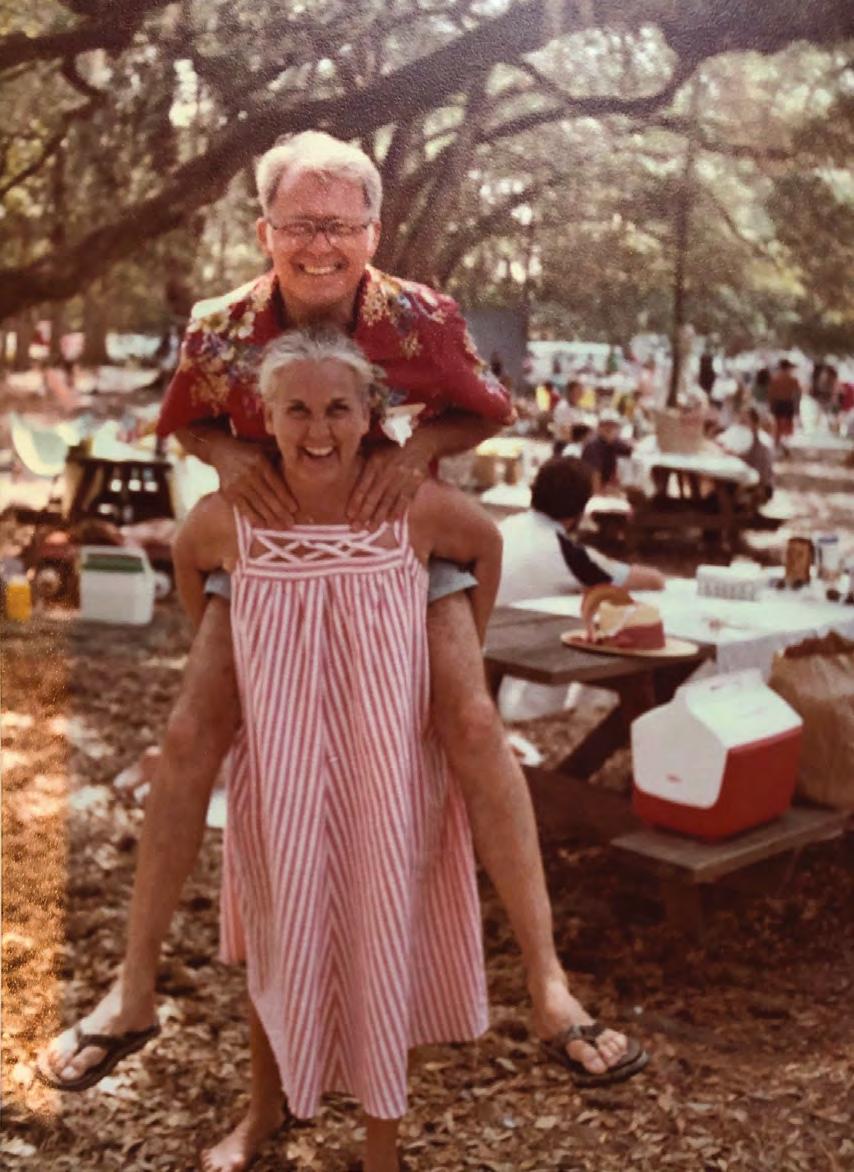

From top: Leo organized one of the first beach sweeps as a ninth grader to help earn his Eagle Scout Badge. Leo’s parents, Sue and Ray Fetter. Leo with The Village People. (He worked as a chauffeur at a fundraising event where the band performed.)
His immediate family history began just feet away, at the current location of the Mex 1 restaurant. Leo’s mother, Sue, and father, Ray, rst met there in the 1950s, when it was the restaurant Brownells. Sue was from Augusta, Georgia, and her family o en vacationed on Sullivan’s. Ray was born and raised on the island.
e eldest of seven children, Leo has lived most of his 67 years on the island, with only brief periods of time away. ese include when his father took a job in North Charleston and when he was in the Army National Guard, deployed overseas providing data and voice support for the troops.
As the uno cial Mayor of Sullivan's Island, if people ask him why he didn’t run for town o ce he says he prefers to be in service behind the scenes to those in need. “If someone is hurt or sick, I want to be there to help. I enjoy taking care of people,” he said, immediately jumping back into the conversation a er helping the car back out of its space. He credits his “caring parents,” and his “second mother” and nanny, Elizabeth Edwards, for instilling in him the value of service to others. “Leo cares about people,” says Sullivan’s resident Mary Louise Ramsdale. “You can always count on Leo to remember your birthday and your kids’ birthdays with a card and candy. When my father was ill, Leo got him a get well card. He always asks about my sister who serves in the military overseas. ere is no question that Leo has a special place in many Sullivan’s Island residents’ hearts.”
Ramsdale and Leo’s neighbor, Gallie Coles, throw an annual island birthday bash for him at Dunleavy’s Pub. He is quick to remind locals and invite them to the June occasion in the weeks prior to it. Coles and her family have been living in the house next to Leo for only 10 years, but already consider him to be family. “‘Uncle Leo’, as our family refers to him, is a part of our daily lives, just like a member of the family,” she says. “We have a special spot at the fence where we o en meet daily to catch up and say hello or share treats with each other. Leo is full of enthusiasm and kindness and loves sharing the stories of his upbringing here on the island,” she said.
Leo’s care and service not only extends to residents, but also to the island itself. Following in the footsteps of his father, who was active in conservation issues pertaining to Sullivan’s, Leo started one of the rst Beach Sweeps to clean and beautify the beach, as a ninth grade Eagle Scout candidate.
Born back when Sullivan’s Island was home to only 75 full-time families, Leo said that “growth” is the worst change he’s seen, adding that it is “of course, inevitable.” He penned an ode to his youth in A Kid’s Playground , to share the island he remembers. e Sullivan’s Island of his childhood rang with dinner bells that called children home to eat, when reies were contained in jars to help illuminate the way at night. It tasted of blackberries, wild asparagus and honeysuckle found freely. Hard rains that turned yards into ponds were opportunities to bring out the aluminum boat and oat to one another’s homes to catch frogs, tadpoles, and even small snakes.
Sweltering days were opportunities to take turns trying to “outdo one another” on the rope swing plunging into the marsh, or camping on one of the man-made islands of plu mudd created from dredging the Intracoastal Waterway. Nighttime adventure o en included camping on the beach and exploring the many tunnels of the batteries and even entering Fort Moultrie a er hours. “Woven through the daily fabric,” he wrote in his remembrance, was “decency, camaraderie, community, and adventurism.”
Leo is known to extend this same camaraderie and feeling of community to not only island natives, but also newcomers who come to love the island as much as he does. Drew Harris, who opened the Cafe Medley co ee shop on Sullivan’s in 2010, along with his wife, Michelle, became fast friends with Leo. Harris has been a supporter of Leo’s competitive weightli ing events in recent years.
Leo’s young neighbor, Wesley Coles, met him at the fence between their houses 6 years ago, and asked Leo when he was going to start li ing weights again. at lit a spark, and in 2018, Leo set the state record for his age group, deadli ing 353 pounds. e State Senate issued a Resolution congratulating him, citing the challenges he overcame including multiple corrective foot surgeries as a child, leg braces, a speech impediment, and attention-de cit disorder.
“I love hearing his stories about the way the island used to be and the generations of neighbors who once and still live on the island,” says Harris. “Every community needs a Leo and Sullivan's is lucky to have theirs.” e island simply wouldn't be as charming without Leo wandering from restaurant to restaurant and delivering his gi s to everyone that holds a special place in his heart. SiP



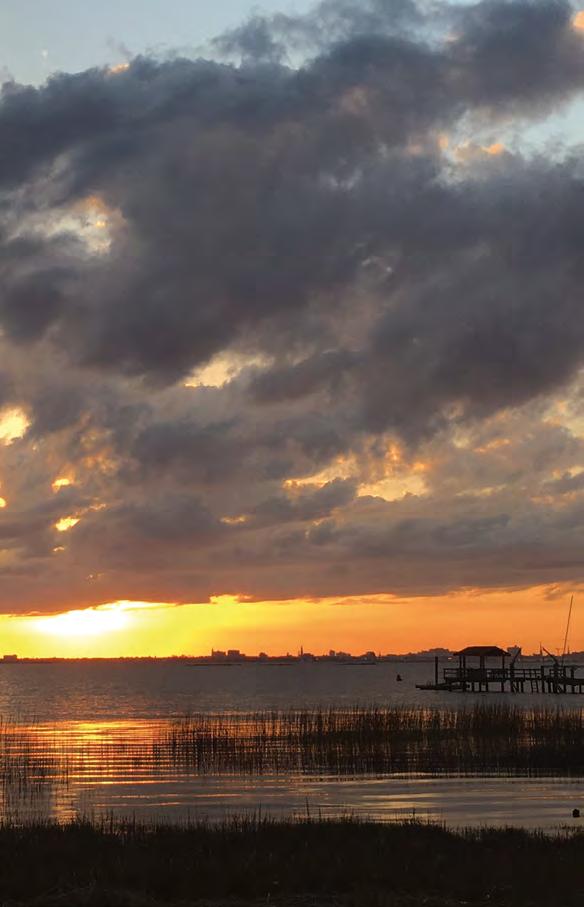



Born and raised on Sullivan’s Island, 92 year-old Doris Lancaster looks back on a life full of sand spurs, smiles, and soldiers.
By Marci Shore Photo by Vincent J. Musi“ You just have to stay still and take it all in. The beach is close to God. It’s peace, you see. - DORIS LANCASTER
Opposite page: Doris Lancaster, 92, pictured talking about the military dances on the island she attended as a teenager. She is standing in front of the Sullivan’s home she and her husband, Bob, bought in 1954.
Doris Lancaster, 92, beamed as she remembered the “grand time” she and her childhood friends had playing marbles, jumping rope, ying kites, hitchhiking rides to Isle of Palms to play the jukebox, and rolling old tires down the street at their home on Myrtle Avenue on Sullivan’s Island.
Crabbing, eating gs o her aunt’s tree, picking blackberries that were “so good,” and general “porch sitting” all surfaced with a smile as she recalled activities from a “simpler time,” when only one paved road ran through Sullivan’s Island to Isle of Palms, yards were wild, unmanicured and full of sand spurs, and the island crawled with young soldiers eager to nd dance partners for military galas. “ ere were so many blue crabs back then to catch in the ocean. ey were hungry for chicken legs,” says Doris. “You would put out a chicken leg or neck for bait and you’d soon see 5 or 6 crabs coming a er it. You could go out and bring back two big galvanized bins of them.”
Doris talks to me seated and masked in the living room of her Sullivan’s Island home on ompson Avenue purchased by her and her husband, Robert “Bob” Lancaster in 1954. She met the Florida-born Bob when she was 17 and he was 19. It was 1945 and he was a GI stationed on the island. ey were married a year and a half later.
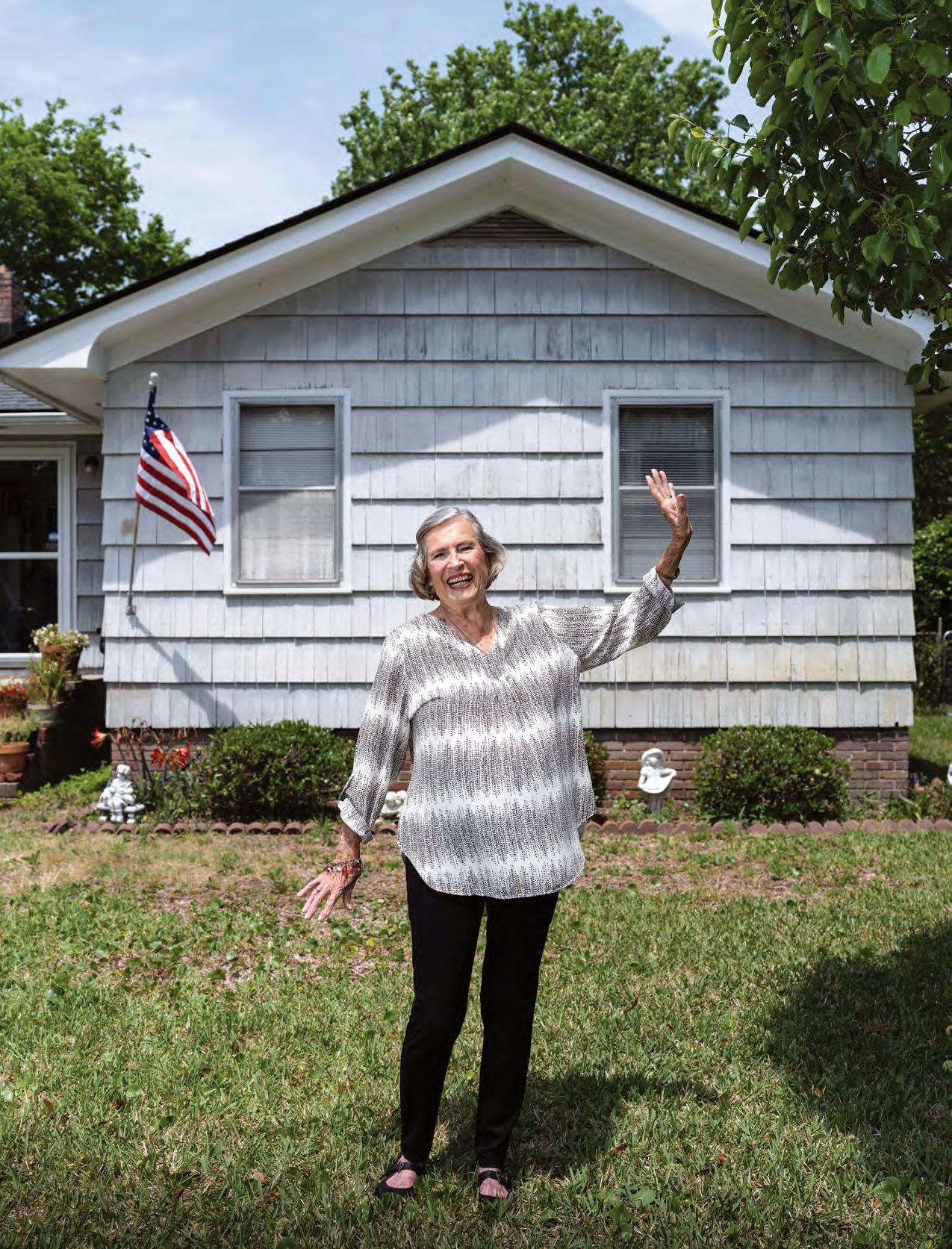


Doris was born in this house on Myrtle Avenue in 1928, and lived there with her mother, four siblings and grandparents. Her grandfather William Blanchard built the house. Part of it still stands today.
Bob rst saw Doris Sander walking on the beach while he was a lifeguard at Fort Moultrie. “I was with two friends and I was wearing a red, two-piece bathing suit. It covered everything though,” she recalls. “It wasn’t like the bathing suits today. He didn’t talk to us, but he decided he wanted me to be his girl.” She said it wasn’t uncommon for the soldiers to wave at them from the top of the Fort, or for the Coast Guard boats to send them signals, which they all quickly learned how to decipher.
Bob found out where Doris lived, and also found out her family had no telephone, but that a house a few doors down from hers did. He called the neighbor and soon they had a date to meet at the skating rink at the Recreation Hall, where the Fish Fry Shack and Island Club are now located.
“I remember some of the soldiers on skates were having a hard time standing up. ey were having to hold up one another. We were not impressed,” she says. Immediately impressed with one another though, Doris and Bob were soon inseparable, married and began raising a family on Sullivan’s. ey bought their house in 1959 and lived there 7 years until Bob was relocated to a job in Atlanta, as a Planner for the Army.
ey lived full-time in Atlanta for nearly 40 years, returning to Doris’ hometown to vacation every summer. A er the children were grown, Doris worked a while at a linen shop. “ e day that school let out for summer, we took the kids and le to come back here,” she says, with childhood memories of rampant sand spurs they tried to dig up by the root, and swarming mosquitoes being only bittersweet.
ey rented their Sullivan’s Island house out for a few years, just to pay the mortgage, and vacationed on Isle of Palms during the summer. It was too much work she said. “It was unreal what the renters did to our house. I certainly wasn’t going to sell my house either. We stopped renting a er a few years. We missed it anyway. We’re Sullivan’s Islanders.”
e Recreation Hall where they met, was also used as a Dance Hall. She said the military would go door to door and “practically beg” the mothers and fathers to allow their teenage girls to attend the galas, dances, and USO Shows, some as young as 14 years old. ey made a promise that they would all have chaperones. “ ere were so many military it was unbelievable. e dances were packed. At the end of a song, you’d get a tap on the shoulder to switch dance partners. We were in Heaven,” says Doris. “ ere was always supervision and boys weren’t allowed to take girls out of the dance hall. Of course back then, we didn’t allow boys to put their hands all over us like they do now.”
e dance cards of the single mothers were also o en lled, as mothers and daughters

Opposite page: “Showing off.” Doris trying on a dress that her sister was going to wear to a dance. “At the end of a song you’d get a tap on the shoulder to switch dance partners. We were in Heaven,” Doris Lancaster recalls of the dances held at Fort Moultrie during her youth.
alike would attend the galas. “ ere were a lot of older soldiers at the dances as well,” remembers Doris. Full orchestras performing Big Band music of Tommy Dorsey and Frank Sinatra lled the Rec Hall. Doris’ mother and sister worked at the Post Exchange next door. A er school events o en involved a show at the theater and candy. “Christmas was just so wonderful,” said Doris of the services at Stella Maris Catholic Church. “ ere were no material things. Just a manger, and Midnight Mass.” All of her family members got married at Stella Marris. A painting of Jesus created by her brother, Herman, hangs in the entryway hallway.
In their later years, when she and Bob enjoyed an occasional cocktail, their Sunday routine went as follows: Sunday Mass, back home for a Bloody Mary, then to Sullivan’s Restaurant, their favorite place to eat on the island. Doris’s family owned the restaurant on Middle Street for 32 years, until it closed in late 2020. Doris sleeps in the bed where her mother, Cecile, gave birth to her in 1928, only a year before the Stock Market crash of 1929 and ensuing Depression years. e middle child of ve, raised by a single mother, she never got to know her father. “It was kind of a theme on the island. ere were quite a few abandoned mothers and children. Of course back then, there was no help—no welfare. We managed the best we could.”
Her mother’s maiden name was Blanchard, a well-known surname on the island. She shares the Blanchard heritage with her third cousin, best-selling author of Lowcountry-inspired novels, Dorothea Benton Frank, who was also a Blanchard. e house on Myrtle Avenue was built by her grandfather. ere was no air conditioning. “We would sit on the porches, and I would push my bed near the window to get the breeze. Sometimes you just live with what you have to,” Doris explains. “Part of the house on Myrtle Avenue where we grew up, is still there. ey took o the back of the house and added an addition and a runway to it. ey told us they found some old marbles out front when they were remodeling it. I wish I could nd the money to be able to buy it back.”
Of her four siblings, only one of Doris’ sisters survives; she lives in Summerville and isn’t able to drive any more. Just up until this past summer, Doris and Bob were still driving. Despite the COVID shutdowns, they masked up and drove to the store to pick up groceries. Doris and Bob had four children. Her son, Larry, passed in 2020, along with her sonin-law, Larry Joe. is December, Bob, her husband of 72 years, died of cancer. “I just miss him so much,” she says, holding back tears. “I nd myself telling someone about the funeral and mistakenly say “wedding” sometimes.
“We just walked, and walked, and walked the length of the island. We rode bicycles as long as we could. ere is no better place in the world to ride a bicycle than here,” says Doris, recalling how she and Bob loved talking to people who visited the island. “We meet so many nice people and they get so excited when they learn we’re from here. We almost felt like we were disappointing them when said goodbye.” e
increase in tra c and tourism, mansions and meticulously manicured yards has in no way taken away the beauty of the beach for Doris. “I feel sorry for the people who are too busy. Too busy to listen and watch the ships go by. ey aren’t getting the same joy we had. It’s like God talking to you. You just have to stay still and take it all in. e beach is close to God. It’s peace, you see.” SiP SiP





Explore how six islanders adjusted to the COVID-19 pandemic and emerged stronger, wiser, and even more grateful for their coastal community. By Kinsey Gidick . Photos by Minette Hand.
LAST MARCH THE WORLD STOPPED. WHO CAN FORGET THE EARLY DAYS OF THE PANDEMIC WHEN SCHOOLS SUDDENLY SHUTTERED, SOCIAL DISTANCING WAS ANNOUNCED, AND WE ALL THOUGHT IT WOULD LAST A FEW WEEKS AT MOST? NOW, OVER A YEAR SINCE THE GLOBAL COVID -19 CRISIS UPENDED LIFE AS WE KNOW IT, SIX ISLANDERS LOOK BACK AT THE YEAR, THEIR STRUGGLES, SURPRISES, AND SUCCESS, AND SHARE HOW THEIR COASTAL COMMUNITY GOT THEM THROUGH IT ALL.



It was as much a surprise to Jess Patterson as it was to everyone else when lockdown elicited a sudden, overwhelming need for frosé. Essentially a wine slurpee, Patterson had developed a healthy following for his frozen concoctions at the Co-Op on Sullivan’s Island, but quarantine orders sent it into hyperdrive. “It obviously went explosive with the pandemic,” says Patterson. He does mean explosive. Sometime in between realizing that no one was going to be going much further than their front yard for a very long time and the epiphany that a libation might be just the antidote to get them through, people far beyond Sullivan’s discovered the Co-Op’s frosé. Overnight, Patterson, a former Wall Street day trader-turned-corner store-operator, found himself elding round the clock phone orders.
“Mount Pleasant found out about us. And then downtown and then Summerville,” says Patterson. Pretty soon he had to add delivery drivers to meet the demand. Even with the island closed to tra c, once Lowcountry residents discovered that a receipt for take-out could get them on island and closer to another bottle of avored frose, well, that only fueled the fever. “We gured out online ordering overnight,” says Patterson. “I just stayed up. I got so sh*tfaced one night and gured it out.” He says that’s why some of the language for the online menu looks a little wonky. “If you look at the description of the sandwiches, you can tell I’m just completely wasted because I’m making fun of the people that buy the sandwiches or I’m saying it’s not even a really good sandwich.”
What can he say? Like most of us, Patterson was in survival mode, something, it turns out, he and his family are all too familiar with.
Two years ago, Patterson and his wife gave birth to a baby girl. ree weeks later, his wife found out she had B-Cell lymphoma. She spent a year in the hospital and Patterson looked a er their daughter at home alone. “I’ve been in nance, so, you know, money is the only thing that matters to me. But once your wife has cancer, money means nothing,” says Patterson. at’s why the reaction to the Co-Op’s frosé has been so astounding. “I owe everything to the Town and my sta ,” says Patterson who opened a second location on Isle of Palms and has a third in the works for downtown. Having weathered the worst of a global pandemic by providing people a little respite from their stress, boredom and lockdown fatigue, his outlook on life has changed. “I was 15 years on Wall Street, rude customers complaining about a sandwich are nothing compared to what I had to deal with in nance,” he says. “If they’re complaining about a sandwich, they can f*!k o ere are real problems out there.”
Here’s a thing you can’t do with social distancing: pack a hot workout space with sweaty bodies. It just ain’t gonna work as Sarah Frick, a former Sullivan’s Island resident and owner of e Works based in downtown Charleston, a so-called “sweat studio” that o ers classes in yoga, HIIT, ow, and stretch, discovered last March. “I sent a text out to my girls,” says Frick of the message she relayed to her sta , “and I just said, ‘I’m going to somehow try to gure
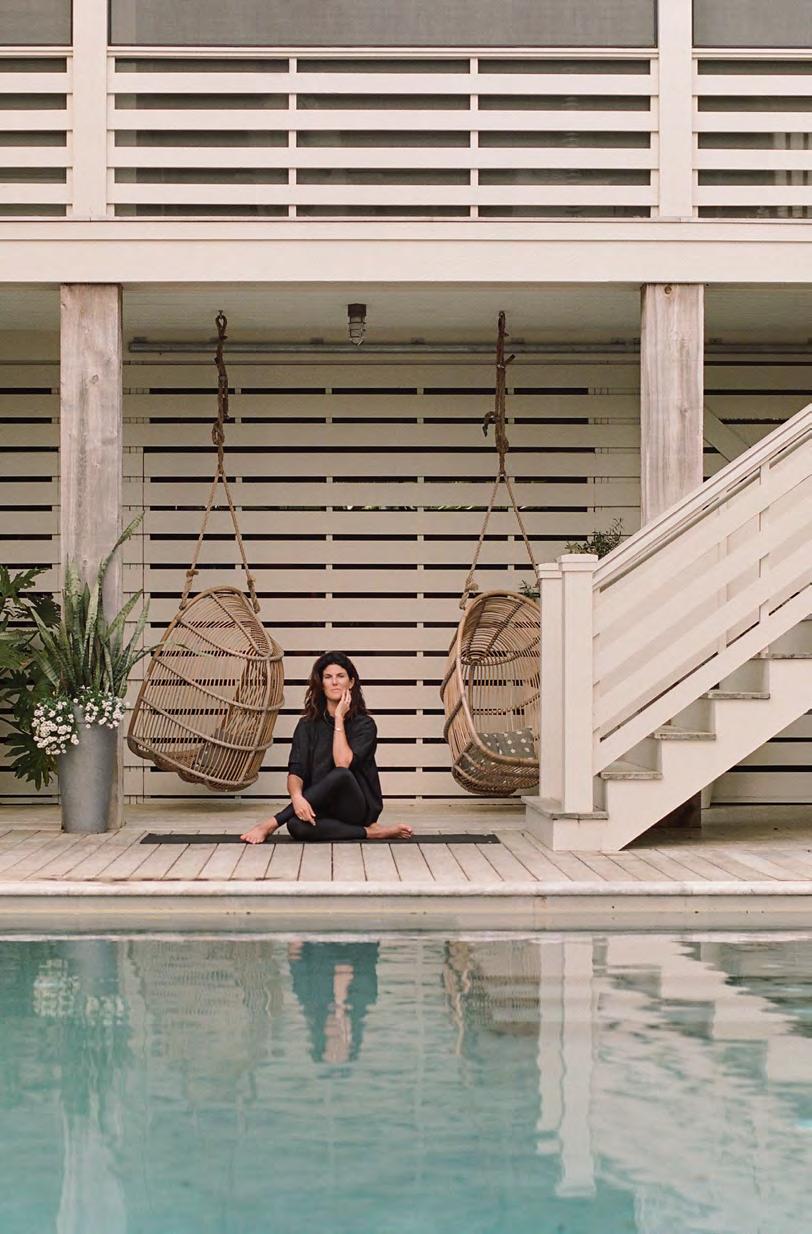
out a way that you guys can still teach. I can still pay you, but we can’t do it in the studio right now.’”
Like a lot of small business owners that meant moving to a virtual space and fast. Given e Works’ social media following, Instagram seemed like a natural choice, but Frick and her team quickly realized that the site’s regulations on things like music were causing major hiccups in digital workouts.
Naturally, Frick pivoted to Zoom. Suddenly, with a sturdy tech option, she had a virtual space to meet clients where they were —in their living rooms. “We would have like a hundred people on. It was crazy,” says Frick. “We were getting all these messages from people in Brazil and over in Europe that are like, ‘We found you through a friend and they’ve been talking about it forever. And now we get to try this class.’” But while the feedback was upli ing, the spirit of her tness program— one that’s earned e Works a legion of loyal clients—just wasn’t the same. “If we’re all in the room together, then the energy shi s and, you know, it’s not kind of that same vibe. So that was really hard,” she says. “And at the same time, I was building my second studio in Mount Pleasant. Nothing like opening a brand new business in a pandemic.” at’s why she reopened in July. Taking every conceivable precaution and being understanding of clients who didn’t feel comfortable returning just yet, Frick has kept e Works operating providing wellness during one of the worst health crises in human history.
“We always speak about the room as a microcosm of the rest of the world that we’re living in,” says Frick. “You’re brushing shoulders with people that might look di erent than you, that talk di erent than you, that have a di erent sexual preference than you, that have more money, di erent religious views, political views, all in this room and collectively doing this work together for the betterment not only of ourselves, but ultimately for the world. And if we can do it here, in these tight spaces where it’s hot and sweaty and the music’s loud and lights up and we’re moving, my belief is we can do it anywhere.”


“We had to close and I was freaking out.” at’s how Ashley Martin, owner and designer of Goldbug boutique remembers the arrival of the pandemic. Weeks before the virus spread, Martin, who makes her own jewelry and sells clothes and accessories at her Goldbug boutique on Sullivan’s Island’s Middle Street, had placed a large order for spring inventory. Suddenly she found her storefront lled with boxes of clothes and shuttered.
“ ank God I’d hired a web designer the year before to get the jewelry online,” says Martin. She quickly realized she’d need to expand her online o erings from just her original necklaces and earrings to the abundance of clothing items she’d recently purchased. “I put out an Instagram call for a model that day. I got a girl to come in and she tried on all the clothes. And I took pictures on my phone and put them up on the website,”
says Martin. “It was not very professional, but people were so supportive, it was amazing.”
Martin says that she went from thinking her business might be over to realizing that through the help of her loyal clientele, both on the island and o , she could make it through. And seven weeks later, with plenty of new hygiene protocols and signs that enforced masks, she was able to reopen.
Martin says the hardest part was having to be publicly vulnerable. At one point in the rst few weeks of lockdown she realized she needed to be honest with her shop’s fans and share her concerns. It was a humbling moment for a strong independent entrepreneur, but it made all the di erence, she says. “People stepped up,” she says. “I was able to live and pay some of those bills. And I mean, it was kind of overwhelming how amazing it was.”

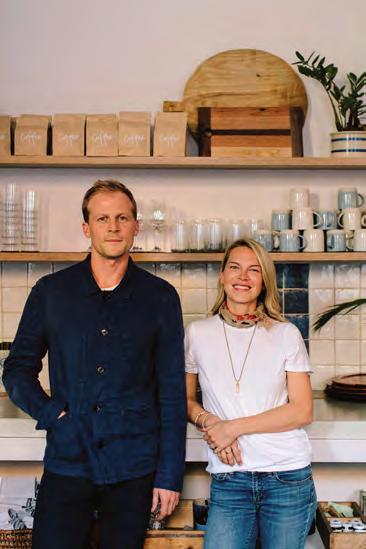
During the course of the pandemic, restaurateurs Ben and Kate Towill managed to keep their Wentworth Street restaurant, Basic Kitchen, a oat; opened Mount Pleasant’s Post House Inn in August; prepared for a Sullivan’s Island eatery; and welcomed a new baby, Iris—an unimaginable feat when you consider how hard the restaurant industry was hit last year. “Overall I think the last year for us comes down to a fantastic team that stayed on throughout the whole pandemic,” says Towill, a new Isle of Palms resident, of his success in the face of adversity.
Since the onset of the coronavirus pandemic, 17 percent of U.S. restaurants have shut down, according to media reports. In Charleston alone, as of July 2020, 75 restaurants had shuttered. And the Towills weren’t entirely untouched by closures either. His New York City restaurant Fat Radish was a victim of the pandemic domino e ect of an economic crisis. However, here in Charleston, with the help of committed sta and PPP funding, the small business owners have managed to see it all through.
As you might imagine, opening a restaurant, let alone an inn in the midst of a health scare, was a challenge to say the least. Fortunately, the Towills and their team bene ted
from the fact that the Post House Inn has ample outdoor seating. “It was kind of an amazing experience for us,” says Towill. “It felt like, how are we going to get through this?” But a focus on the locals in the Old Village paid o and people showed up at a time when they needed them the most. “We got that open and started kind of thinking, ‘Wow, we're going to get through this.’”
e Towills are hoping for an equally generous welcome from islanders this summer when they open their new sh camp on Sullivan’s. “We're trying to breathe life back into a restaurant that's been there since 1988,” says Towill, of taking over the space formerly occupied by Sullivan’s Restaurant for over 30 years. With construction underway, the casual, cozy space will serve fried sh and burgers, beer, and cocktails—basically everything you’d want a er a long day at the beach.
As they settle into their new role as IOPers, Towill says they're eager to give locals a spot that feels just as much theirs as it does a tourist destination. And working on a new project also feels like a fresh start a er a long, hard year. “Maybe I'm being super positive, but I'm excited to see what this industry does coming out the other side.”
 Photos courtesy of Basic Projects
Photos courtesy of Basic Projects

ere’s an art to asking a hotel guest to put on a mask, says John D’Angelo, Resort Manager at Wild Dunes Resort. “Masks are absolutely required here. We have the culture now where we just ask in a very friendly way. We all have our lines and our verbiage down pat, like, ‘I'm so sorry. Do you need a mask?’ ose kinds of questions where you're not saying, ‘Hey, you know, you need to wear a mask. It's like if you forget a mask or do you need one? I'm happy to give you one. You know, the verbiage is really important, creating a really positive environment here. And most guests are more than happy to comply, especially when you approach it that way with kindness and care.”
A hospitality expert, D’Angelo has learned more than just wise ways of diplomatically enforcing safety protocols during this unorthodox year. He’s established site-wide practices to ensure Wild Dunes guests enjoy all the comfort of a rst class resort stay that manages to feel like a real escape from the realities of the pandemic.
And it’s something even more people can enjoy at Wild Dunes now that its new Sweetgrass Inn is open. e Hyatt Destination began operations in March and D’Angelo says the site’s commitment to health and safety compliance really made the opening one of the easiest he’s been a part of. Sta follow a rigorous COVID-safety regime with daily temperature checks. Cleanliness remains paramount, and social distancing is required. But at the same time, says D’Angelo, there’s a feeling of freedom guests can enjoy and it’s already apparent that visitors and locals alike are ready to embrace it. “I'm very optimistic about leisure

demand, and that leisure demand is pent up. People need to get out. ey're hungry to get out. Our leisure pace is really strong,” he says.
For those in the Lowcountry looking to indulge a staycation or just want a break from the everyday, Sweetgrass o ers panoramic oceanfront views, enormous meetings space, and a roo op bar that D’Angelo says gives viewers some of the most incredible sunsets he’s ever seen. “Every night it’s a new piece of artwork you could put on your wall.” While a return to travel the way it looked pre-COVID is still a long way o , D’Angelo isn’t worried about the Sweetgrass Inn or Wild Dunes Resort. “We feel if we're positive, happy here, our guests will bene t from that a thousand times and it just makes it all worthwhile when you see the results.”


“How in the world do we continue to do church?” at was the question plaguing Reverend Chris Warner, the rector of Sullivan’s Island’s Church of the Holy Cross, last March. Overnight his busy Anglican church on Sullivan’s was forced to rethink its entire approach to worship.
Keeping their parishioners safe was their rst priority, so Warner and his sta got a crash course in technology. “We initially went to try to do it live,” he says. But the internet can be nicky on the islands and a er too many lapses in the church’s livestream, Holy Cross realized that option just wasn’t going to work. So instead, the sta manufactured a green screen overnight, recording services on ursday, then posting them for members to view on Sunday.
While it wasn’t the ideal situation—“I'm not sure that the whole online worship is what God had in mind,” Warner kids—it worked enough to keep members engaged and their spirits li ed through a tough time. And, as it turned out, it opened the door to new opportunities as well. “Our director of family ministries, Bethany, did miracles,” says Warner. Using the green screen, she put together a weekly children’s service starring a puppet named Sammy that became a big hit with the church’s youngest members.
A focus on small groups also helped Warner and his team not lose pastoral contact with their ock. And so, by the time state guid-
ance allowed for a return to limited capacity services, they were ready to welcome people back. “As Anglicans, we have communion every week. So that was something we had to gure out as well,” he says. To avoid unnecessary exposure to germs, the bread was consecrated in advance of the service and Holy Cross asked guests to sign up for communion ahead of attendance. “And then when they came to church and they checked in, they could download from a QR code onto their phones.”
Did it feel a bit weird? Sure, big screens instead of bulletins and sitting pews apart weren’t ideal, but Warner says the joy in seeing members return to worship together was worth the digital drawbacks. “One of the things that I've been very pleased with is that we do have a number of healthcare professionals in our congregation. As they’ve been vaccinated and come back to church, almost every one of them has told me how appreciative they are of the safety measures we've taken, and that they have felt safe coming back. at to me is high praise,” says Warner.
Easter was celebrated outside for the second year in a row to ensure the safety of everyone, but Warner says this year came with a renewed sense of hope.
“We got to celebrate with joy the resurrection of the Lord. And His resurrection is a sign that death is not the last word. And COVID’s not the last word either.” SiP SiP


and breeze-shooting
Redfishing at the Isle of Palms marina. By Hastings Hensel. Photos by Mic Smith.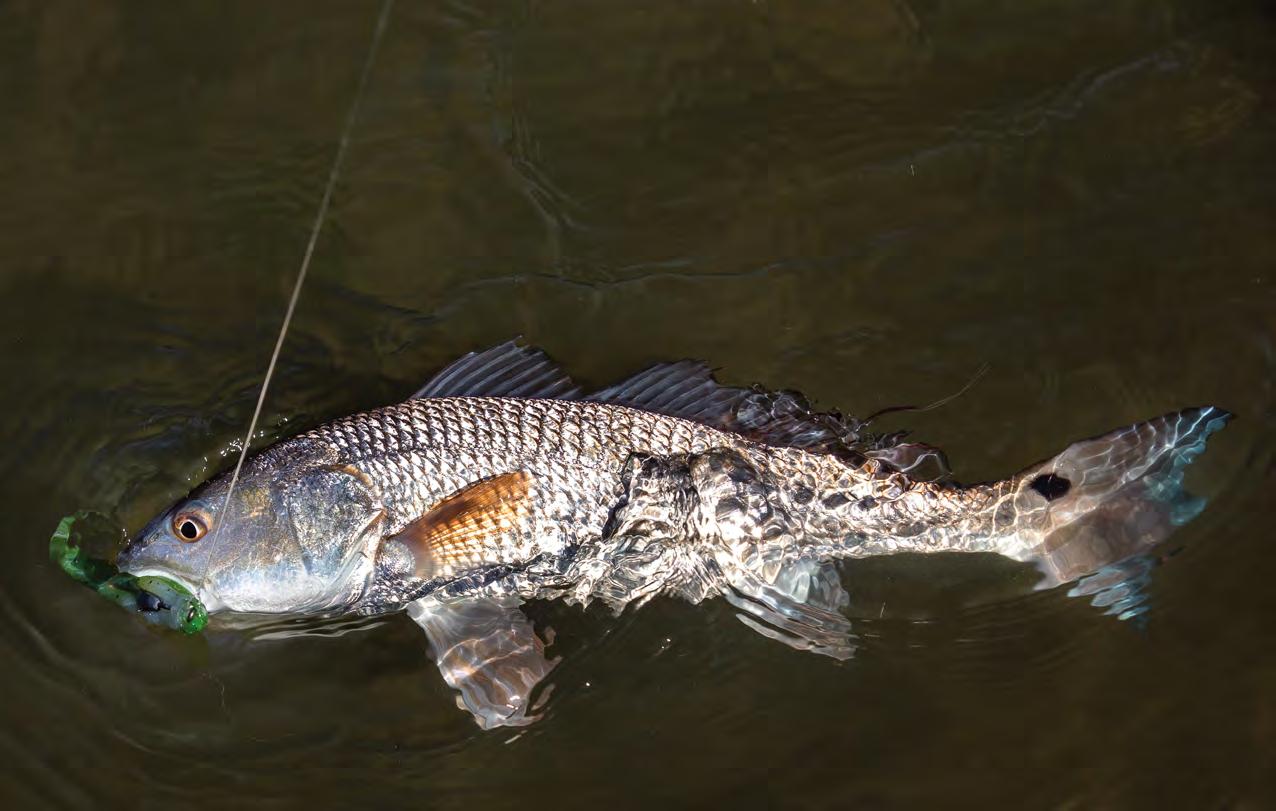
On the very first cast of the day—a chunk of blue crab lobbed between two dock pilings not five minutes from the Isle of Palms marina—the rod tip flexes, and charter fishing captain J.R. Waits whisper-yells the two words that every angler longs to hear: “Fish on!” I reel down as the redfish thrashes and tail-slaps in the falling tide of this early March morning, and we bring the fish into the boat.
It’s not the biggest red sh Waits has ever caught with a client—that would be a 48-pounder a girl hooked on her 13th birthday—but it’s a ne 28-incher, its scales glimmery and the dark spots on its tail and lateral line like an extra pair of eyes.

Captain Waits unhooks the sh gently and calmly, working not like a commercial sherman eager to ll-up the cooler, but like a shing guide who understands that the health of a shery is the health of his business. “I’m almost all catch-and-release,” he says. “I’m trying to get away from catch-and-kill, like, ‘Here are all the dead sh I’ve brought back to the dock.’ I haven’t kept a red sh in four years. I consider them my business partners, and I can’t kill my business partners.”
e way Waits talks—dedicated, knowledgeable, but also somehow entirely laidback—it’s clear he’s a man shaped by winds and tides, and the patience a life on the water requires. “ at’s just the way of life,” he’ll say when a dolphin disrupts a school of sh. “Some days they want it, some days they don’t,” he’ll say if there’s ever a day the bite is slow.
Having grown up shing the Wando River, Waits thought he wanted to be a geologist, but he soon realized that he didn’t want to spend every summer with his head in a microscope. Now, 25 years into guiding (17 of them from the IOP marina), he could work seven days a week in the summer, if he wanted to, with an estimated 60 percent of his clientele being returning customers. In the spring and summer months, he runs a 24-foot boat to the harbor and jetties for big “bull” reds and the near-shore reefs for cobia, amberjack, spadesh, king mackerel, and tarpon. In the fall and winter months, he trades in the big boat for his ats boat, sight-casting for red sh.
“Also, sometimes I take a two- to three-hour trip for bonnethead and blacktip sharks,” he says. “People tend to like that because you can give them a reduced price, and the sharks are extremely predictable. It’s a huge hit with the eight-year-olds.”
Before we release the sh, Captain Waits guides me through the art of holding it for a picture. You pinch two indentations behind the pectoral ns with one hand and cup the head with the other, smilingly extending the red sh for the camera. It’s an iconic shot, really—the reason that many of the estimated hundreds of thousands of people, locals and tourists alike, ock to the Isle of Palms marina each year. A er all, by their very nature, marinas are to coastal communities what coral reefs are to oceans—gathering places of life and business.
“ e marina used to be just a place to launch your boat for a day on the water, but now it is a destination,” says Brian Berrigan, the marina’s president who’s been managing the marina since it was purchased by the City of Isle of Palms in 1999. “I like to think of it as a one-stop shopping for water-based activities. One can launch their boat with their family, rent a boat, if they don’t have their own, go on a shing charter with some of the best guides in the east coast, rent a kayak or paddleboard, or go on an environmental education tour with Barrier Island Ecotours.”
Captain Waits, for his part, agrees. One of 10 charter captains operating out of the marina, Waits points to a healthy camaraderie among them. “We’re all really close out here,” he says and although they won’t always share their shing locations, they’ll give each other any over ow of customers. He also cites the advantage of working out of Isle of Palms, as opposed to Shem Creek or Toler’s Cove, in that you don’t have to cross the harbor and are therefore “closer to the sh.”
A er the rst sh of the day, though, the
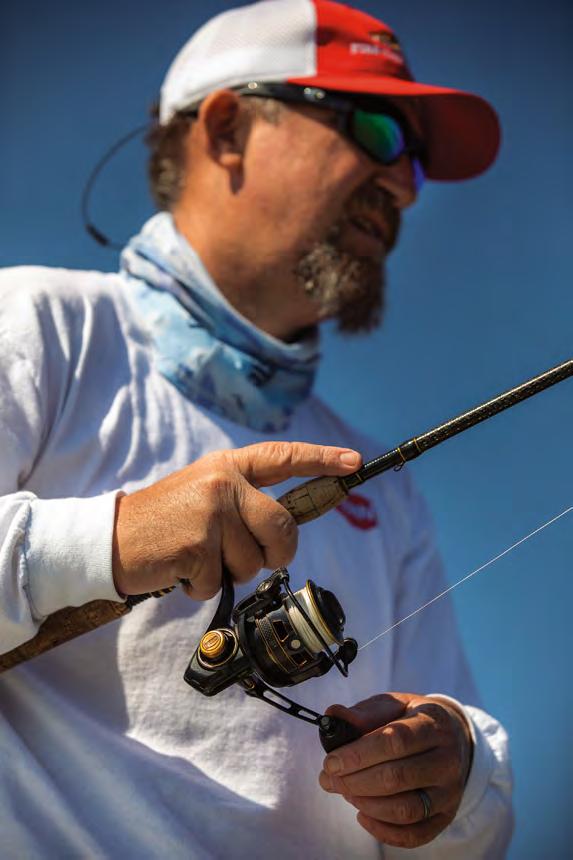
Some tried-and-true tips and tricks from Captain J.R. Waits for hooking up with a redfish in the ICW
Look for movement in the water, especially at low tide when there are less places for fish to hide.
Usually, it’s best to get out there mid-morning in the spring and even earlier in the summer—not too early before the bite warms up, but not too late when all the other anglers have spooked the fish.
If you see fish, you ideally want to cast in front of them. If at first you don’t succeed, try, try again with new baits and new lures.
A lot of times, once you get one to bite, the rest of them start to bite, too.
Catch-and-release promotes the fishery of the future.
Rod: 7-foot Penn Battalion “Xtra Fast Action”
Reel: Penn Clash II size 2500 or 3000
Line: Spiderwire Invisi-Braid size 10- or 15-pound
Leader: Berkeley Pro-Spec 25-pound fluorocarbon
Hooks: 1/0 Circle Hooks
Baits: Live blue crab declawed and quartered, shrimp, mullet, menhaden, mud minnows
Lures: Z-MAN JERKBAITZ locally-made in Summerville
bite suddenly turns o . Captain Waits draws up the power pole from a fob attached to his belt loop, and we begin sight-casting in the ats. “Days like today in a slick calm?” Waits says, standing atop the tower of his ats boat, push-poling us along a er we’ve motored up towards Awendaw. “Any movement they make in shallow water, you have a good chance of seeing them, and they’re almost always red sh.”
is isn’t “tailing”—when red sh suck crabs out of holes in the grass at high tide, usually in the warmer months—but we look for other tell-tale signs, like dark spots in the water that could be schools. Waits instructs me to blind-cast a jerk bait between 11 o’clock and 2 o’clock, and to jig it like a bass worm. Red sh are sight-feeders, and if I can get the bait right in front of them, we might be able to land Number Two.
But the beauty of the bite going cold on the Intracoastal Waterway is, well, still the beauty. Pelicans land on oyster banks, and a bald eagle perches on a barnacle-encrusted piling—all under a cloudless, blue sky. Stingrays dart beneath us. A crabber motors by, and we salute him.
A sherman, though, can’t have his head in the clouds for too long. We switch from jerk baits to mud minnows, and Waits says, “In the spring, you’ve got to have a lot in your arsenal. Otherwise, you get zero. Some days you just gotta keep changing baits until you nd something they want.” is proves prophetic, for just then Captain Waits cries: “ ere he is again! Good one, too!”


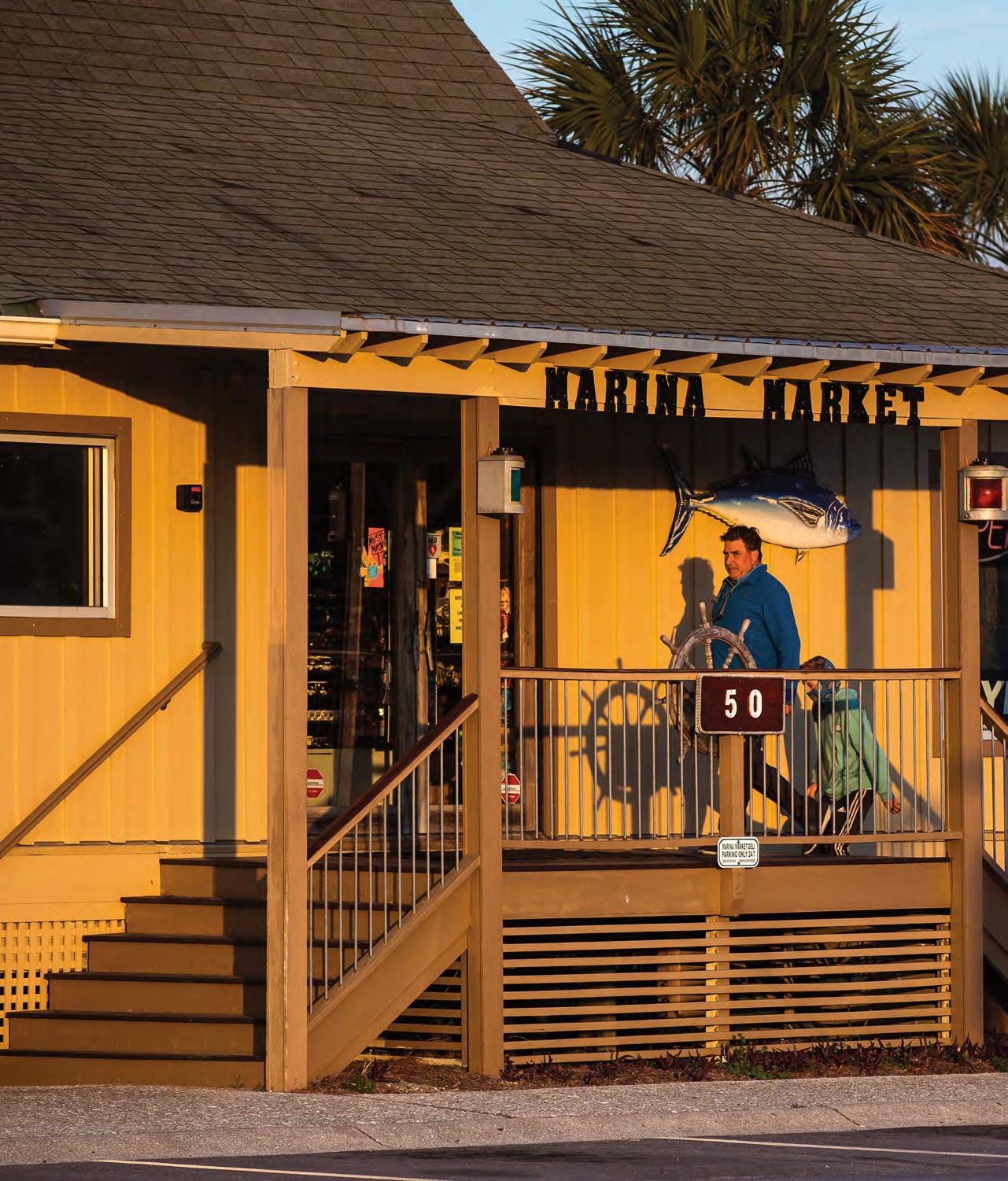


All told, we catch (and release!) four red sh before the wind cranks up in the a ernoon and we head back to the marina for a well-deserved lunch at Saltworks Dockside Deli. e deli’s owner, Mark Welker (pictured above), greets us and tells us that, a er years in the corporate restaurant world, working at the marina is, literally, a breath of fresh air. “It’s really a feeling of community,” says Welker. “It’s been cool because I’ve seen people meet here, get engaged, get married, have kids. It’s an incredible environment.”
And the burgers and fries he serves us are utterly delicious, con rming both Brian Berrigan’s and Captain Waits’s claim that it’s “the best lunch in town.” A er lunch, with no sh to clean, but plenty of photos to scroll through, I step outside, where already by the sh-cleaning station a small crowd of beerdrinkers and breeze-shooters has gathered. ey aren’t quite “the old timers”—those who arrive each a ernoon, as regular as the tide, to solve the world’s problems—but they all appreciate the marina in their own right.
“ e marina is a staple in this community,” city councilman Ryan Buckhannon says. “My wife calls it my Facebook,” says fellow councilman Philip Pound. Brian Berrigan, for his part, is thinking deeply about the marina’s future. “ e trick is balancing the needs of the residents, who own the marina, and the visitors, who spend the vast majority of the money being spent at the marina,” he says. Either way, he says, “To me, the marina is all about family and creating positive memories, especially for kids. Most of what we do is with the kids in mind. Happy kids make for very happy parents.”
Dr. Kathy Reichs is a forensic anthropologist and academic turned crime writer who makes phalanges and carpals exciting. In honor of the release of her twentieth Dr. Temperance Brennan novel—the character who spawned the hit TV series Bones —she sits down with Jennifer Pattison Tuohy at her Isle of Palms home.
Photos by Minette Hand


 “The Bone Code” is Kathy Reichs’ twentieth Temperance Brennan book. A crime thriller set on Isle of Palms and in and around Charleston, it delves into the dangers of genetic manipulation and contagious, flesh-eating diseases. The novel is published July 6, 2021.
“The Bone Code” is Kathy Reichs’ twentieth Temperance Brennan book. A crime thriller set on Isle of Palms and in and around Charleston, it delves into the dangers of genetic manipulation and contagious, flesh-eating diseases. The novel is published July 6, 2021.
As is the case with many of us who grew up on a steady diet of Indiana Jones movies, Dr. Kathy Reichs wanted to be an archeologist. And while her eventual career does indeed deal with mummies, it’s more along the lines of “mummifed, burned, dismembered, decomposed and mutilated skeletal remains,” she says. “It takes a certain psychological makeup to do this. If you’re squeamish it’s probably not the job for you.”
at job is a forensic anthropologist. A little-known specialty— there are barely more than 100 certi ed in the profession—forensic anthropology is the analysis of human remains in criminal investigations. When the police have a dead body they can’t identify through the usual methods, they turn to a forensic anthropologist. Using physical markers on a skeleton, the scientist makes estimations about the age, sex, stature and race, as well as attempt to determine other potentially identifying features such as cause of death, past trauma and diseases.
Reichs, who is originally from Chicago, started her career with a degree in Anthropology from American University in Washington, D.C. A professor there turned her on to the idea of forensic anthropology. “I was really intrigued by it, but I just didn’t think I’d ever be doing it,’ she says. However, her work in anthropology slowly drew her into the fascinating forensic eld, and she soon found herself separating and identifying co-mingled body parts in Québec (where she is a consultant to the Chief Medical O cer), exhuming mass graves in Guatemala, testifying at the United Nations Tribunal on Genocide in Rwanda, identifying war dead from World War II, and recovering remains at the World Trade Center. All this, alongside the regular work of identifying murder victims, examining the bones of potential saints, and dealing with run of the mill “skeleton in the woods” a airs. “I like the relevance of it,” she says. “I love archaeology, but you’re not going to impact anyone’s life. When you testify in court or you ID a missing family member, you are going to impact someone’s life.”
While her job takes her all over the world, Reichs is based in Charlotte, NC, where she is a Professor of Anthropology at the University of North Carolina-Charlotte. It was here that she began her second career—New York Times bestselling author. It was the mid-nineties; she had just made full professor so had latitude with what she could do with her time. She decided to write a crime novel. Having just completed work on a serial murder case the idea was there. She just needed the nerve. “I thought, ‘Well, I’m going to try this, even though I don’t know what I’m doing.’ I did it in secret, pretty much.”
Her debut novel, Deja Dead, was published in 1997 and became a New York Times bestseller, winning the Ellis Award for Best First Novel. Her heroine, Dr. Temperance Brennan, is a thinly veiled version of herself. “Professionally, she’s based on what I’ve done,”
“It’s been evolving, I've taken this weird specialty in bones and parlayed it into a variety of contexts.”
“When that baby came in with a wooden stake driven through its chest. That was tough.”
says Reichs. “ ey diverge in her personal life. She’s not married; I am. She works both in Montreal and the Carolinas; I do that. She’s got one grown daughter; I have three children. She’s a recovering alcoholic; I’m not, obviously—I have a wine cellar…!”
More novels followed, as well as a series of young adult books called Virals. As a female scientist, Dr. Brennan is something of a STEM heroine. “I’d have people come to my signings and say ‘Is it okay if my daughter reads your books? She’s 7.’ And I’d say ‘No! It’s not okay.’ So that’s partly why we did the young adult series—Brennan’s 14-year-old great niece and her three friends solve puzzles and cold cases.” She co-wrote them with her son, Brendan Reichs, who is on the Board of Directors of Charleston’s YALLFest, an annual celebration of young adult ction in Charleston.
Soon Hollywood came calling, with TV Network FOX turning her series of adult crime-thrillers into what became the network’s longest running drama. Bones was a weekly procedural crime drama in the vein of CSI, loosely based on Reich’s books and by extension, her own life and career. e heroine, Dr. Temperance “Bones” Brennan, was played by actress Emily Deschanel and Reichs took on the role of producer, plus penned ve scripts over the show’s 12 seasons. “I didn’t plan to do any, but the showrunner asked, and I said, ‘I’ve never written a screenplay.’ And he said, ‘Well, you’d never written a novel either.’” Reichs thoroughly enjoyed the experience. “I loved it. Let me just say at the outset, I’m not one of these authors who says, ‘ ey took my work and they ruined it.’ I loved what they did with it. I loved our writers, and our production crew, and our on-camera people.” Reichs remained based in the Carolinas while the show was shot in LA, but she visited the set o en and worked with the writers remotely. “I would read every single script, and get input on every single script, and then when you write the episode, they do want you there on set.”
Not surprisingly, the role of best-selling author slash hit-TV show writer/producer took over and Reichs stepped back from actively working on cases. She now considers writing her full-time career. “I miss it, but I was never happy [doing it all]. When I’d not get a call to go to the lab, I’d think, ‘What the hell, why aren’t they calling me?’ en when I would get a call, I’d think, ‘Well, I don’t have time for this. I’ve got to nish the book.’” She’s not out of the game completely. “I’m still available if they need someone, for a high-pro le case, for example.”
Speaking of high pro le, as a leader in her eld, Reich’s career has included a number of headline-grabbing cases. She was the forensic anthropologist on Casey Anthony’s defense team, the woman whose 2-year-old daughter’s bones were discovered in the woods near her home, and she studied the corpses from the 1994 murder suicide of the Order of the Solar Temple cult outside Montreal; an event that inspired her second book Death du Jour e cases involving children are the toughest she says. “When that baby came in [from the cult case] with a wooden stake driven through its chest. at was tough.”
Reichs lives in Charlotte with her husband, Paul, an attorney, where alongside being a professor at UNCC she also consults for the Chief Medical O cer in North Carolina. But the couple has also called Isle of Palms their second home since before Hurricane Hugo. en she had a condo in Wild Dunes that was damaged by the hurricane in 1989. A er xing it up she sold it and bought her rst beach house on Ocean Boulevard. And she hasn’t moved since, well other than a few doors down. A er renovating and selling the rst house, she bought a second further down the beach, and just last year sold that to build a brand-new house on the Boulevard. “We really like this stretch of the beach, it’s a little quieter, there’s no parking. Hopefully it’ll stay that way.”
Reichs spends as much time as possible at her beachside retreat. “I come down as o en as I can, but probably at least once a month and then for almost the whole summer,” she says. “My oldest daughter, Kerry [also an author], brings her kids down as soon as they are out of school. en we’re always here with the whole family for anksgiving and Easter.”
Along with building a new house, she just bought a golf cart and her grandchildren are looking forward to decorating it for all the various Island parades. She rode out much of the pandemic here, too, and says she enjoys the seclusion of life on a barrier island, spending most of her time right at the beach. “I love going down to the beach, hanging out with the kids at the pool. We don’t do a lot else; I tend to just want to get here and stay here.”
Reichs’ also works while she’s here. As well as being based on real science and inspired by real events, her novels are always set in locations she’s spent time in. Which means Charleston and Isle of Palms frequently make an appearance. “I’ll never write about someplace I haven’t been,” she says. “You’ve got to really be there, smell the smells and taste the tastes.” Her work is incredibly evocative, while never bogged down in unnecessary detail. Just those needed to feel like you’re right there with Temperance in the sugar shack or surveying the damage the day a er a hurricane hits. “Sometimes it’s the place I want to go. I have a colleague who’s a Biblical archaeologist who presented an idea to me around some intriguing old photographs of bones found near Masada. I thought that’s a great idea, and I get to go to Israel.”
Her newest novel, e Bone Code, set for release on July 6, 2021, opens with a very familiar scene; a hurricane barreling down on Charleston. A chunk of the action takes place in a beach house on IOP, and in Charleston itself, where the storm has washed up a medical waste container holding two decomposed bodies. Plus, a esh-eating bacterium has been unleashed on citizens of the Holy City. is is Reichs’ heroine’s twentieth outing and nds her tackling some of the larger ethical conundrums in the eld of science. e author, too, has a challenge to consider. Will she continue Temperance’s story or move on to something new? “I’m about to sign a new contract for two more books and I have to decide whether to wrap up the series,” she says.
If she does wrap up the Bones series, she’s considering beginning fresh with someone new. “Maybe a completely di erent character, a di erent specialty,” she muses. “I just wrote a short story about a character—I can’t say a lot about it because it hasn’t appeared—but it’s a very di erent character.” When she re ects on more than two decades telling Tempe’s (and her) stories and on a career that is remarkable from every angle, she feels pretty good. “When I nished my doctorate, I thought I would play out my career in academia. But one day, in the 80s, some cops just showed up at the lab saying ‘We want you to help on this case...’ and that was the beginning of it all.”

Dr. Reichs in her home office in her new Isle of Palms beachfront house. “I’ll be sitting at my computer, looking out those windows … and see the family heading down the beach with their toys and chairs,” she says. “So, I try to knock off at lunchtime!”

Two decades ago while on vacation, Julie Cooke had a vision that prompted her to swap a drab cubicle for a sundrenched art gallery on Sullivan’s. She tells Carol Antman how she brought art to the beach.
In 2001 rumors were spreading on Sullivan’s Island. The island’s artists were intrigued. An art gallery? In their sleepy beach town? The sounds of renovation were coming from the tumble down former convenience store, Mr. Gruber’s Wishing Well on Middle Street.


Darlington has spent a lifetime capturing the timeless beauty of the charming cottages, ancient oaks, rustling palms, marshland and seascapes on canvas. His realist/impressionist style and honed artistic license remove distractions—helping the viewer see the beauty in the ordinary.
“It was a hole in the wall, a place I tried to avoid,” said island artist Leslie Pratt- omas. It was next to the Îsland’s only restaurant at the time, Sullivan’s Seafood. e idea “seemed brave to me,” because even though the Island drew some tourists, “there wasn’t much of a cultural life here in 2001,” Leslie says. Island painter Beth McLean recalls that “It was an exciting idea but you had to kind of wonder if it could work.” Twenty years on, and Sandpiper Gallery is still going strong.
When Julie Cooke rst looked through the greasy window of that abandoned store, straining to see past crates of cast o table parts, rusty photo nishing equipment, and bins of wine bottles whose labels had peeled o in Hurricane Hugo’s ood waters, she saw something no one else could: an art gallery e place looked so wild, with a collapsed roof and animals nesting in it, that when the contractor came to assess the job, he halfjokingly said to Julie, “I brought a measuring tape. I didn’t know I needed a shotgun!” It took 14 dump trucks to clear the place out. ey tore the building down to the studs.
Julie had spent 15 years working in a cubicle as a process engineer and was eager for a change. Her mom was an art teacher and Julie’s childhood was full of visits to galleries and museums. She’d dabbled in batik and watercolors and earned a degree in product design. But when she and her then-husband le Raleigh, North Carolina, to vacation on Sullivan’s Island, they had no inkling they would impetuously rent a derelict store and embark on a whole new venture. “Maybe we lost our minds for awhile,” she says. But at least she had escaped the cubicle. A er six months of renovation, on September 15, 2001, Sandpiper Gallery opened with 10 local artists on display.
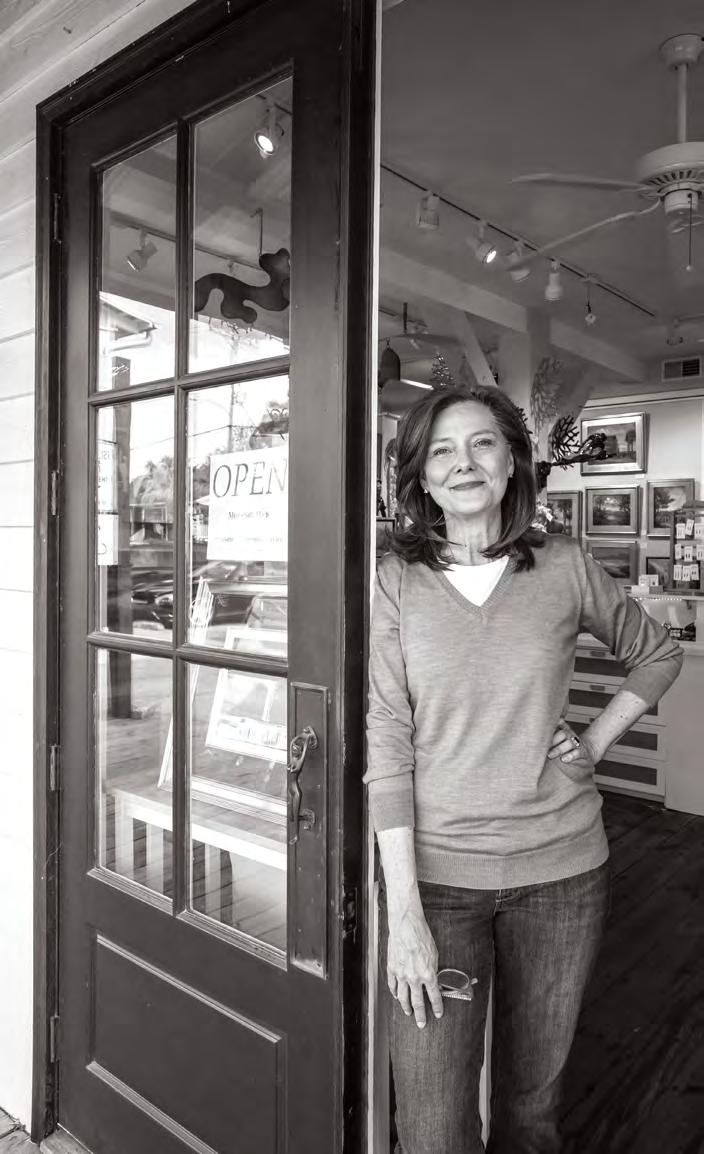

While they hammered, hauled and scraped to get the gallery going, curious artists wandered in. Jim Darlington knew that Charleston was beginning to be known as an art town, fuelled by the Spoleto Festival, which began in 1977. But “the art was all about going hunting, lling up an empty space on the wall,” he says. So, he poked his head in one day to see what was going on. Julie’s vision to bring more ne art to the community seemed like a good opportunity for him. He was right. Twenty years later, his exquisite plein air renditions of Island landmarks are among the gallery’s best sellers.
Initially, some people were a little confused by an art gallery on the island. “A very elderly islander walked in the front door—it felt like it took him 19 minutes to reach me at the desk,” Julie remembers. “He stopped, sighed and said, ‘I’d like a hotdog with slaw and mustard to go.’” ere were other odd requests. “We had a guy draw a picture of himself proposing to his girlfriend, asked us to hang it on the wall so he could bring her in, let her see it and then propose to her,” Julie remembers. ere were poignant moments, too. “Beth McLean had just brought in a gorgeous nocturne painting of Stella Maris Church,” recalls Julie. “It was nighttime when I was putting it in the window and I saw a car’s brake lights come on as it stopped just past the gallery and then I watched it back right up to the window.” e couple in the car had been married in the church on Sullivan’s Middle Street 25 years earlier and had returned to the island to celebrate their anniversary. Needless to say, that painting went home with them.
Artists’ careers have been made at the gallery. Leslie Pratt- omas was thrilled to have her painting of an ibis chosen to hang for three years in Dakar, Senegal, as part of


McLean uses an intense color palette and impressionist technique to create her light-filled oil renditions of Lowcountry scenery and people, inspired by the glowing light in the landscape and the faces of the South.


Leslie Pratt-Thomas has won numerous awards for her atmospheric oil paintings of Lowcountry scenes. She has studied with mentors all over the world and now teaches to share her expertise. "Painting is what I do...a part of who I am. There is nothing else I do in which I feel so fully engaged," she says.
the Art in Embassies program. Jim Darlington received his largest commissions through Sandpiper and Leslie’s painting of I Can Fly was chosen by Mary Alice Monroe to be the cover for her novel Swimming Lessons Julie also suggested turning that image into a giclee, which became Leslie’s best seller. In 2009 she was asked to illustrate Shackles, a children's book written by South Carolina Poet Laureate Marjory Wentworth. “ e gallery has a nice vibe, a happy, colorful vibe and that shows up in my artwork,” Beth McLean says. Artists appreciate being relieved from marketing their work since the gallery puts out consistent social media and press releases. ey are free to just create. “Without her I know I wouldn’t have been able to get as much work done as I have,” says Jim Darlington.
Having started the gallery with just 10 artists, Julie now exhibits work from over 80 painters, sculptors, jewelers and ceramicists. Most are based in the Southeast but some are from as far away as Europe. Julie sources the new artists from art industry journals, juried shows and recommendations from trusted colleagues, but she also receives inquiries from hopeful artists almost daily. She uses a quote from Paul Klee to inspire her choices: “Art does not reproduce the visible; rather it makes visible.” Nuanced paintings of sea life, palm trees, beach scenes and other everyday images captivate. “Art is a soulful thing,” Julie says. She’s also adamant that “I don’t want people to come in and think they can’t a ord anything,” which results in price points that span from a few dollars to thousands. Visitors looking for a memento from their trip may be drawn to pendants by Emily Cook containing sand from local beaches or beautifully cra ed little tables by Pete Rock with woven Sweetgrass table tops by Adeline Mazack. Many who stop in are o en excited to nd artistic representations of their family or vacation homes. Lowcountry landscapes are the biggest sellers with many repeat customers and collectors among the clientele. Interior designers especially appreciate the option to take art on approval and hang it for a few days to see how it works.
A er a little over a decade in its rst location, Sandpiper moved a couple blocks up Middle Street to where several restaurants provide more foot tra c and higher visibility. Julie is particularly skilled at styling the space, especially what she calls her “magic window.” People stroll by, ice cream cones in hand, and are captivated by the art. Julie delights in driving by a er dark when the windows glow: “It’s really fun to drive by at
night and see people pointing to the art.” Art lovers are fond of Sandpiper’s well-attended art openings. Festive crowds stream out onto the sidewalk enjoying “woo-hoo” punch, chatting with neighbors and meeting the artists. e openings o en bene t local causes like the Battery Gadsden Cultural Center.
As Charleston’s arts community has grown, Sandpiper has become the center of the Island’s cultural life. It’s a more sophis -
ticated scene than any resident of the sleepy beach town of 20 years ago could have imagined. It’s the product of Julie’s vision to combine the ingredients she recognized in the piles of debris in the ramshackle storefront with the Island’s beauty, local talent and a dash of her business acumen. But she shares the credit for the gallery’s success with the community that values the importance of art and artists. “I could not have asked for a more supportive and artful community!”


Dr. Gregory has assembled a fabulous group of talented professionals, each an expert in their felds, to make the next step in your dental care that much easier. From preventive care and general dentistry, to cosmetic dentistry, dental implants and root canals, our commitment to providing world-class dental care is unlike any other dental offce in South Carolina, and you can always see that in the quality of our patient’s smiles.
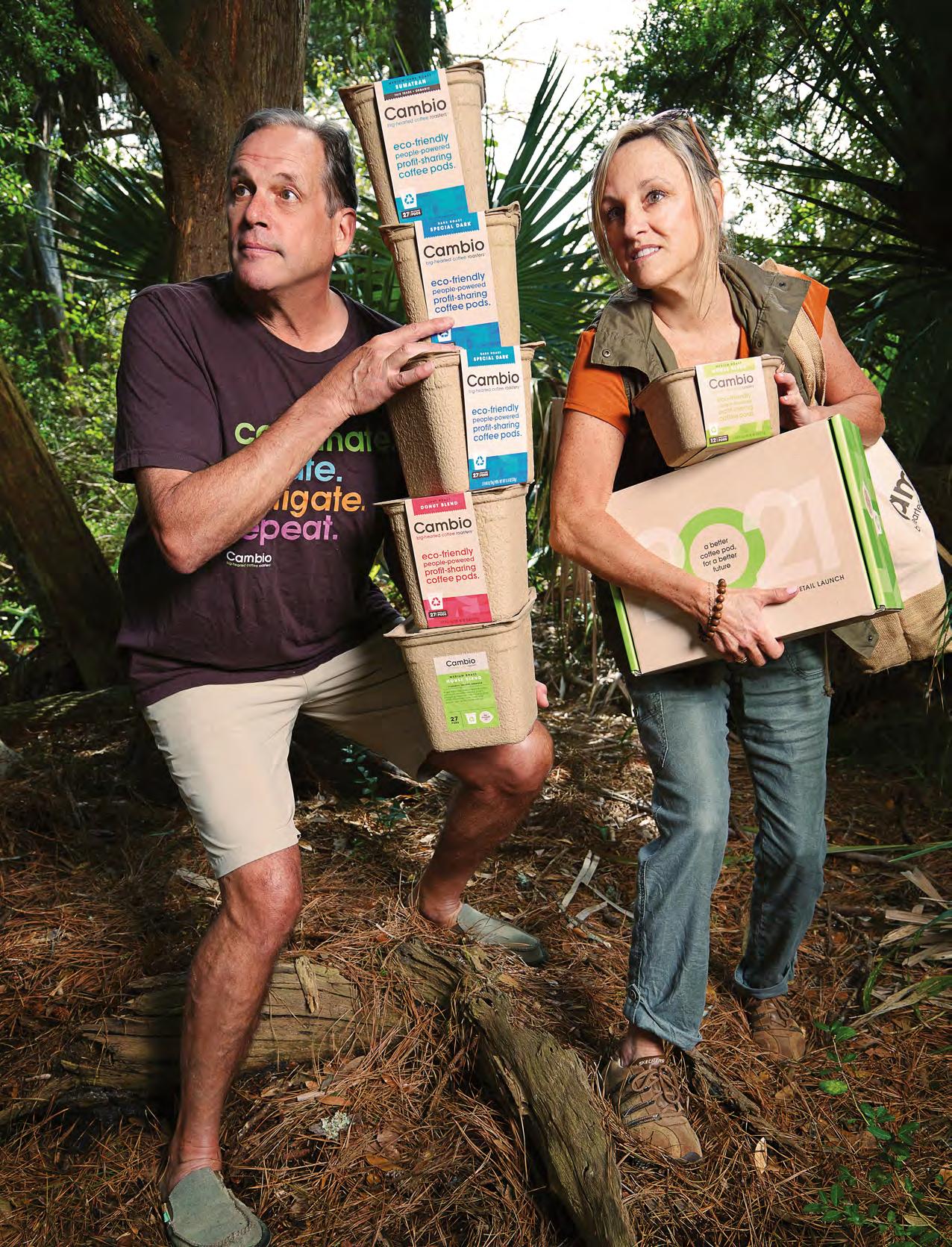
Catch a glimpse of islanders following their dreams and passions into the stratosphere.
By Meghan Daniel Photos by Mark StetlerPeople, planet, pro t. ese are the tenets of the triple bottom line framework that Isle of Palms residents and couple Ann Hutson and Kevin Hartley have built their business on. “ e idea is, you still have to be in business and have to succeed or you can’t do any positive change,” says Hartley, co-founder of Cambio Roasters, purveyors of eco-friendly co ee pods for Keurig-style machines. “But you also keep an eye for the environment you’re creating for your employees, partners and for environmental stewardship. What Ann and I do is wrap that up in this really fun project.”
Hartley, a former Chief Innovation and Product O cer at Keurig, the company that made the co ee pod a household name, and wife Hutson, an avid community volunteer who traded her career in marketing and communications for a few thousand cups of co ee, launched Cambio Roasters in 2018. eir threefold business model—encapsulated in their mouthful of a motto: “eco-friendly, people-powered, pro t-sharing coffee pods”—is what di erentiates their roast and draws customers in, they say.
Cambio Roasters takes care of people by donating 20 percent of pro ts to Food 4 Farmers, a nongovernmental organization that helps co ee farmers and their families overcome food insecurities during seasons when farmers are neither growing nor harvesting and income is practically nonexistent. is partnership, Hutson explains, allows them to develop relationships with the farmers who make their business possible. e couple also say their company protects the planet because once you remove the patented easy-peel lid from their Cambio Roasters’ K-cup pods the whole co ee encasing pod is ready to head to the recycle bin. Hartley says “the environmental aspect was the centerpiece” of their idea. Currently the product is sold on the company’s website and on Amazon, but the goal is to have Cambio Roasters co ee stocked on retail shelves across the country—which will help increase pro ts and therefore the amount of money donated to Food 4 Farmers. e company’s name re ects the couples' personal and professional values. Like a perfect blend with all the right avor notes, “cambio,” Spanish for “change,” embodies what they aspire to be and do in one word. “We want to change the way business is done, one delicious cup at a time; to change people’s morning experience with our delicious small batch roast; to change the lives of farmers by giving back; and to change the number of pods in land lls,” says Hartley. e Spanish word in the business’ name is also a homage to the predominantly Spanish-speaking co ee farmers whose livelihoods consist of growing the fruit that yields the co ee bean that keeps customers ca einated.
Prior to the COVID-19 outbreak, Hartley and Hutson prioritized annual business trips to co ee regions like Colombia and Costa Rica, where they met the growers and saw rsthand the two-to-four acre plots, nestled precariously on the sides of mountains, where co ee crops are farmed year a er year.
e journey from bean to brew, the couple agrees, has been equally rewarding as it has been challenging. Ultimately, Hartley says of their approach, “We do try to think big in terms of impact in the world: start small and learn really fast.”
- Meghan Daniel“

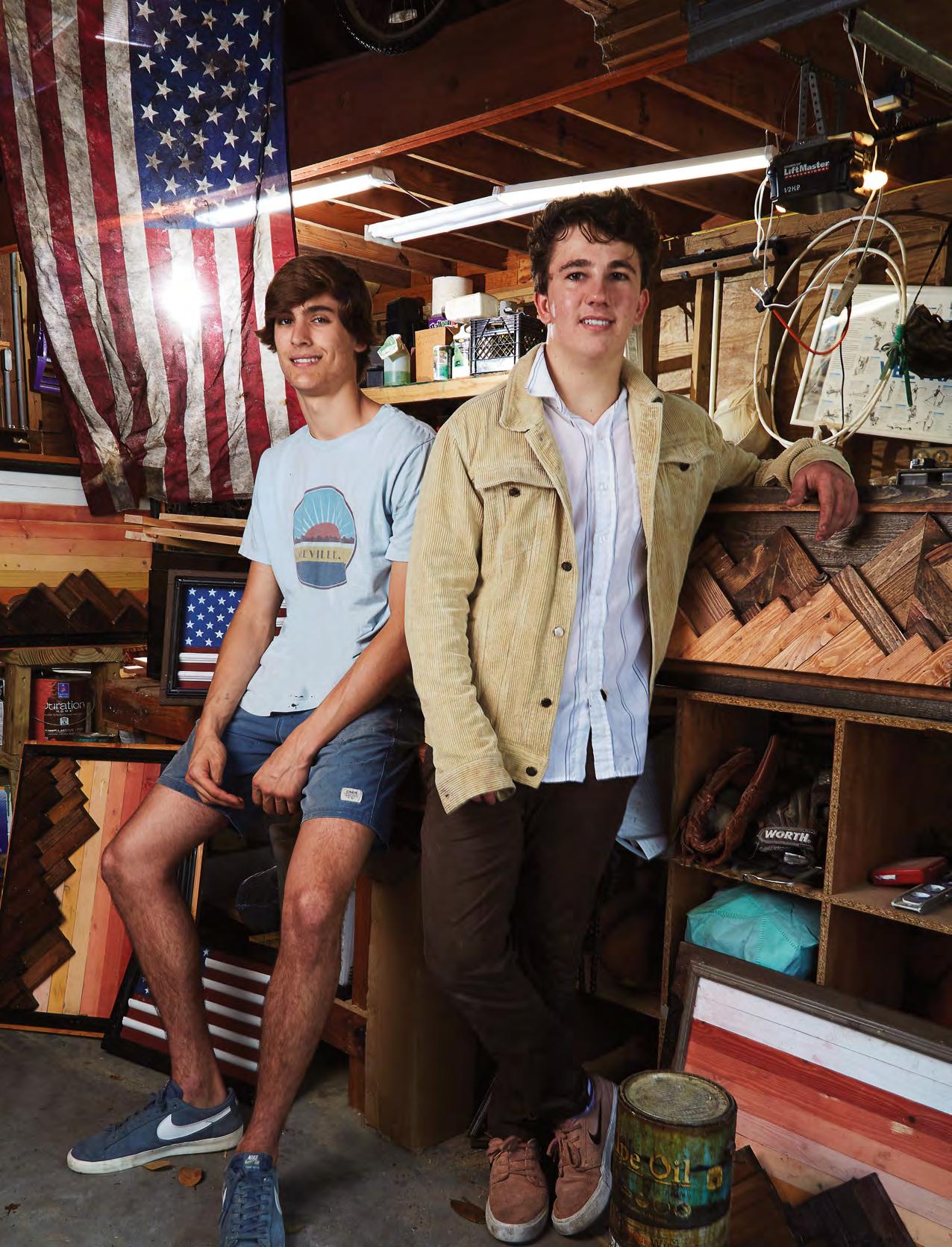
Wood studs of various lengths, as well as their accompanying aromas, spill out of William Rocco’s garage on Sullivan's Island. Just last summer, he and long-time friend and fellow islander, Brock Webb, transformed the building in his family’s backyard from toolshed to the manufacturing headquarters of their growing business: Rock & Brock Woodworks.
Webb and Rocco dabbled in woodworking prior to the COVID-19 outbreak primarily as a way to keep their hands busy. However, the onset of the pandemic presented an ideal opportunity for the industrious entrepreneurs to turn their hobby into a hustle. ese circumstances, along with a growing woodpile and a menagerie of drills, saws and “lots of nail guns,” set the Island boys’ business into motion.
Although the pandemic took a toll on many businesses across the board, it sparked a signi cant uptick in production and sales for these two artisans. “During that time last summer,” Webb explains, “we didn’t really go o the island, so we had a lot of time for woodworking.”
Rock & Brock Woodworks began with big projects. Tables, chairs —even a few neighborhood forts—were early testaments to their talent. When they began showing their work in local galleries, farmers’ markets and art shows, they learned it was their smaller creations—such as mountain landscapes set against a painted ombré sunset—that were the real moneymakers. “Our artwork started selling a lot more than the furniture,” Rocco says.
To meet the growing demand for their signature art pieces: large geometric arrows, American ags and mountain sunsets, the men started ne-tuning their production. “Honing in on what we’re good at and replicating it is a good way to make money,” Rocco explains, though he adds that the well-oiled system they’ve developed, which allows them to cut, stain and paint wood for multiple iterations of the same template simultaneously, has begun to feel repetitive, lackluster. With hundreds of creations now in the portfolio he shares with Webb, Rocco has realized that he enjoys having the exibility to try new things.
In their woodworking shop—a home o ce of sorts—mountain landscapes of varying dimensions and hues, as well as wood-paneled American ags of similarly staggered sizes, are propped up against corners and lined along Goodwill-sourced shelving. ese almost-but-not-quitenished works take up whatever space isn’t occupied by paints and stains, blueprints for some of their staple designs, goggles, pencils, power tools and, of course, more wood than you could shake a stick at. “We put stu where it’s convenient, not where it’s organized,” they say.
Rocco and Webb are artists of opportunity. ey learned the trade, Rocco says, “not through trial and error; it’s trial and success, and maybe an error.” “We never really started doing it for pro t; we just had a fun time when we started with the forts and people started liking our stu ,” Webb adds. Over the past few months, they’ve formed a habit of dedicating two to three hours a day to their trade, and sometimes a full day on the weekends. However, both are seniors in high school and plan to attend college in the fall. ey expect that the distance between them and the adjustment to college will cause their business to dwindle, though they agree they’ll keep their passion for woodworking in their back pockets, ready to pull out and dust o when time avails itself.
- Meghan Daniel“ It's trial and success, and maybe an error.

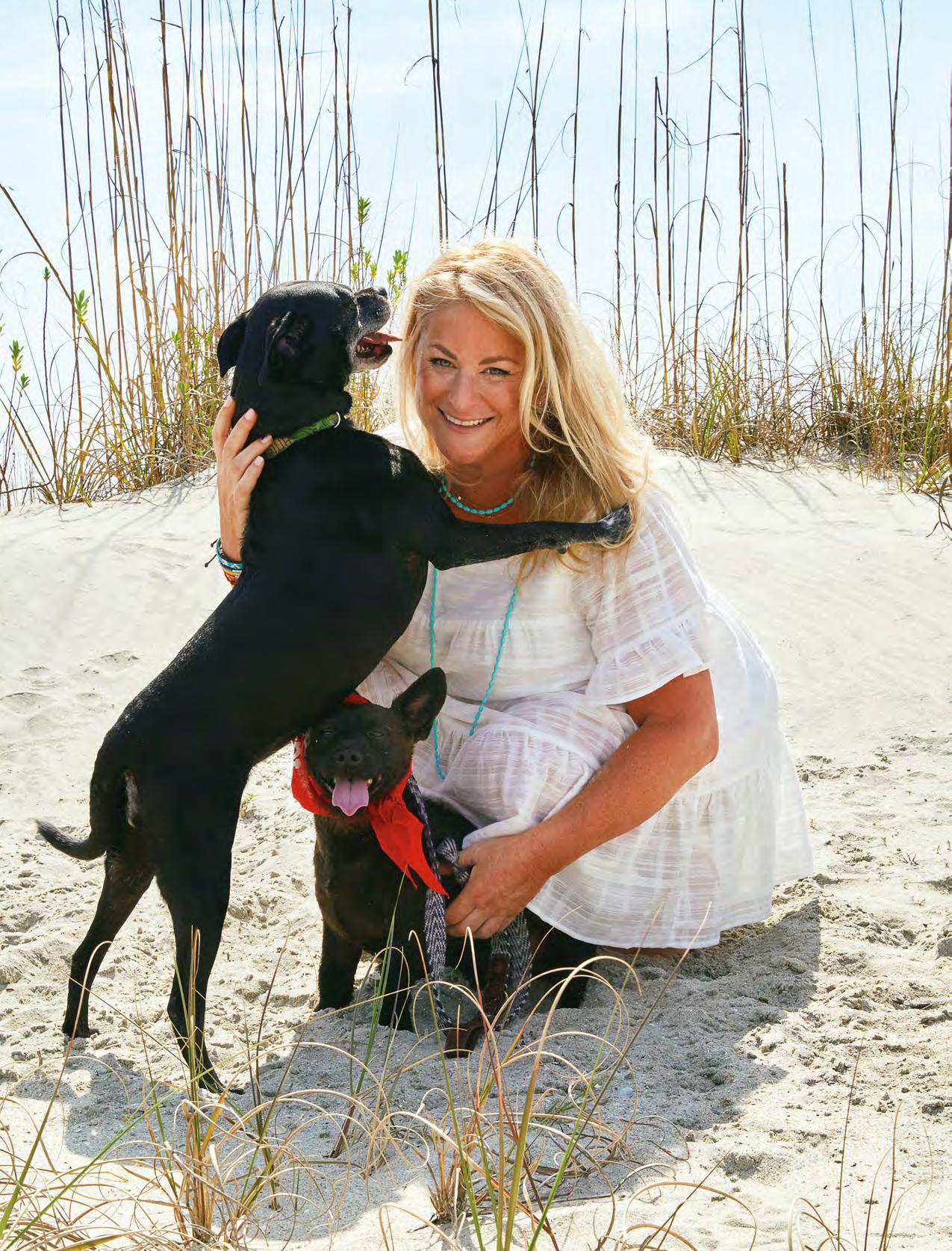
“Don’t come back here with any babies or any dogs,” Amy Scarella’s dad admonished when she moved back in with her parents prior to moving from Connecticut to Isle of Palms three years ago. Soon a er this reprimand, Scarella organized a doggy day care program that she operated out of her parents house and backyard. She says of this unforeseen series of events, “I couldn’t help it.”
Doggy day care marked Scarella’s foray into the world of caring for (wo)man’s best friend. While living in Connecticut, she logged countless volunteer hours with various dog rescue programs and developed an informal mentorship with a veteran of the eld who had organized a system that brought dogs up to Connecticut to be rehomed from other regions of the country, where they’d been discarded and dismissed. During this time, Scarella also became a regular foster parent for dogs in her area. She was hooked.
However, it was a Facebook post that really did her in. While perusing one of the online rescue pages, she came across a post about Hunter, a black dog that had been hit by a car. Hunter’s misfortune piqued Scarella’s interest and prompted her to make a phone call to coordinate the logistics of bringing him up to her neck of the woods to heal and nd an adoptive family. She recalls the person she spoke with being surprised when she expressed a desire to help Hunter: “Oh, you take black dogs?” they said, “Nobody takes black dogs.”
at fortuitous conversation brought Scarella up to speed on a phenomenon that’s been dubbed “black dog syndrome,” the result of a dangerous mix of ingrained superstition, subconscious associations between darker-colored dogs and aggression, and a lack of evident expressiveness—o en equated to personality—of black dogs when photographed in poorly-lit shelters.
Scarella founded Little Black Dog Rescue, the manifestation of her de ant stance against the perpetual problem that black dogs in shelters face in consequence of this syndrome: disproportionately being the last to be adopted and the rst to be euthanized.
Now, eight years later, Little Black Dog Rescue is nothing if not the epitome of a labor of love. “Rescue’s like the ma a,” says Scarella. “Once you’re in, you can’t get out.” As the founder and primary point-person for the program, she has continued to execute her commitment to rescuing last-chance black dogs since moving to Isle of Palms. In fact, although most of the dogs she nds are still transported to rescues she has partnered with in Connecticut, many come from neighboring coastal counties, the Upstate and the Pee Dee region of South Carolina. “I used to pull from these places when I was in Connecticut,” she explains, “Now living here, it’s fascinating to see where I’m actually pulling from.” Pups like Sadie, who came from a Berkeley shelter and was adopted by a woman who resides in Connecticut, even come to visit Scarella and her ve dogs on Isle of Palms.
Scarella says of her commitment to Little Black Dog Rescue: “It’s 23 out of the 24 hours a day. It’s exhausting. You miss out on a lot of life, but it’s kind of like what you signed up for without knowing. I’ve had to cancel stu because I had to pick up a dog from transport. You couldn’t pay anybody enough to do this. It just has to be something that you’re passionate about.”
In its inaugural year, Scarella’s program rescued 60 dogs. Now, she estimates that number has grown to 100 annually. Dogs who have come through her care now reside all over the country, as well as across the pond in England. When it comes to rescuing, fostering and volunteering to support shelters and rescue programs, her token of advice is: “You don’t have to do everything, but you can do something.”
- Meghan Daniel“

The main dish isn’t the only star of island restaurants. These sumptuous sides often steal the spotlight.
By Stephanie Burt Photos by Josie DerrickWith the outstanding views, excellent service, and magical main dishes at many of the restaurants on Isle of Palms and Sullivan’s Island, it could be easy to overlook the humble side items on its menus. But if you’ve ever had a soggy hushpuppy or a vegetable dish that perhaps spent more time in the microwave than on the chef’s mind, you understand how sides can make a meal lose its luster. Here, we spill some secrets about our favorite sides on the islands, and shine a spotlight on their unique charms. Next time you sit down to order, the memory-recall of our insider tips should start your mouth watering.
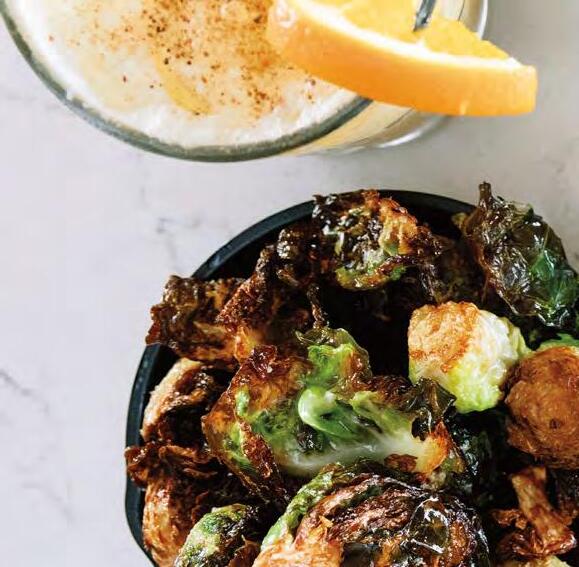

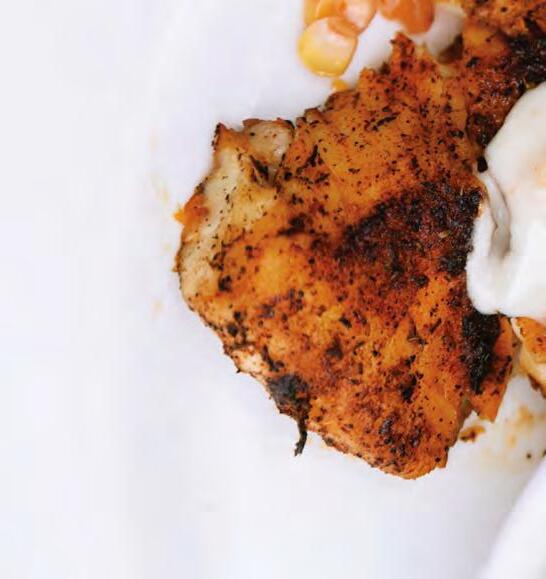


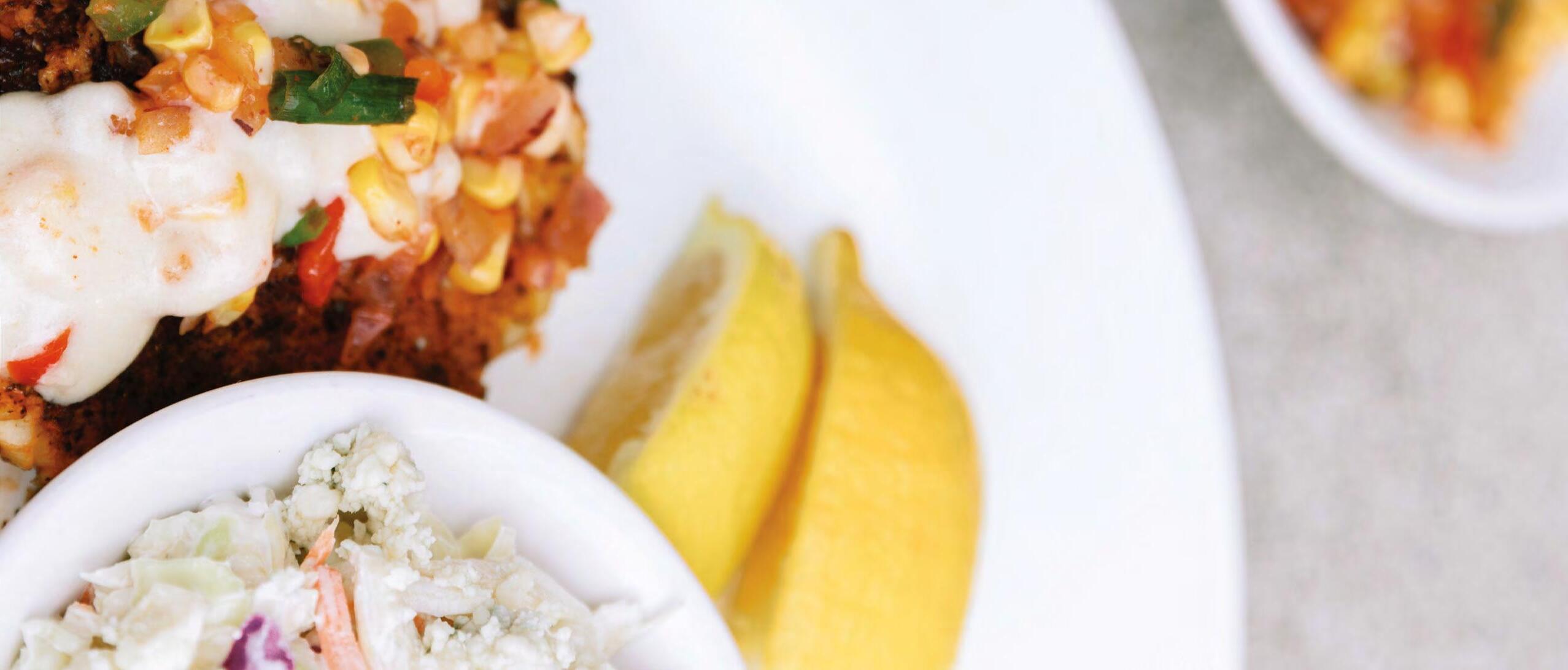
Open all day, Acme Lowcountry Kitchen is consistently rated as one of the top restaurants on Isle of Palms. It has a loyal local following not only because of time-tested classics, from fried seafood to multiple iterations of shrimp and grits, but also because of its laid back, neighborhood vibe that’s stayed the same as the Island has developed around it. Walk in a visitor and you’ll leave a local.
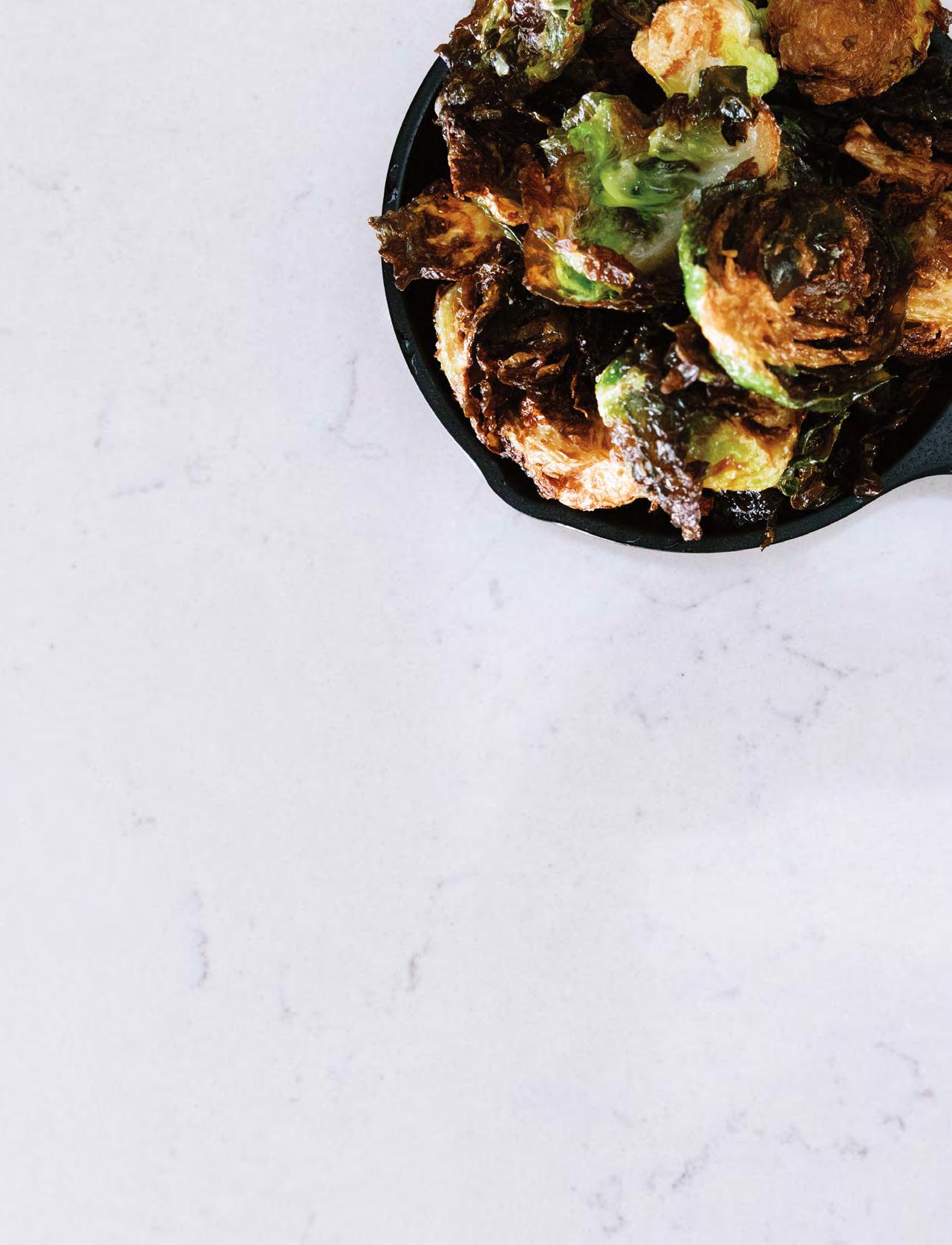
ese cruciferous veggies are given the Acme treatment with some sizzling cast iron. e leaves on the outside char in a delightful way, and lend avor to the whole dish, which reminds you that being green doesn’t have to be boring.
Pimento Grits
is side dish marries two Southern staples: pimento cheese and grits, in a way that even non-Southerners can appreciate. Pimento cheese is essentially a cheddar and pepper spread, and when it meets grits and comes to the table in the cutest cast iron skillet, it tastes as if it might have met its culinary soul mate.

Truffle Mac and Cheese
Crunchy on top with creamy, cheesy noodles underneath, this mac and cheese goes gourmet one step further by the addition of tru e oil. It’s an upgrade from the standard sides selections, but the amount of positive reviews online prove that it’s worth it, and we agree.
Although Wild Dunes Resort might be reservation only, Coastal Provisions restaurant is open to the public daily. Just tell the gate attendant that that’s where you’re headed when you arrive. e restaurant is tucked in by the graceful lines and cool blue of the pool at the Boardwalk Inn, where you can catch a breeze poolside or sit comfortably inside, all while enjoying a rotating selection of seafood and chops.

A menu item that debuted in 2019 and then disappeared, Blackened Street Corn is back this year in all its crispy kernel goodness. Fresh, cheesy, and with a healthy char and dash of lime, it’s already the most popular dish of the season.
Sure, it’s not the most picturesque of signature sides, but the bitter green meets salty pecorina knows it’s beautiful where it counts in the avor department. Roasted garlic, shallot, and a bit of butter round out the dish.
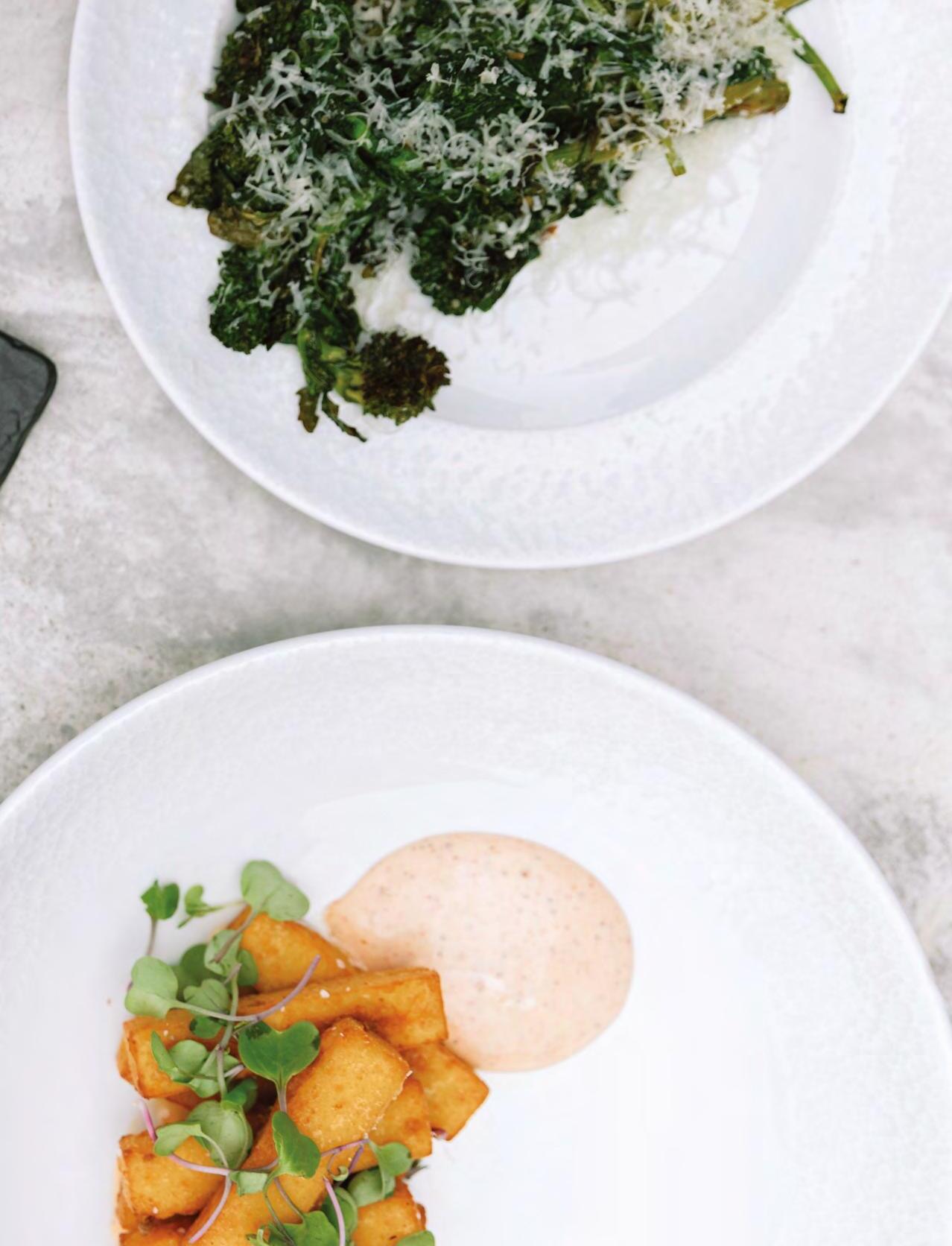
Technically termed a “panisse,” these crispy chickpea fries might hail from Provenance originally, but they speak with a Southern accent with a dip in Alabama white sauce. ey’re gluten-free but you don’t need to be to enjoy them.
Located on Breach Inlet in a setting made for sunset perfection, e Boathouse has been serving consistently delicious food since 1997. Its view of the Intercoastal Waterway as well as the breaking waves on the edge of Isle of Palms would be enough to attract diners, but the restaurant has built a consistent following through the years with its excellent interpretations and updates of Lowcountry classics. So much so that authors Douglas Bostick and Jason Davidson collected its recipes for e Boathouse: Tales and Recipes om a Southern Kitchen.

“Best Ever” Collard Greens e secret to the “best ever” collard greens is the addicting combination of sweet and spicy, in this case, the deep sweetness of a little brown sugar added to the pot along with a dash or two of hot sauce. What happens is the greens mellow and become silky and as a result they’ve been a staple of the menu for years.
With its location on the water, it’s easy to understand why seafood is such a focus at e Boathouse, and one of the traditional pairings for anything that swims (at least in the South) is coleslaw. e blue cheese version was created by founding chef Je Lanzaro, and admittedly these days there’s more than one cheesy coleslaw on the islands. But this is the taste that started the trend, and the combo of sharp cheese and creamy cabbage pair well with anything fried, grilled, or steamed. SiP SiP






Five island bartenders reveal the best beachside booze this season.
By Margaret Pilarski Photos by Minette HandHeat, humidity, sandy feet and a bit of sweat on your brow. Looking for the antidote? Find your nearest bartender’s salve: a gorgeous glass of something strong, refreshing, and slightly sweet or pleasingly tart. Nothing cuts the searing heat of the summer sun like the ice-cold rst sip of a crushable cocktail. is year, SiP makes the rounds across the islands to determine the very best sips to get your night (or a ernoon, let’s be honest) o to a delightful start. Five island locales serve up their nest summer cocktails and guide us through the ideal sipping experience.


is year at Wild Dunes, Christopher Okerlund has his hands full. With a new hotel (and its new bar spaces) opening, the former bartender and now restaurant supervisor is making sure every sipping experience is at its peak. At Coastal Provisions, that means revisiting the cocktail menu seasonally and collaborating with the bartenders to nd creative takes on new classics. One drink that debuted last summer and is being revived again this year thanks to its runaway success is the Palmgren Paloma. Created by bartender Corban Palmgren, who was in a car accident earlier this year, the drink’s return is an homage to his creative spirit.
“It’s a spin on a classic paloma,” says Okerlund, “we use reposado tequila, lime juice, a little agave and grapefruit juice, but we also add some grapefruit bitters and some pamplemousse [liqueur], so it gives it more bite than your typical sweet paloma. It has a really refreshing but complex avor. Usually if you buy one of them you end up getting a few.”
While it’s especially great sipped out by the pool, Okerlund says the Palmgren Paloma isn’t your typical down-the-hatch summer drink. “It could be appreciated by somebody that’s looking to have a good time and get something that’s di erent than their typical margarita. Somebody who is a serious cra cocktail acionado would still appreciate this as well and would be able to pick up on those subtle notes in there.”
Count us in either way.

Over on Isle of Palms’ Front Beach is Binky’s, the self-proclaimed “upscale dive bar” where chef Ken Vedrinski still hangs his apron. Here manager Kevin Ferrin keeps up with the kitchen by slinging eye-catching and mouth watering drinks like the I’ve Got a Crush on Isle of Palms cocktail. Invented last year at the behest of a regular looking for something new, Ferrin poured a creation made up of Ketel One Oranje, aperol, freshly squeezed sour mix and a touch of Sprite – and the drink became a sensation.
“It’s very crisp, summery, it screams poolside or beachside,” says Ferrin, who recommends you grab a seat at the oceanfront bar and add some oysters or local peel-and-eat shrimp to your order. While it’s an easy rst sip, Ferrin promises it’s surprisingly strong.
Looking for a di erent avor pro le for your second drink? Ferrin’s bar runs the gamut. “I’m really into bourbon so I have a really, really good bourbon selection. I also do a couple di erent frozen drinks. People come o the beach crazy for that stu .”
Binky’s is going strong a er a rough rst year—they opened right before Covid-19 hit but the team has had zero attrition in their rst year. “It’s gonna be a crazy summer, I’m just looking forward to it,” says Ferrin, “I’m grateful that we’re still kicking. We’re pumped.”
In 2017, 26 other Charleston restaurants faced an uphill battle when they competed against Mex 1’s winning Baja Tanga in the Charleston Margarita Festival. Since then, it’s been a fan favorite thanks to its exclusive, intentional seasonal availability, says Mex 1’s Morgan Hurley.
“I love watermelon in the summertime and knew I wanted to make a watermelon margarita one day,” says Hurley. “One night it just hit me to use rosé wine in the cocktail. Tequila is naturally bright and citrusy and when you combine that with the sweetness of the watermelon and the dry and slightly fruity nature of rosé, it just became a avor powerhouse.”
For Hurley, tequila is much bigger than the drink in your hand. “I’ve always been an avid learner, and the thing I liked about the tequila side was that once I started jumping in I found it’s a whole world of history and technique.” Hurley has since been to Mexico multiple times to learn from the masters. While there, he tastes and buys barrels of tequila—tasting barrels for their subtle di erences and then calling dibs on the contents so that particular barrels’ bottles are shipped straight to Mex 1. at’s why every signature cocktail on the Sullivan’s Island menu features a 100 percent agave tequila chosen speci cally, o en infused with fresh fruit—calling cards Hurley says you can count on no matter what drink you ultimately choose. “Our bar program ultimately is about all 100 percent agave tequilas, killer margaritas, infused tequilas and the most sustainable tequila list in town,” he says.
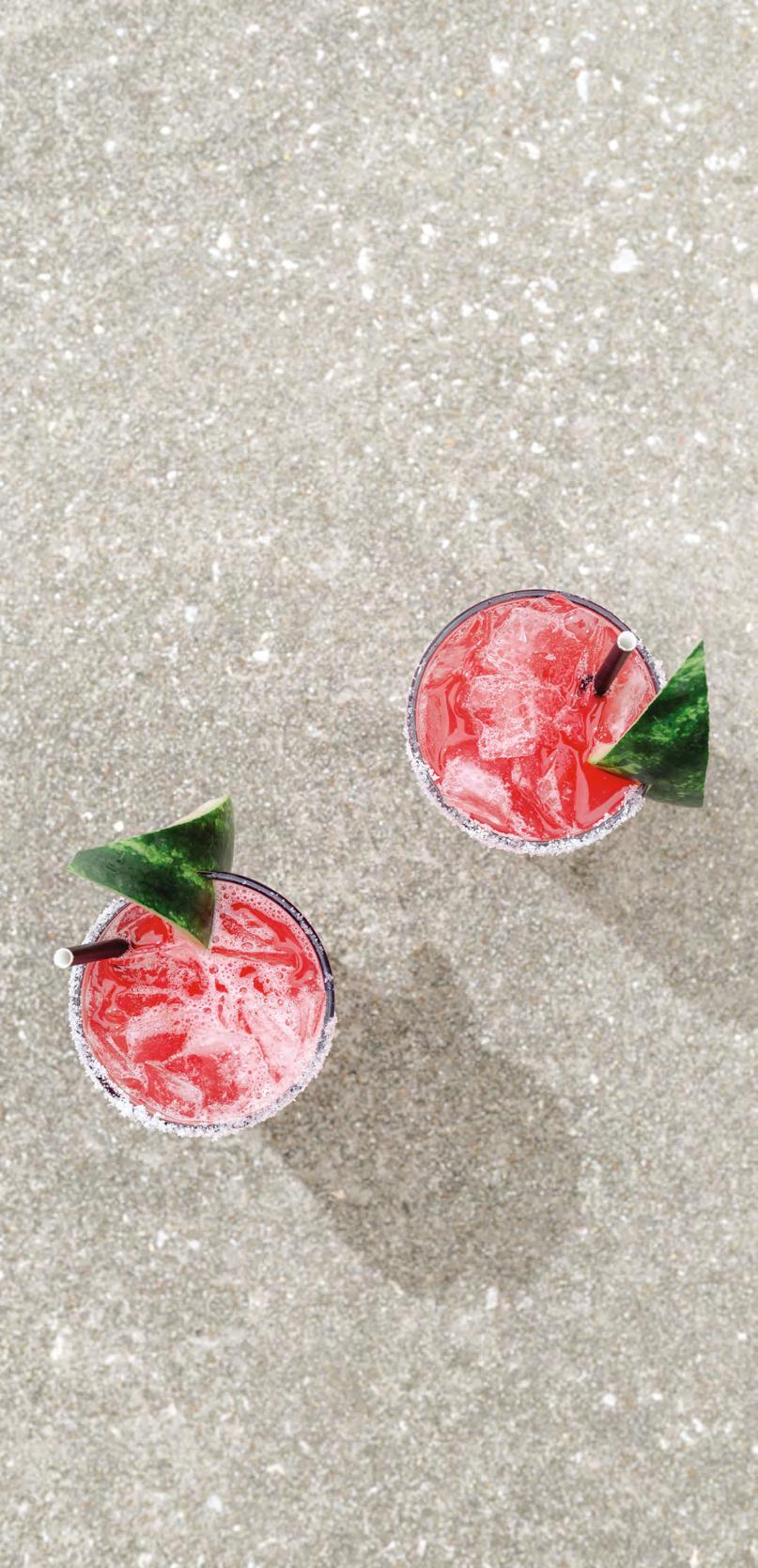

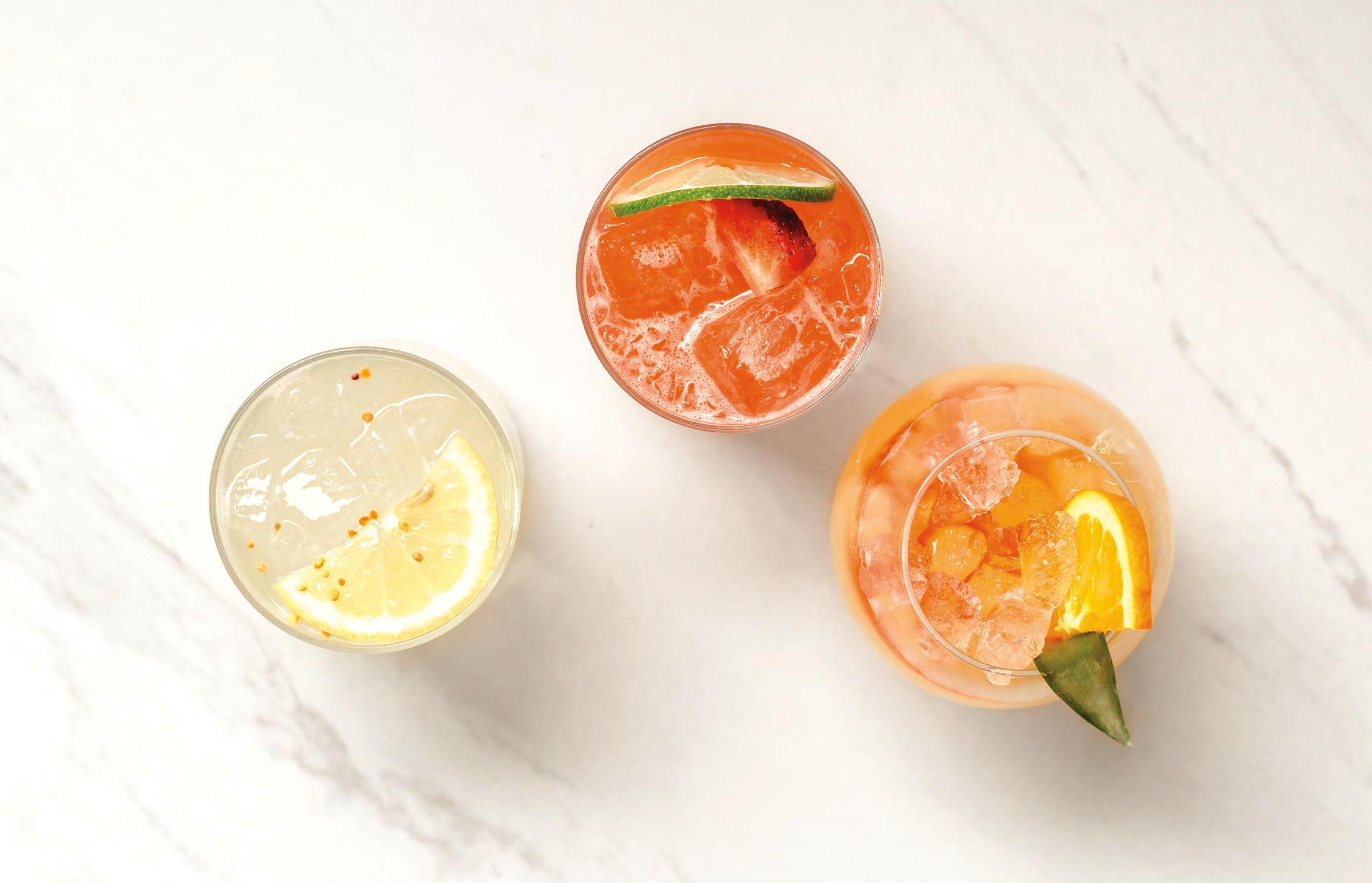
At Home Team BBQ, the bar and the kitchen philosophies sync up pretty neatly says Adam Rothstein, the restaurant’s ops director who also oversees the bar program. “Drinks should be fun, they should taste good, and they should have some intention and thought behind it,” he says. “We draw from similar in uences and approaches behind the bar that we do in the kitchen, and try not to take ourselves too seriously while putting out quality drinks that make sense.”
at was the philosophy from which the Snake In the Grass sprung forth, a cocktail developed by Anna Lazaridis on the restaurant’s downtown team and added to the Sullivan’s Island locales’ line-up. “It’s a tequila cocktail that’s in touch with its inner margarita but without the expected ingredients and trappings,” says Rothstein. e Snake In the Grass is built on a base of blanco tequila and the herby liqueur Génépy des Alpes, paired with Fresno chile, lemongrass, lemon and mint.
For Rothstein and his team, it was important to make sure drinks translated between locations and across the restaurant’s menu. “We worked to create a core cocktail menu that was approachable, interesting, fun and crushable. is cocktail is a great example of that, balancing some citrusy herbal notes from the lemongrass and Génépy des Alpes against Fresno chile, fresh lemon juice, and Lunazul blanco tequila.” Rothstein swears it pairs well with everything on the menu, so order with unabashed gusto.
No matter your mood, Obstinate Daughter’s Frank Arevalo has a drink with your name on it. New to e OD or starting your night out slowly? Try a sip of King’s Honey, the spritzy, summery, vodka-based cocktail that’s been on tap almost since day one. Local Highwire Vodka and Cannonborough Beverage Co. Honey Basil soda pair with St. Germain and lemon, “It’s so refreshing, it’s like an adult lemonade with a little bee pollen as a garnish,” says Arevalo. “It sells like hotcakes. Probably the best at two o’clock in the a ernoon, a er you get o the beach.”
Arevalo’s hyper-seasonal recommendation is the margarita, which changes ingredients based on what’s available from local farmers. Pictured is an Ambrose Family Farm strawberries and Agavales blanco tequila combo with a bright pop from cucumber water, a hint of heat from Fresno pepper, and the house margarita mix, a tart Key lime concoction. “It’s really balanced,” says Arevalo. “Nothing’s worse than a sweet margarita.” At the height of summer, Arevalo switches from strawberries to peaches and reformulate the recipe to compliment the seasonal bounty. In cooler seasons you might see blood orange or cranberry-based tipples.
Smooth Sailing, the restaurant’s rum punch is his go too for the undecided. Five-year rum, Velvet falernum, banana liqueur, a touch of sour mix and a dash of orange and grapefruit juices round out Smooth Sailing’s tartness. Plus, bitters, pineapple leaf and an orange wedge decorate its nal sni er glass presentation. “I like to say it’s a vacation in a glass,” says Arevalo. “When people come to the restaurant, they’re coming to escape reality and that cocktail helps.” Home


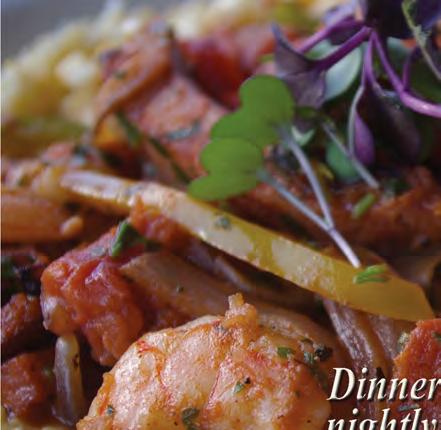



Local musician Marci Shore takes a tour through Isle of Palms’ and Sullivan’s Island’s live music hotspots to bring you the lowdown on the vibes and vocals to be found on the sea islands this season.
Photo by Jesse McCanncoconutjoes.biz, 1120 Ocean Blvd., Isle of Palms, SC, 843.886.0046
Vibe If your vibe is all about the “view,” then Joe’s is your spot. In its 24th year, this beachside bar serves up breakfast, lunch, and dinner. Sip the signature drink, the Parrot Colada—a frozen piña colada topped with strawberries, whipped cream and toasted coconut, while watching the shimmering horizon, cargo ships rolling in, and beach revelers boogie boarding.
Vocals Joe’s has always been known for its rooftop summer music series, and this year the live calendar is fully booked Wednesday through Saturday nights, and midday on Sundays. There’s also a new beachside bar, Colada Swings, with hammocks and live music midday on Saturdays.
dinghyiop.com, 8 J C Long Blvd., Isle of Palms, SC, 843.242.8310
Vibe The Dinghy is the closest thing to Key West the islands have to offer. Walk in with your sandy flip flops on and feel right at home. Fried gator bites served with chipotle sauce and ‘Dirty Elvis Bites’ featuring sweet potato fries topped with warm peanut butter, bacon, and plantains are two of the more intriguing appetizers. Put on your beer drinking hat at The Dinghy, and try one of the interesting local craft beers on tap.
Vocals Live Music on the patio, 6 days a week (not on Wednesday) features a mix of acoustic folk/country, and rock from 7-10. Check the online music calendar.
papisiop.com, 1012 Ocean Blvd, Isle of Palms, SC, 843.926.7274
Vibe Co-owned by country music songwriter Wyatt Durrette, Papi’s further claim to fame is its self-professed “best tacos in Charleston.” Craft cocktails, a rooftop bar, and locally sourced ingredients add to the star power of this fairly new kid on the block, in its third season. You can’t go wrong ordering the Big Papi Margarita and the Mexican Street Corn appetizer for starters.
Vocals The restaurant features a “Pop Up” Songwriters Series. Announced 48 hours before shows, follow Papi’s social media to get the latest announcements. Most performers are Nashville songwriters.
therefugeiop.com, 1517 Palm Bvld. Isle of Palms, SC, 843.242.8934
Vibe Dress up or come as you are to partake in gourmet fare at reasonable prices. Grab an espresso or muffin for breakfast at the coffee bar or even do a little work on your laptop in the breakfast nook. For lunch or dinner, the crab delight is a ‘go to’ appetizer featuring a miniature crab cake atop an avocado, tomato, bacon, and blue cheese salad. Boasting an array of bourbon selections, The Refuge’s Old Fashioned is its Signature Drink.
Vocals Live music includes some brunches and evenings. Check the website for updates throughout the season. Indoor and outdoor eating is available.
the-windjammer.com, 1008 Ocean Blvd, Isle of Palms, SC 29451, 843.886.8596
Vibes The ‘Jammer has survived hurricanes, 48 summers, and now a pandemic.
A true beach club, with volleyball, bikini contests, and ocean views, you might feel inclined to skip your usual cocktail, and crack open an ice cold Pabst Blue Ribbon instead, and order the chili and fried pickles for some pre-game comfort food.
Vocals A full summer of music is scheduled for both the indoor stage and for the airy, beachfront Bud Light Seltzer Stage. Acts scheduled for this summer include Mt Joy, Zoso, Muscadine Bloodline, Futurebirds, Weird Science, Drew Parker, Corey Smith, Drivin N Cryin, Atlas Road Crew, Patrick Davis and His Midnight Choir, Chris Knight, Cracker, Five Way Friday, Stop Light Observations, Red NOT Chili Peppers, and Cowboy Mouth. Check the website for the calendar. The plan is to keep the shows at 50 percent capacity.
dunleavysonsullivans.com 2213 Middle St, Sullivan's Island, SC, 843.883.9646
Vibe Celebrating 29 years, the family-owned Irish bar on the corner of Middle Street has a ‘come as you are,’ laid-back vibe. Belly up to the bar and stay all day to see the rotating cast of locals that consider the pub to be their ‘home’ bar. Owner Bill Dunleavy says the signature appetizer is the grilled wings—“never frozen, never fried.” The signature drink is, of course, “A proper Imperial pint of Guinness.”
Vocals Vintage Country Music night is back the first Tuesday of every month in 2021. Hosted by Carroll Brown, there will be mandolins, fiddles, banjos, and plenty of vintage tunes that carry on until midnight sometimes. Seats fill up early, so arrive by 7 p.m. for a good spot.
hometeambbq.com, 2209 Middle St., Sullivan's Island, SC, 843.883.3131
Vibes Award-winning barbecue restaurant, Home Team’s BBQ Nachos really pile it on, with pulled pork, chicken, or black beans, shredded cheeses, pickled jalapenos and guacamole, in this signature app large enough to feed two. The Gamechanger frozen concoction is a blend of rums, pineapple and orange juice, toasted coconut with a dash of nutmeg, and does not disappoint.
Vocals Home Team has been host to some national acts in recent years, packing in shoulder-to-shoulder crowds for late night summer concerts. Concerts haven’t been ruled out for this season, but as of printing nothing has been confirmed.
mex1coastalcantina.com/sullivans-island, 2205 Middle St, Sullivan's Island, SC, 843.882.8172
Vibe You can almost imagine you’re in a Carribean or Keys surf bar at Mex 1 with its colorful decor, and videos of surfing competitions playing above the bar. The ‘Bangin’ Shrimp Taco’ is one of the most popular appetizers, and the Habanero Margarita (infused in-house) will spice up your night. Outdoor dining is offered in the screened-in porch overlooking Middle Street.
Vocals Live music is back every other Saturday. Bands range from rock n’ roll, pop covers and DJ sets, and will feature some of Charleston’s best groups.
Editor’s Note: All band appearances were con rmed prior to the press date of the magazine. However, due to COVID-19 all details are subject to change.



EVENTS
Lifeguarded Beaches
Isle of Palms County Park is lifeguarded on weekends beginning in May from 10 a.m. to 6 p.m. Beginning June 21, the lifeguards are on duty every day through mid-August and weekends August 15 through the last weekend in September.
Mount Pleasant Farmers’ Market
Discover South Carolina-grown produce and local food vendors while enjoying live music. Tuesdays, 3:30 p.m. to 7 p.m., April through September on Coleman Boulevard, next to Moultrie Middle School. ExperienceMountPleasant.com
IOP Farmers Market
Enjoy local produce and arts and crafts, every Thursday, 3 p.m. to 7 p.m. September through October. location TBD. iop.net
MAY 2021
Semi-Annual Men’s Club BBQ
The First United Methodist Church’s Men’s Club on IOP offers a drive-thru BBQ—of pulled pork, baked beans, slaw, pickles, and drink, in addition to homemade desserts, for $10 a ticket. Funds benefit local charities. First United Methodist Church, Saturday, May 1. 11 a.m. to 4 p.m. iopmethodist.com
Spoleto Festival
The annual arts festival returns for its 45th season. The two week event will be held at venues around Charleston in a reduced capacity with limited seating. There will be virtual programs, as well. Spoletousa.org, 843.579.3100
2021
Floppin’ Flounder 5K Run/Walk
This community-wide group run hosted by the Charleston Running Club has had a faithful following for more than 25 years. It takes place Saturday, June 5 at 8 a.m. and starts in front of the Sullivan’s Island Fish Fry Shack, 1459 Hennessy St. Registration is $25. floppinflounder.com
Piccolo Spoleto Sand Sculpting Contest
June 5 at 9 a.m. head to the beach at IOP County Park for a stunning display of sandsculpting prowess. The event is part of the Piccolo Spoleto Festival, which runs May 24 through June 9. piccolospoleto.com
Carolina Day Recognition
Battery Gadsden Cultural Center’s annual Carolina Day recognition is June 25, at 9 a.m. on the plaza in front of Sullivan’s Island Town Hall. Speakers will be followed by raising of the Moultrie flag. BatteryGadsden.com.
Battle of Sullivans Island Musket & Artillery Demonstrations
Fort Moultrie National Historical Park observes the 245th anniversary of the Battle
of Sullivans Island, known locally as Carolina Day, on June 26 and 27. Revolutionary War artillery and musket demonstrations will take place on both days, from 10 a.m. to 3 p.m. nps.gov/fosu
JULY 2021
4th of July Golf Cart/Bicycle Parade
Deck out your golf cart or bicycle for this annual parade celebrating America’s independence. Start at the Sullivan’s Island Elementary School, end at Stith Park. Meet at SI Elementary, parade begins at 9 a.m. and proceeds to the Fish Fry Shack.
Wild Dunes Family Fun Run/Walk
This beachside jog is held July 4 at 8 a.m. $25 per person, including t-shirt. Preregistration required: 843.886.7008
Isle of Palms Beach Run
On July 31 choose from a Youth Fun Run, 5K or 10K run, or a 5K walk on the beach. Start at The Windjammer, 1008 Ocean Blvd. at 8 a.m. Registration closes July 28. Race day registration and packet pick-up begin at 7 a.m; race starts at 8 a.m. iop.net/recreation, 843.886.8294, raceroster.com
AUGUST 2021
Half Rubber Tournament
This annual tournament takes place at IOP Recreation Center on August 21. Register by August 13. Call Aaron Sweet 843.886.8294 or email asweet@iop.net. Three and 4 person teams, $25 per person. Check In/ Captain’s Meeting at 7:30 a.m., games begin at 8 a.m. halfrubber.com
SEPTEMBER 2021
IOP Community Wellness Fair
On September 17 the IOP Recreation Department teams up with the East Cooper Medical Center to offer flu shots and blood work for local residents including cholesterol screenings and lipid profiles at the Recreation Center, 24 28th Ave. iop.net/ recreation, 843.884.7031
44th Annual Cooper River Bridge Run
The annual run across the Ravenel Bridge has been rescheduled to September 25. A world-class 10K foot race that begins in Mt. Pleasant and ends in downtown Charleston. bridgerun.com
Sandpiper Gallery Palooza
Sullivan’s Island’s only art gallery celebrates 20 years in buiness with a month-long event. Sandpipergallery.net
OCTOBER 2021
Isle of Palms Connector Run & Walk Fundraiser for the IOP’ Exchange Club’s programs for the healing and prevention of child abuse takes place in early October, IOP Connector, 8 a.m. Registration is $35 or $40 on the day of the race. ioprun.com
Fire Prevention Celebration
Look for a SI/IOP parade of engines in October at Sullivan’s Island Fire House, 2050 Middle St., Sullivan’s Island.
Ghostly Tide Tales
Bring a blanket, flashlight, chairs, and friends for spooky stories by bonfire light on the beach at Isle of Palms, 28th Ave. Free. October 15, 6:30 p.m., iop.net/recreation
IOP Halloween Golf Cart Parade and Drive-Thru Haunted House
Held on October 30, the parade starts at 4 p.m., line-up at 3:30 p.m. at 27th Avenue. You must pre-register at the IOP Recreation Department, 24 28th Avenue. iop.net/ recreation, 843.886.8294
October Nights at Battery Gadsden
PURE Theatre presents “Constellations” by Nick Payne in partnership with Battery Gadsden Cultural Center. The production will be part of a series of live, outdoor performances in the unique setting of the Cultural Center on Sullivan’s Island. 843.723.4444 or info@puretheatre.org
2021
Art on the Beach / Chefs in the Kitchen
The annual fundraising event for Charleston Pro Bono Legal Services plans to return this November. Tour Sullivan’s Island homes, see art from local artists and eat dishes prepared by Charleston Chefs. Charlestonprobono. org/artonthebeach
Birds of Prey Photography Day
The Center for Birds of Prey in Awendaw hosts this 4-hour programs for unfettered photography of nearly 15 species of birds of prey from around the world. November 14, 8:30 a.m. to 12:30 p.m. cost $75, visit thecenterforbirdsofprey.org
IOP Holiday Drive-Thru Festival Drive through Front Beach on Saturday, December 4 , 6 to 7 p.m., and enjoy the 25’ Christmas tree, lighted palm trees and holiday displays. Elves will greet each vehicle at the tree with a bag of candy and collect letters to Santa Claus. Santa will be there too, waving as you drive by. iop.net/holiday-street-festival
Sullivan’s Island Holiday Fireworks
Light up the night at Sullivan’s Island Stith Park, 2050 Middle St. on December 3. Enjoy fireworks and the lighting of the town holiday lights. sullivansisland-sc.com
Owls By Moonlight
The Center for Birds of Prey in Awendaw hosts an evening in the nocturnal world of owls on December 9. This program includes a reception with refreshments and experiences with nearly 14 different species of owls. Masks are required, limited to 50 guests. $75, thecenterforbirdsofprey.org
JANUARY 2022
Dunleavy’s Polar Bear Plunge “We’re freezin’ for a reason.” Jump into the chilly waters of the Atlantic on January 1. Meet at 2213 Middle St. Sullivan’s Island at 2 p.m. dunleaveyspubpolarplunge.com, 843.795.5316
Charlie Post Classic 15K/5K
The Charleston Running Club hosts the 37th annual Charlie Post Classic 15K & 5K in late January. The race starts at 8:30 a.m. in front of the Sullivan’s Island Fire Department, 2050 Middle St. charlestonrunningclub.com
FEBRUARY 2022
Doggie Days
Bring your pooch to the IOP Rec Center for some pampering and petting at the City’s hugely successful annual Doggie Days event. Get your pup vaccinated and show him/her off at the Dog Show for a yappy-fun day out. Early-February, check iop.net/doggie-daysat-the-rec for exact date.
Southeastern Wildlife Expo
SEWE is a three-day showcase of everything we love about wildlife, nature and artistic representations of them. Various locations, February 17 through 20. sewe.com
MARCH 2022
Front Beach Fest
Look for this annual party on IOP’s Front Beach celebrating the start of the season with local musicians, food vendors, jump castles, and other entertainment. Free admission. iop.net, 843.886.8294
St. Patrick’s Day Party in the Park
The Town of Sullivan’s Island hosts a familyfriendly event starting at 10 a.m. till 12 p.m. on Saturday, March 19 at Stith Park on Middle Street. sullivansisland-sc.com
APRIL 2022
SI Farmers’ Market
The Sullivan’s Island Farmers’ Market returns in April, 2022, running through June. Enjoy local produce and arts and crafts in Stith Park, 2050 Middle St. sullivansisland.sc.gov
Isle of Palms Annual Yard Sale
Residents of IOP sell their gently used items in an island-wide yard sale at the IOP Rec Center in mid-April. iop.net or call 843.886.8294.
Isle of Palms Easter Egg Hunt
April 17, hunt eggs and get your photo with the Easter Bunny at 10 a.m. sharp. IOP Rec Center, 24 28th Ave. Free iop.net/recreation.
Isle of Palms Exchange Club Easter
Sunrise Breakfast
Enjoy homemade breakfast courtesy of the Exchange Club members for free April 17 from 6:50 a.m. to 10 a.m. Easter morning at the Exchange Club, 201 Palm Blvd.


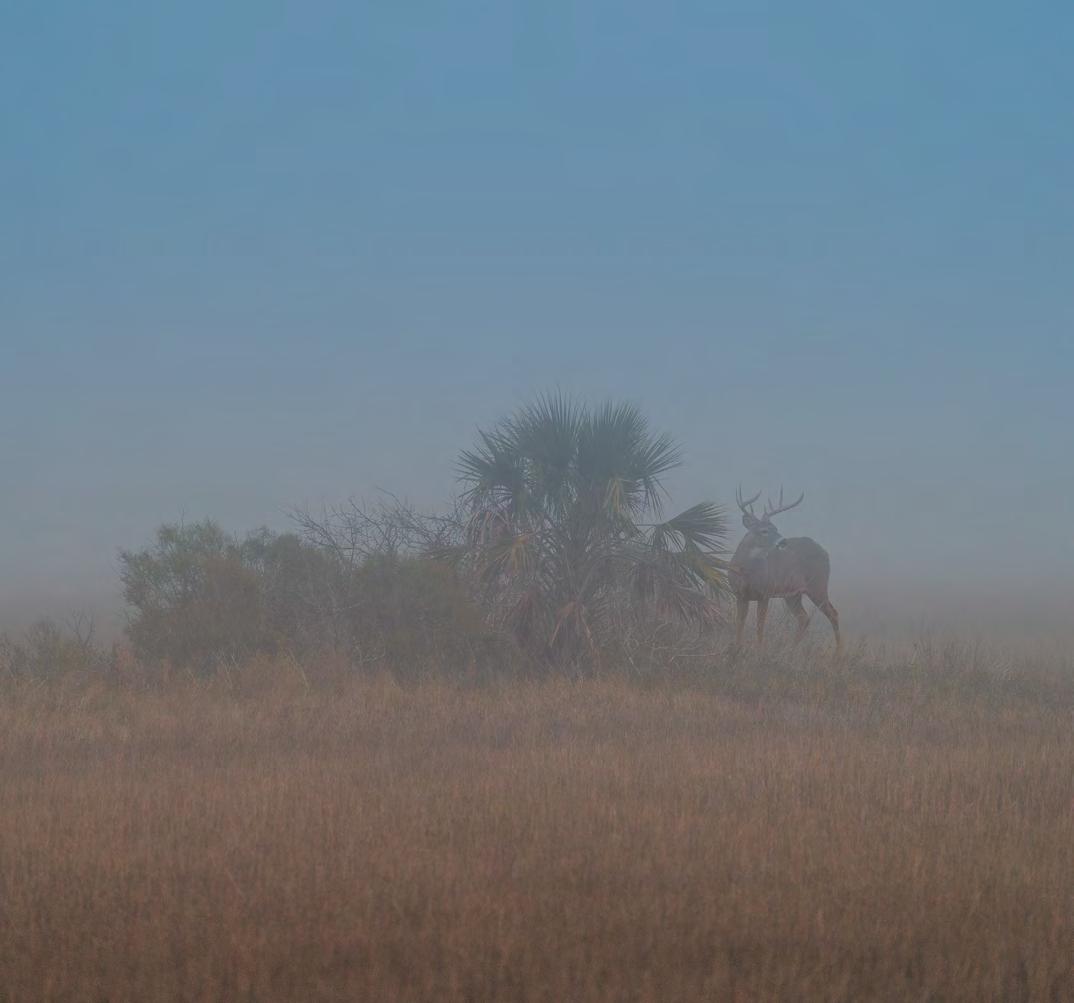
Deep into that darkness peering, long I stood there wondering, fearing, Doubting, dreaming dreams no mortals ever dared to dream before; But the silence was unbroken, and the stillness gave no token, — Edgar Allan Poe, The Raven

